Paul van Yperen's Blog, page 178
November 13, 2020
Produced by Rudolf Meyer
On the second day of Cinefest, EFSP presents Rudolf Meyer (1901-1969). During the 1930s and 1950, this German-born producer and film distributor produced several light-hearted entertainment films in the Netherlands. He worked together with such directors as Hermann Kosterlitz (Henry Koster), Ludwig Berger, Karel (Carl) Lamač, and Friedrich (Fredric) Zelnik, who also had fled Nazi-Germany. Later he worked with Paul Rotha and the Dutch directors Bert Haanstra and Kees Brusse. At Cinefest, four of Meyer's productions De kribbebijter/The Cross-Patch (1935), Pygmalion (Ludwig Berger, 1937), De spooktrein/The Ghost Train (1939), and Ergens in Nederland/Somewhere in the Netherlands (1940) will be presented.
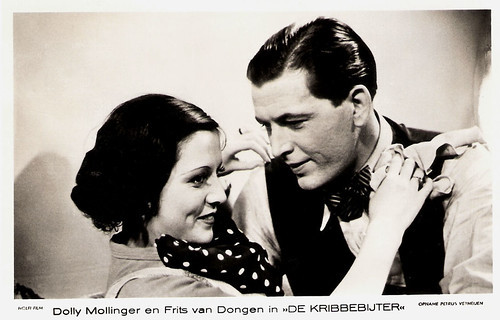
Dutch postcard by M. B. & Z. Photo: Petrus Verheijen / Holfi-Film. Dolly Mollinger and Frits van Dongen in De Kribbebijter/The Cross-Patch (Hermann Kosterlitz a.k.a. Henry Koster, 1935).
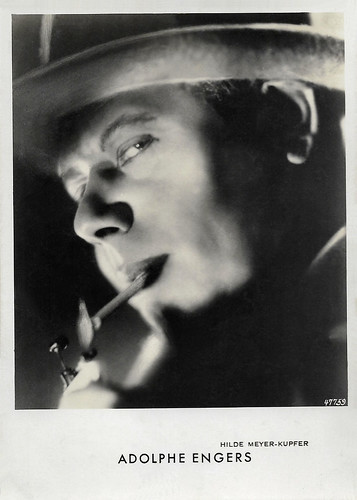
Dutch postcard, no. 47759. Photo: Hilde Meyer-Kupfer. Adolphe Engers .
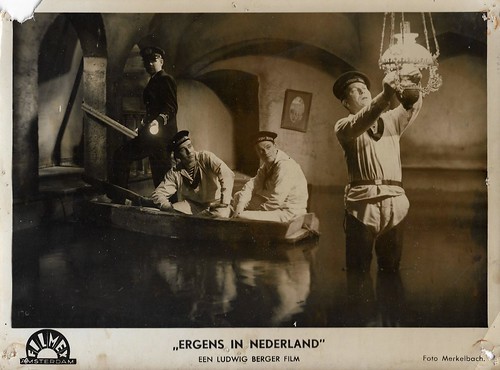
Dutch film still for Ergens in Nederland (Ludwig Berger, 1940). Photo: Merkelbach / Filmex. The two soldiers in the boat are Jan de Hartog and probably Max Croiset. The man on the right is Matthieu van Eysden.
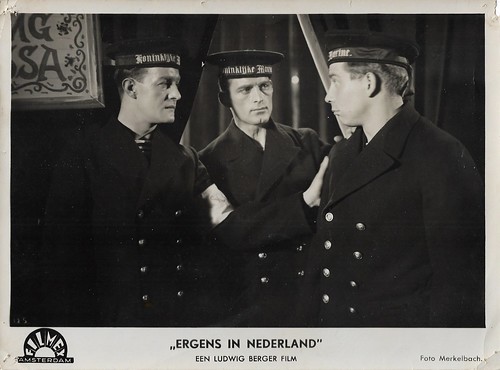
Dutch film still for Ergens in Nederland (Ludwig Berger, 1940). Photo: Merkelbach / Filmex. The man on the right is Jan de Hartog.
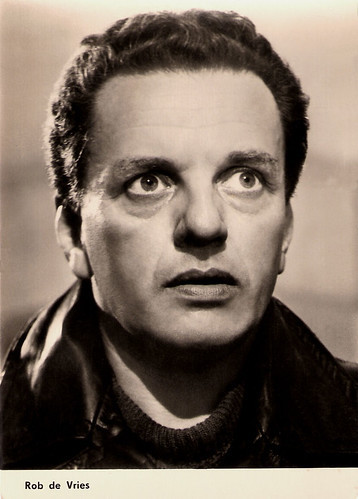
East-German postcard by VEB Progress Film-Vertrieb, Berlin, no. 2010, 1964. Retail price: 0,20 DM. Photo: Rob de Vries in De Overval/The Silent Raid (Paul Rotha, 1962).
A Dutch film par excellence for the first time
Rudolf (Rudi) Meyer was born in 1901 in Suhl, Germany. In the 1920s, he started his career in the film business through his uncle Erich Pommer, who was then head of the production at Decla. Rudi held various positions in the sector and in the early 1930s, he was the head of the export department of the Berlin production company Aafa Film A.G. of producer Gabriel Levy.
National Socialism in Germany drove the Jew Meyer out of the country in 1933. Jo Paerl, Aafa's Dutch representative, invited him to come to the Netherlands. Meyer and Levy worked for the Universal Film Agency in Amsterdam, which concentrated on buying Dutch, Belgian and French films.
At IMDb , Meyer’s first credit is as a production manager for the Belgian comedy, De wonderdokter/The Miracle Doctor (Jan Vanderheyden, 1936), starring Jan Cammans.
However, in 1934 Meyer had already started with Jo Pearl and Gabriel Levy the production company Holfi-Film (Hollandsche Film Productie). Their first production was the Dutch romantic comedy De kribbebijter/The Cross-Patch (1935) about a secretary ( Dolly Mollinger ) and the disinherited son ( Frits van Dongen a.k.a. Philip Dorn) of a sour baron (Cor Ruys). For the direction, Meyer asked another emigrant, Hermann Kösterlitz, who later became famous in Hollywood as Henry Koster.
Both the critics and the public liked the film. Meyer’s second production was Amsterdam bij nacht/Amsterdam by Night (Alex Benno, 1936).
A real box-office hit was Meyer’s next production, Pygmalion (Ludwig Berger, 1937), an adaptation of the George Bernard Shaw play. The stars were Lily Bouwmeester as low-class flower seller Elisa, Johan De Meester as Professor Henry Higgins who mockingly offers to teach her how to speak properly, and Eduard Verkade as his friend and colleague Pickering. The part of Liesje Doeluttel made Bouwmeester into an instant star, leading to several more leading roles in Dutch films.
“For the first time since the beginning of Dutch film industry, one can speak without compunction of a Dutch film par excellence”, wrote the Catholic film magazine Filmfront: "For the first time, actors and actresses speak and act in a natural way. For the first time, sets and music are justified as living parts of a living whole. And what is most admirable in Berger’s film is the fact that he has managed to let the dialogue flow convincingly in the rhythm of the film".
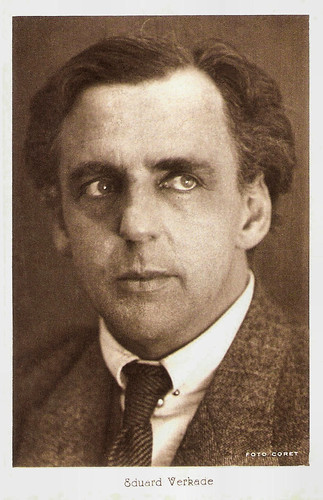
Dutch postcard. Photo: Willem Coret, Den Haag. Eduard Verkade.
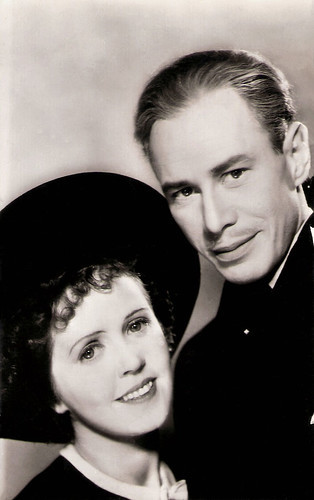
Dutch promotion card by Cinema Odeon, Den Haag. Photo: Neerlandia. Lily Bouwmeester as Judy and Paul Storm as Vadertje Langbeen in Vadertje Langbeen/Daddy Long Legs (Friedrich Zelnik, 1938).
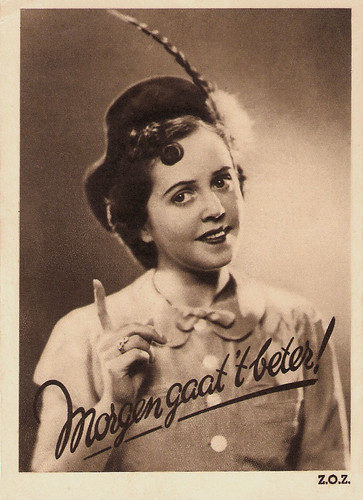
Dutch postcard by Colosseum Theater, Rotterdam. Photo: Neerlandia-Filmex. Lily Bouwmeester in Morgen gaat het beter/Tomorrow It Will Be Better (Friedrich Zelnik, 1939).
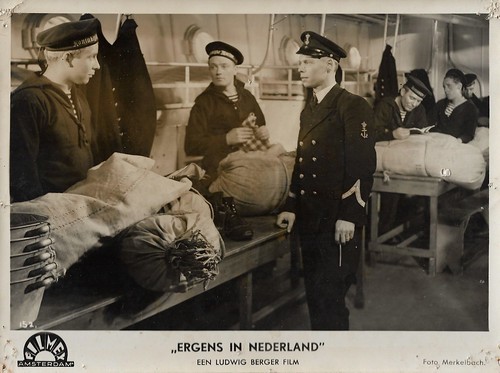
Dutch film still for Ergens in Nederland (Ludwig Berger, 1940). Photo: Merkelbach / Filmex. The man on the left is Jan de Hartog and the one on the right Max Croiset.
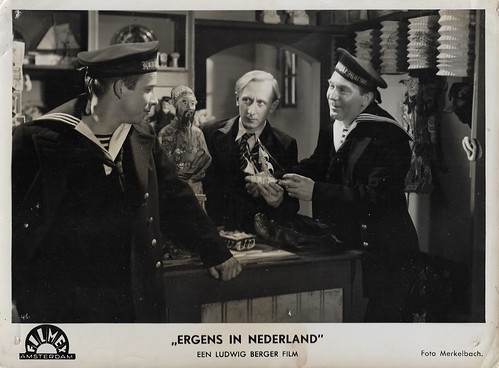
Dutch film still for Ergens in Nederland (Ludwig Berger, 1940). Photo: Merkelbach / Filmex. The man on the left is Jan de Hartog.
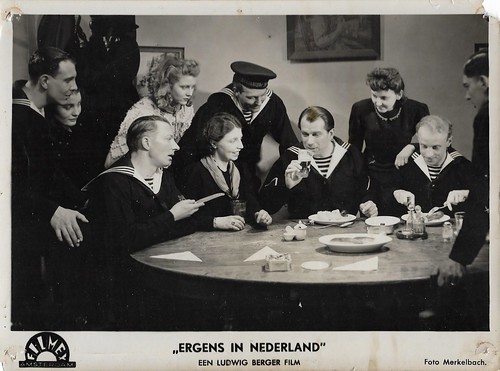
Dutch film still for Ergens in Nederland (Ludwig Berger, 1940). Photo: Merkelbach / Filmex. Sitting in the middle is Jan de Hartog and the one on the right Matthieu van Eysden.
Shifting from light-hearted entertainment to more serious social subjects
Pygmalion was a hit and the next year, Rudi Meyer duplicated the success with Vadertje Langbeen/Daddy Longlegs (Friedrich Zelnik, 1938) based on Jean Webster's 1912 novel 'Daddy Long Legs'. Again Lily Bouwmeester played the lead as Judy Aalders, an orphan girl longing for a family of her own. Her co-star was Paul Storm as Judy’s anonymous benefactor of whom she only saw a long shadow.
Meyer asked émigré director Friedrich Zelnik (later Fredric Zelnik) again to direct his next project, Morgen gaat 't beter!/Tomorrow It Will Be Better (Friedrich Zelnik, 1939), based on a novel by Annemarie Selinko. Lily Bouwmeester now played a not too smart schoolgirl who has to provide for herself during the crisis of the 1930s.
That same year, Meyer also produced De spooktrein/The Ghost Train (1939), directed by another prominent émigré director, Karel Lamač . A group of travelers finds themselves stranded for the night at a deserted train station, which according to the old stationmaster, has been haunted for the last 20 years. The all-star cast included Jan Musch as the stationmaster, Fien de la Mar, and Adolphe Engers as a strange professor.
In 1939 Meyer also became a board member of the film distribution company Filmex. German director Ludwig Berger shot Ergens in Nederland/Somewhere in the Netherlands (Ludwig Berger, 1940), about the mobilisation and the Dutch navy. The stars were Lily Bouwmeester and the future bestseller author Jan de Hartog. Ergens in Nederland was just released in the Dutch cinemas when the Netherlands was conquered by the Nazis, who Immediately banned the film.
Especially in the latter two films, a shift can be seen from a light-hearted sort of entertainment to more serious social subjects and current events. Meyer and Berger had planned to make a third film together but when war broke out, this plan never materialised.
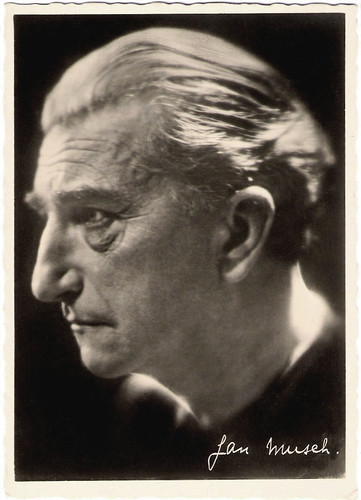
Dutch postcard by REB in the series Portrettengalerij no. 105. Jan Musch .
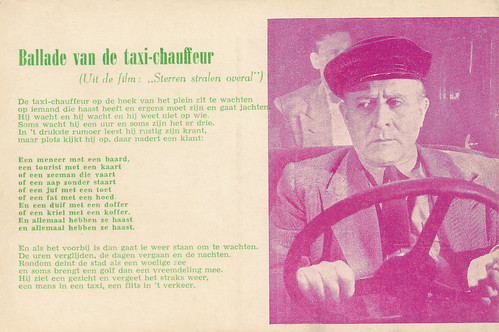
Dutch postcard by Editions Altona, Amsterdam, no. T 63. Photo: Johan Kaart in Sterren Stralen Overal/Stars Twinkle Anywhere (Gerard Rutten, 1953). Songtext of 'Ballade van de taxi-chauffeur'.
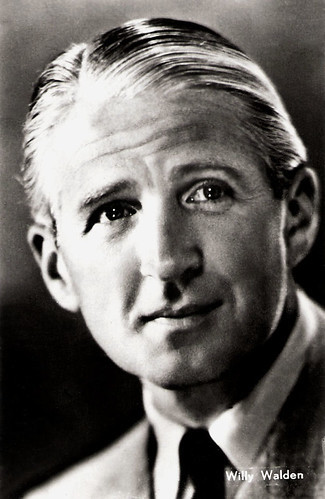
Dutch collectors card. Willy Walden.
Dutch comedians Willy Walden (1905-2003) and Piet Muyselaar (1899-1978), a.k.a. the ladies Snip & Snap, were the stars of the Sleeswijk Revue which filled the biggest theatres of the Netherlands between 1937 and 1977. The duo also starred together on TV and in the film Sterren stralen overal (1953).
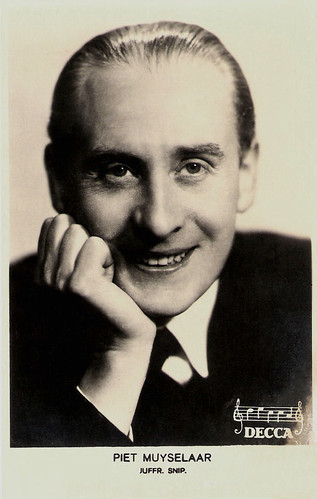
Dutch postcard by Uitg. Handelsonderneming Triëm, Utrecht. Photo: Decca. Piet Muyselaar .
The second most successful Dutch film of all time
Rudolf Meyer spent the first four years of the occupation (1940 to 1944) relatively safely in the Netherlands, protected by his marriage to a non-Jewish woman. In 1944 the Germans deported him to the Auschwitz extermination camp, which, however, he survived reasonably intact.
Upon his return to the Netherlands, he resumed his old profession as a film distributor for Filmex. He was responsible for the release of Roma, città aperta/Rome Open City (1945) and Paisa (1946), both directed by Roberto Rossellini. He scored a big hit with the Sissi trilogy (Ernst Marischka, 1955-1957).
As a producer, he returned to the cinemas with Sterren stralen overall/Stars twinkle everywhere (Gerard Rutten, 1953). Johan Kaart played in the film a struggling Dutch cab driver who wants to emigrate with his family to Australia. The film attracted one and a half million visitors - partly due to the guest appearance of the immensely popular revue duo Piet Muijselaar and Willy Walden (Snip & Snap).
An even bigger box office hit was the comedy Fanfare (1958), directed by documentary film maker Bert Haanstra and starring Hans Kaart, Albert Mol, and Andrea Domburg . After a fight, the brass band (fanfare in Dutch) in the fictitious village of Lagerwiede splits up into two separate bands. They both want to win a contest and will do anything to prevent the other band from winning it. The film was visited by 2,636,000 people, which made Fanfare the second most successful Dutch film of all time.
The follow-up film, De Zaak M.P./The Manneken Pis Case (1960), also directed by Bert Haanstra and starring Albert Mol, was a disappointing flop, both critically and commercially. The quite silly comedy had been produced jointly by Haanstra and Meyer.
Much better was Meyer’s next production, the war thriller De Overval/The Silent Raid (Paul Rotha, 1962), starring Rob de Vries , Kees Brusse, and Yoka Beretty . In 1944, resistance-fighter Bakker (Rob de Vries, who had been a real resistance fighter during the war) gets sent to a prison in Leeuwarden by the Gestapo. There he and other resistance-fighters are about to be rescued in a giant prison escape by their companions.
Like no other, Meyer knew what the public wanted and he could offer it to them: without making too many concessions to quality, but also without too much experimentation.
A sensation was the documentary Mensen van morgen/People of Tomorrow (Kees Brusse, 1964), a portrait of a new generation. Young people talked frankly to director Kees Brusse about love, faith, sex, and society. Two years later followed a German version, Menschen von Morgen - Geständnisse vor der Kamera (1966), also directed by Kees Brusse . It was Meyer's final film.
Rudi Meyer passed away in 1969 in Amsterdam. He was 68.
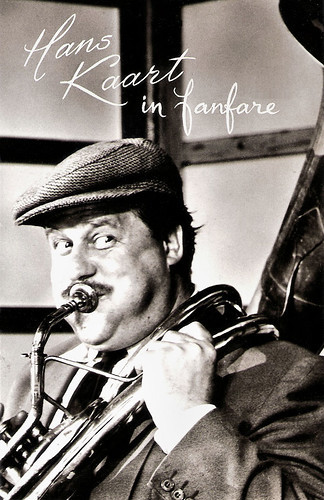
Dutch postcard by Uitg. Takken, Utrecht, no. 3796. Photo: Jutka Mol-Rona / Sapphire Film Productie. Hans Kaart in Fanfare (Bert Haanstra, 1958).
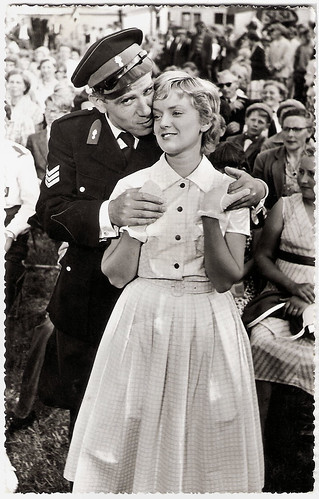
Dutch postcard by Int. Filmpers (IFP), Amsterdam, no. 1920. Photo: Ineke Brinkman and Wim van den Heuvel in Fanfare (Bert Haanstra, 1958).
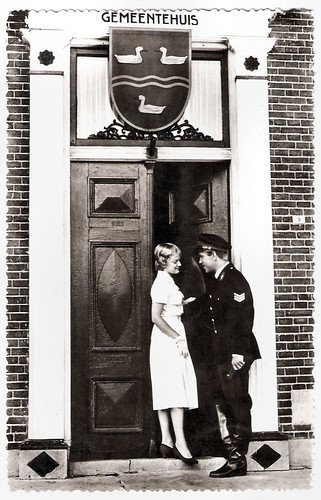
Dutch postcard by Int. Filmpers (IFP), Amsterdam, no. 1932. Photo: Ineke Brinkman and Wim van den Heuvel in Fanfare (Bert Haanstra, 1958).
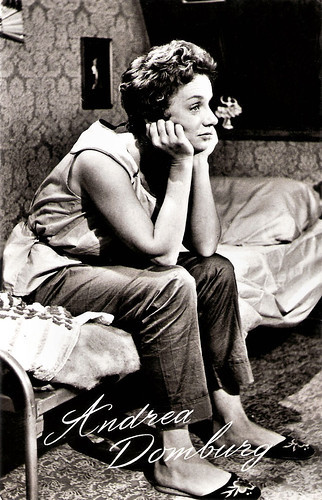
Dutch postcard by Uitg. Takken, Utrecht, no. 3792. Photo: Jutka Mol-Rona / Sapphire Film Productie. Andrea Domburg in Fanfare (Bert Haanstra, 1958).
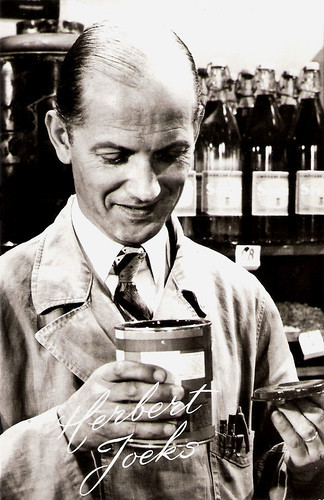
Dutch postcard by Uitg. Takken, Utrecht, no. 3793. Photo: Jutka Mol-Rona / Sapphire Film Productie. Herbert Joeks in Fanfare (Bert Haanstra, 1958).
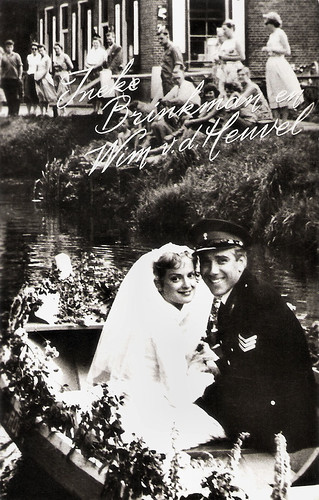
Dutch postcard by Uitg. Takken, Utrecht, no. 3794. Photo: Jutka Mol-Rona / Sapphire Film Productie. Ineke Brinkman and Wim van den Heuvel in Fanfare (Bert Haanstra, 1958).
Sources: Chip Douglas (IMDb), Eye (Dutch), Wikipedia (German), and .

Dutch postcard by M. B. & Z. Photo: Petrus Verheijen / Holfi-Film. Dolly Mollinger and Frits van Dongen in De Kribbebijter/The Cross-Patch (Hermann Kosterlitz a.k.a. Henry Koster, 1935).

Dutch postcard, no. 47759. Photo: Hilde Meyer-Kupfer. Adolphe Engers .

Dutch film still for Ergens in Nederland (Ludwig Berger, 1940). Photo: Merkelbach / Filmex. The two soldiers in the boat are Jan de Hartog and probably Max Croiset. The man on the right is Matthieu van Eysden.

Dutch film still for Ergens in Nederland (Ludwig Berger, 1940). Photo: Merkelbach / Filmex. The man on the right is Jan de Hartog.

East-German postcard by VEB Progress Film-Vertrieb, Berlin, no. 2010, 1964. Retail price: 0,20 DM. Photo: Rob de Vries in De Overval/The Silent Raid (Paul Rotha, 1962).
A Dutch film par excellence for the first time
Rudolf (Rudi) Meyer was born in 1901 in Suhl, Germany. In the 1920s, he started his career in the film business through his uncle Erich Pommer, who was then head of the production at Decla. Rudi held various positions in the sector and in the early 1930s, he was the head of the export department of the Berlin production company Aafa Film A.G. of producer Gabriel Levy.
National Socialism in Germany drove the Jew Meyer out of the country in 1933. Jo Paerl, Aafa's Dutch representative, invited him to come to the Netherlands. Meyer and Levy worked for the Universal Film Agency in Amsterdam, which concentrated on buying Dutch, Belgian and French films.
At IMDb , Meyer’s first credit is as a production manager for the Belgian comedy, De wonderdokter/The Miracle Doctor (Jan Vanderheyden, 1936), starring Jan Cammans.
However, in 1934 Meyer had already started with Jo Pearl and Gabriel Levy the production company Holfi-Film (Hollandsche Film Productie). Their first production was the Dutch romantic comedy De kribbebijter/The Cross-Patch (1935) about a secretary ( Dolly Mollinger ) and the disinherited son ( Frits van Dongen a.k.a. Philip Dorn) of a sour baron (Cor Ruys). For the direction, Meyer asked another emigrant, Hermann Kösterlitz, who later became famous in Hollywood as Henry Koster.
Both the critics and the public liked the film. Meyer’s second production was Amsterdam bij nacht/Amsterdam by Night (Alex Benno, 1936).
A real box-office hit was Meyer’s next production, Pygmalion (Ludwig Berger, 1937), an adaptation of the George Bernard Shaw play. The stars were Lily Bouwmeester as low-class flower seller Elisa, Johan De Meester as Professor Henry Higgins who mockingly offers to teach her how to speak properly, and Eduard Verkade as his friend and colleague Pickering. The part of Liesje Doeluttel made Bouwmeester into an instant star, leading to several more leading roles in Dutch films.
“For the first time since the beginning of Dutch film industry, one can speak without compunction of a Dutch film par excellence”, wrote the Catholic film magazine Filmfront: "For the first time, actors and actresses speak and act in a natural way. For the first time, sets and music are justified as living parts of a living whole. And what is most admirable in Berger’s film is the fact that he has managed to let the dialogue flow convincingly in the rhythm of the film".

Dutch postcard. Photo: Willem Coret, Den Haag. Eduard Verkade.

Dutch promotion card by Cinema Odeon, Den Haag. Photo: Neerlandia. Lily Bouwmeester as Judy and Paul Storm as Vadertje Langbeen in Vadertje Langbeen/Daddy Long Legs (Friedrich Zelnik, 1938).

Dutch postcard by Colosseum Theater, Rotterdam. Photo: Neerlandia-Filmex. Lily Bouwmeester in Morgen gaat het beter/Tomorrow It Will Be Better (Friedrich Zelnik, 1939).

Dutch film still for Ergens in Nederland (Ludwig Berger, 1940). Photo: Merkelbach / Filmex. The man on the left is Jan de Hartog and the one on the right Max Croiset.

Dutch film still for Ergens in Nederland (Ludwig Berger, 1940). Photo: Merkelbach / Filmex. The man on the left is Jan de Hartog.

Dutch film still for Ergens in Nederland (Ludwig Berger, 1940). Photo: Merkelbach / Filmex. Sitting in the middle is Jan de Hartog and the one on the right Matthieu van Eysden.
Shifting from light-hearted entertainment to more serious social subjects
Pygmalion was a hit and the next year, Rudi Meyer duplicated the success with Vadertje Langbeen/Daddy Longlegs (Friedrich Zelnik, 1938) based on Jean Webster's 1912 novel 'Daddy Long Legs'. Again Lily Bouwmeester played the lead as Judy Aalders, an orphan girl longing for a family of her own. Her co-star was Paul Storm as Judy’s anonymous benefactor of whom she only saw a long shadow.
Meyer asked émigré director Friedrich Zelnik (later Fredric Zelnik) again to direct his next project, Morgen gaat 't beter!/Tomorrow It Will Be Better (Friedrich Zelnik, 1939), based on a novel by Annemarie Selinko. Lily Bouwmeester now played a not too smart schoolgirl who has to provide for herself during the crisis of the 1930s.
That same year, Meyer also produced De spooktrein/The Ghost Train (1939), directed by another prominent émigré director, Karel Lamač . A group of travelers finds themselves stranded for the night at a deserted train station, which according to the old stationmaster, has been haunted for the last 20 years. The all-star cast included Jan Musch as the stationmaster, Fien de la Mar, and Adolphe Engers as a strange professor.
In 1939 Meyer also became a board member of the film distribution company Filmex. German director Ludwig Berger shot Ergens in Nederland/Somewhere in the Netherlands (Ludwig Berger, 1940), about the mobilisation and the Dutch navy. The stars were Lily Bouwmeester and the future bestseller author Jan de Hartog. Ergens in Nederland was just released in the Dutch cinemas when the Netherlands was conquered by the Nazis, who Immediately banned the film.
Especially in the latter two films, a shift can be seen from a light-hearted sort of entertainment to more serious social subjects and current events. Meyer and Berger had planned to make a third film together but when war broke out, this plan never materialised.

Dutch postcard by REB in the series Portrettengalerij no. 105. Jan Musch .

Dutch postcard by Editions Altona, Amsterdam, no. T 63. Photo: Johan Kaart in Sterren Stralen Overal/Stars Twinkle Anywhere (Gerard Rutten, 1953). Songtext of 'Ballade van de taxi-chauffeur'.

Dutch collectors card. Willy Walden.
Dutch comedians Willy Walden (1905-2003) and Piet Muyselaar (1899-1978), a.k.a. the ladies Snip & Snap, were the stars of the Sleeswijk Revue which filled the biggest theatres of the Netherlands between 1937 and 1977. The duo also starred together on TV and in the film Sterren stralen overal (1953).

Dutch postcard by Uitg. Handelsonderneming Triëm, Utrecht. Photo: Decca. Piet Muyselaar .
The second most successful Dutch film of all time
Rudolf Meyer spent the first four years of the occupation (1940 to 1944) relatively safely in the Netherlands, protected by his marriage to a non-Jewish woman. In 1944 the Germans deported him to the Auschwitz extermination camp, which, however, he survived reasonably intact.
Upon his return to the Netherlands, he resumed his old profession as a film distributor for Filmex. He was responsible for the release of Roma, città aperta/Rome Open City (1945) and Paisa (1946), both directed by Roberto Rossellini. He scored a big hit with the Sissi trilogy (Ernst Marischka, 1955-1957).
As a producer, he returned to the cinemas with Sterren stralen overall/Stars twinkle everywhere (Gerard Rutten, 1953). Johan Kaart played in the film a struggling Dutch cab driver who wants to emigrate with his family to Australia. The film attracted one and a half million visitors - partly due to the guest appearance of the immensely popular revue duo Piet Muijselaar and Willy Walden (Snip & Snap).
An even bigger box office hit was the comedy Fanfare (1958), directed by documentary film maker Bert Haanstra and starring Hans Kaart, Albert Mol, and Andrea Domburg . After a fight, the brass band (fanfare in Dutch) in the fictitious village of Lagerwiede splits up into two separate bands. They both want to win a contest and will do anything to prevent the other band from winning it. The film was visited by 2,636,000 people, which made Fanfare the second most successful Dutch film of all time.
The follow-up film, De Zaak M.P./The Manneken Pis Case (1960), also directed by Bert Haanstra and starring Albert Mol, was a disappointing flop, both critically and commercially. The quite silly comedy had been produced jointly by Haanstra and Meyer.
Much better was Meyer’s next production, the war thriller De Overval/The Silent Raid (Paul Rotha, 1962), starring Rob de Vries , Kees Brusse, and Yoka Beretty . In 1944, resistance-fighter Bakker (Rob de Vries, who had been a real resistance fighter during the war) gets sent to a prison in Leeuwarden by the Gestapo. There he and other resistance-fighters are about to be rescued in a giant prison escape by their companions.
Like no other, Meyer knew what the public wanted and he could offer it to them: without making too many concessions to quality, but also without too much experimentation.
A sensation was the documentary Mensen van morgen/People of Tomorrow (Kees Brusse, 1964), a portrait of a new generation. Young people talked frankly to director Kees Brusse about love, faith, sex, and society. Two years later followed a German version, Menschen von Morgen - Geständnisse vor der Kamera (1966), also directed by Kees Brusse . It was Meyer's final film.
Rudi Meyer passed away in 1969 in Amsterdam. He was 68.

Dutch postcard by Uitg. Takken, Utrecht, no. 3796. Photo: Jutka Mol-Rona / Sapphire Film Productie. Hans Kaart in Fanfare (Bert Haanstra, 1958).

Dutch postcard by Int. Filmpers (IFP), Amsterdam, no. 1920. Photo: Ineke Brinkman and Wim van den Heuvel in Fanfare (Bert Haanstra, 1958).

Dutch postcard by Int. Filmpers (IFP), Amsterdam, no. 1932. Photo: Ineke Brinkman and Wim van den Heuvel in Fanfare (Bert Haanstra, 1958).

Dutch postcard by Uitg. Takken, Utrecht, no. 3792. Photo: Jutka Mol-Rona / Sapphire Film Productie. Andrea Domburg in Fanfare (Bert Haanstra, 1958).

Dutch postcard by Uitg. Takken, Utrecht, no. 3793. Photo: Jutka Mol-Rona / Sapphire Film Productie. Herbert Joeks in Fanfare (Bert Haanstra, 1958).

Dutch postcard by Uitg. Takken, Utrecht, no. 3794. Photo: Jutka Mol-Rona / Sapphire Film Productie. Ineke Brinkman and Wim van den Heuvel in Fanfare (Bert Haanstra, 1958).
Sources: Chip Douglas (IMDb), Eye (Dutch), Wikipedia (German), and .
Published on November 13, 2020 22:00
November 12, 2020
Cinefest 2020: Ivo Blom's personal postcard choice
This week we follow Cinefest, the 17th International Festival of German Film-Heritage. The theme is 'Cinema, War, and Tulips: German-Dutch Film Relations'. EFSP co-host Ivo Blom is one of the guest-curators of the festival and congress. Because of Corona, Cinefest will be only online and in a limited form this year. The film programme will consist of 9 Dutch films of the 1930s made by emigré directors including Detlev Sierck (a.k.a. Douglas Sirk), Max Ophüls and Ludwig Berger. So till the end of the Cinefest on 22 November 2020, EFSP will post daily on stars, directors, and films connected to the festival theme. Today, we start with Ivo's personal postcard choice.
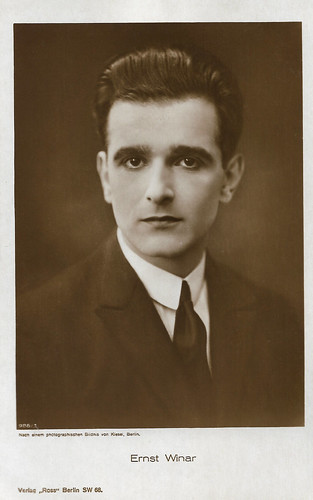
German postcard, no. 988/1, 1925-1926. Photo: Kiesel, Berlin.
Dutch actor Ernst Winar (1894-1978) appeared in 34 films between 1916 and 1955, in The Netherlands and as well in Germany. He got his first major role in Germany in Die Benefizvorstellung der Vier Teufel/The benefit performance of the four devils (1920) by Danish director Anders Wilhelm Sandberg. The film was a success and numerous films followed. He was also a film director and made 14 films between 1922 and 1955. First, he was responsible for three episodes of the Terra series Flappy with Adolphe Engers in the lead role. In 1922, he directed his first feature film, the crime film Der Mann im Hintergrund/The man in the background, but the film was released only after several changes in October 1924. In 1932 Winar returned to the Netherlands. He made the short sound film Hollandsch Hollywood (1933) for which revue star Fien de la Mar sang the title song, announcing a new Dutch film industry. In 1935 Winar and Fien de la Mar worked together again on the musical Op Stap (Ernst Winar, 1935) which also featured revue stars Louis and Heintje Davids and Adolphe Engers, who was also back from Berlin. In the early 1960s, he edited the first short films of Paul Verhoeven.
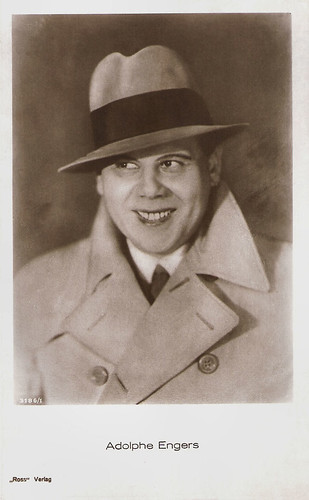
German postcard by Ross Verlag, no. 3186/1, 1928-1929.
Impressive Dutch actor Adolphe Engers (1884-1945) appeared in some 50 German and Dutch films in the 1920s and 1930s. In the 1920s he became a very busy actor in Germany, often playing with fellow compatriote actors like Ernst Winar. Already in his second German film, Der Liebeskorridor/The Love Passage (Emil Albes, 1920), Engers had the male lead of the film, opposite Erika Glässner. Engers played in Ernst Winar's German-Dutch coproduction De man op den achtergrond/Der Mann im Hintergrund (The Man in the Back, 1922). He was also highly succesful with his leading role in the Flappy serial, three short films directed by Winar for the Berliner Terra Film AG. Engers also acted in films by other Dutch filmmakers residing in Berlin like Theo Frenkel and Jaap Speyer.
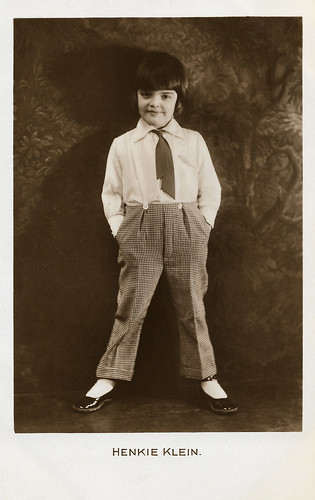
Dutch postcard by B. Brouwer, Amsterdam. Photo: Bernard Eilers, Amsterdam.
Little Henkie Klein (1921-ca. 1993) was a child actor in German and Dutch films of the silent era. He was called the 'Dutch Jackie Coogan'. He was the son of film director Henk Kleinman(n). Henkie appeared in his father's film Die Fahrt ins Verderben/Op hoop van zegen (Henk Kleinman, James Bauer, 1924). This was the second film version of 'Op hoop van zegen' (On hope of blessing), a classic Dutch fisher drama written by Herman Heijermans in 1900. The success of the production lead to another film based on a play by Heijermans, Die vom Schicksal Verfolgten/Droomkoninkje/Little Dream King (Henk Kleinman, 1926) with Wilhelm Dieterle (aka William Dieterle) and Aud Egede Nissen. Little Henkie played the lead of a boy born with a clubfoot who creates his own dream world.
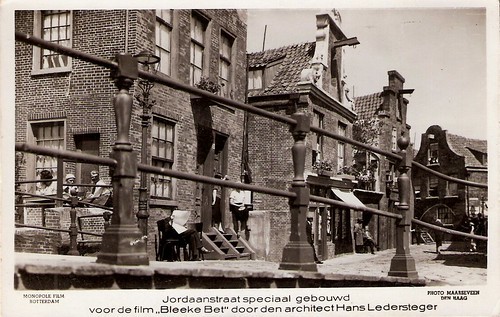
Dutch postcard by Monopole Film, Rotterdam. Photo: Dick van Maarseveen.
Still of a set built for Bleeke Bet (Alex Benno, Richard Oswald, 1934), a street in the old neighbourhood De Jordaan in Amsterdam. The set designer was Hans Ledersteger.
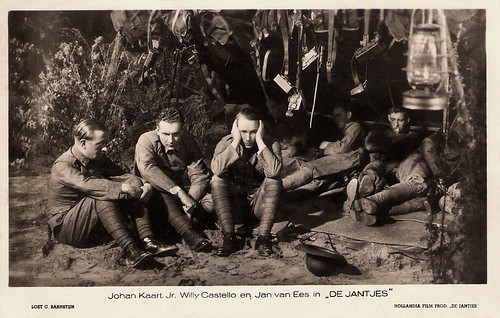
Dutch postcard by M. B.& Z. (M. Bonnist & Zonen, Amsterdam) for Hollandia Film Prod. / Loet C. Barnstijn. Photo: Johan Kaart jr., Willy Costello and Jan van Ees in De Jantjes/The Tars (Jaap Speyer, 1934).
The musical drama De Jantjes (Jaap Speyer, 1934) is a little pre-war Dutch gem. It was the second Dutch sound film and a huge box office hit at the time. De Jantjes (the international title is The Tars) was based on a popular Jordaan play (a play set in an old neighbourhood of Amsterdam, the Jordaan) by Herman Bouber, which was already filmed in 1922.
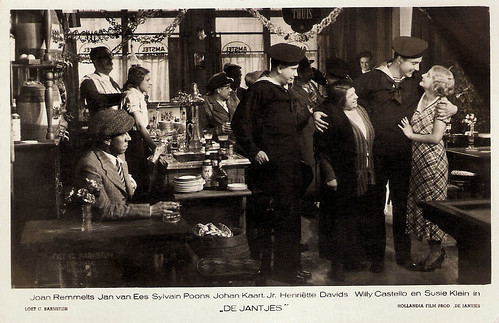
Dutch postcard by Hollandia Film Prod. / Loet C. Barnstijn. Photo: Joan Remmelts, Jan van Ees , Sylvain Poons , Johan Kaart jr. , Henriëtte Davids , Willy Castello , Susie Klein in De Jantjes (Jaap Speyer, 1934).
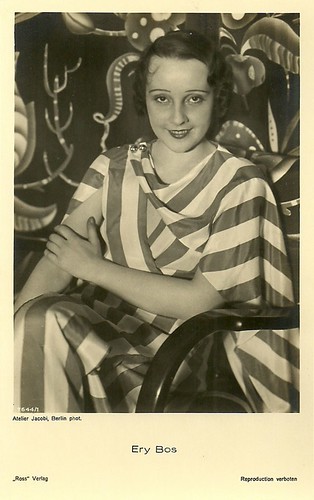
German postcard by Ross Verlag, no. 7644/1, 1932-1933. Photo: Atelier Jacobi.
The Dutch-German actress Ery Bos (1910-2005) had a short but productive film career in the early German sound film. In only three years, from 1932 to 1934 she took part in a dozen films.
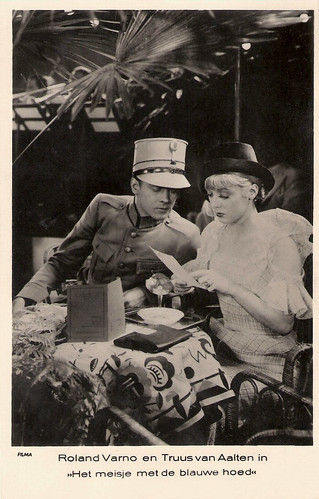
Dutch postcard by M. B.& Z. (M. Bonnist & Zonen, Amsterdam). Photo: Filma. Truus van Aalten and Roland Varno in Het meisje met de blauwe hoed/The Girl with the Blue Hat (Rudolf Meinert, 1934).
Dutch-born actor Roland Varno (1908-1996) is best known for his role as one of the schoolboys in Der blaue Engel/The Blue Angel (Josef von Sternberg, 1930). He appeared in more German and Dutch films of the early 1930s and he also worked in Hollywood as a character actor, mainly in B-pictures.
Dutch film star Truus van Aalten (1910-1999) made 29 films in the 1920s and 1930s, and only one of them in the Netherlands, Het meisje met de blauwe hoed/The Girl with the Blue Hat (Rudolf Meinert, 1934).
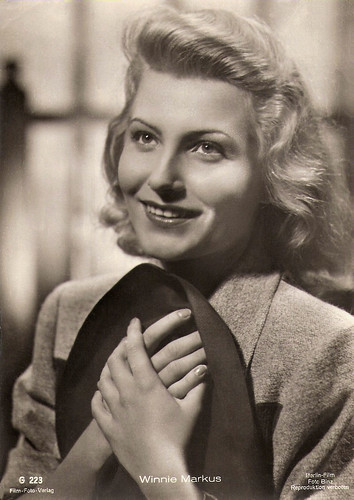
German postcard by Film-Foto-Verlag, no. G 223, 1941-1944. Photo: Berlin-Film / Foto Binz.
Blonde Winnie Markus (1921-2002) started as a Ufa star during the Nazi period and became in the 1950s one of Germany’s most famous actresses.
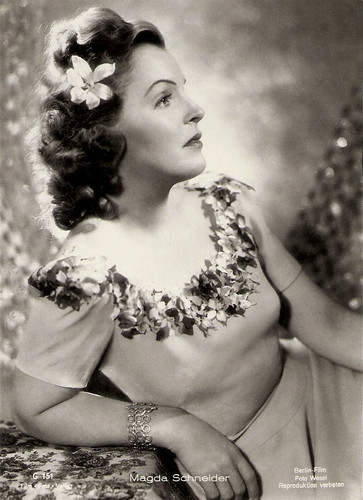
German postcard by Film-Foto-Verlag, no. G 151, 1941-1944. Photo: Wesel / Berlin-Film.
German singer and actress Magda Schneider (1909-1996) is best known as the mother of film star Romy Schneider, but in the 1930s, 1940s, and 1950s, she herself starred in some 40 films. First, she appeared on the screen as a charming Wiener mädel (Viennese girl) and after the war, she often played the understanding mother or aunt.
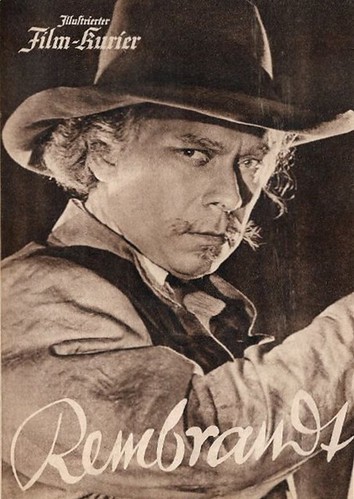
Cover of the special issue of Illustrierter Film-Kurier on the German biopic Rembrandt/ Ewiger Rembrandt (Hans Steinhoff, 1942), with Ewald Balser in the title role.
Rembrandt/ Ewiger Rembrandt (Hans Steinhoff, 1942) was shot both at the Dutch film studio Cinetone and the near The Hague based Filmstad studio, during the German Occupation of the Netherlands in World War Two. It was the first German film production in Holland during WWII, made between 1941 and 1942. Afterward several would follow, mainly by the newly founded company Berlin-Film. While the cast was fully German, some crew members were Dutch such as assistant-director Charles Huguenot van der Linden. Leading in the cast were Ewald Balser (Rembrandt), Herta Feiler (Saskia), Elisabeth Flickenschildt (Geertje), Gisela Uhlen (Hendrikje), Theodor Loos (Jan Six), Aribert Wäscher (Uijlenburgh), and Paul Henckels (etcher Seeghers). Small parts were for well-known routinés such as Eduard von Winterstein, Frida Richard, Nicolas Koline, Angelo Ferrari, and Viktor Janson, according to IMDb . Sets were by Walter Röhrig, famous for his art direction of the Expressionist cinema.
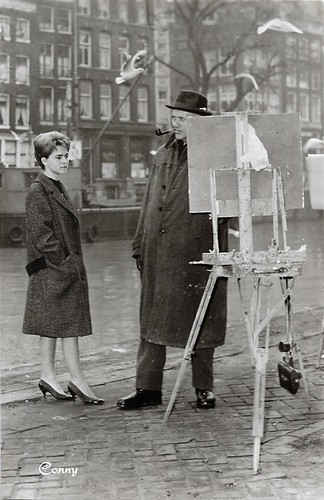
Dutch postcard by Ed. Int. Filmpers, Amsterdam.
Conny Froboess visited the Netherlands a few times, probably first in May 1959 when she visited Amsterdam to promote her new film Teenager-Melodie/Wenn die Conny mit dem Peter (Fritz Umgelter, 1958). She returned in February 1960 for a performance at the Scheveningen Kurhaus during a dance contest, and in September 1962 for the Grand Gala du Disque.
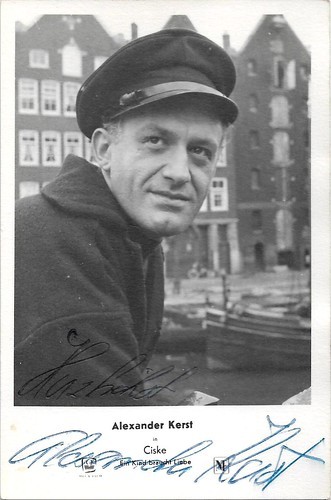
German postcard. Photo: Omega Film. Autographed postcard of Alexander Kerst in Ciske - Ein Kind Braucht Liebe (Wolfgang Staudte, 1955), based on the novel by Dutch author Piet Bakker.
This was the German version of the parallel made Dutch film Ciske, de rat (Wolfgang Staudte, 1955), situated and shot in the city of Amsterdam (with interiors shot at the Amsterdam Cinetone film studio). Kerst played the sailor Freymuth, Ciske's father. Part of the Dutch cast played in the German version as well, including Kees Brusse as Ciske's teacher Bruis, and young Dick van der Velde as Ciske himself. While the Dutch version became the third-best viewed Dutch film in the Netherlands and won a Silver Lion in Venice, the German version was not a huge success in Germany and remained one of the most unknown films of Staudte.
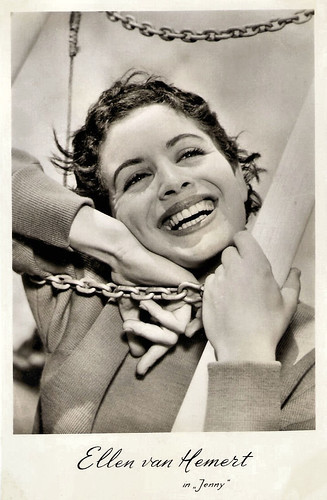
Dutch postcard by Uitg. Takken, Utrecht, no. 3192. Photo: N.V. Standaardfilms. Ellen van Hemert in Jenny (Willy van Hemert, 1958).
Ellen van Hemert (1937) starred in the Dutch romcom Jenny (1958). Jenny was the first Dutch film in colour. The film was directed by Ellen's father Willy van Hemert, a television director who made only one theatrical feature. The producer was NV Standaardfilms. Furthermore, Ellen van Hemert made only a few television films in the early sixties. She is the sister of film director Ruud van Hemert and she was married to actor Coen Flink.

East-German postcard by VEB Progress Film-Vertrieb, Berlin, no. 2010, 1964. Retail price: 0,20 DM. Photo: publicity still for De Overval/The Silent Raid (Paul Rotha, 1962).
Dutch actor Rob de Vries (1918–1969) was the star of the classic war film De Overval/The Silent Raid (1962). During the 1940s and 1950s, he appeared in more Dutch films that were internationally successful.
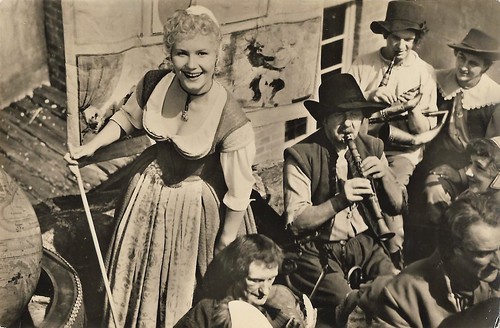
German postcard by VEB Progress Film-Vertrieb, Berlin, no. 54/68. Photo: Wenze DEFA. Lore Frisch in Zar und Zimmermann/Tsar and Carpenter (Hans Müller, 1956), adapted from the comical opera by Albert Lortzing.
Lore Frisch (1925-1962) was a German film actress of the 1950s and early 1960s, who in the 1950s starred in the popular DEFA films Der Ochse von Kulm (1955), Zar und Zimmermann (1956), and Meine Frau macht Musik (1958). When her married lover abandoned her, she committed suicide.
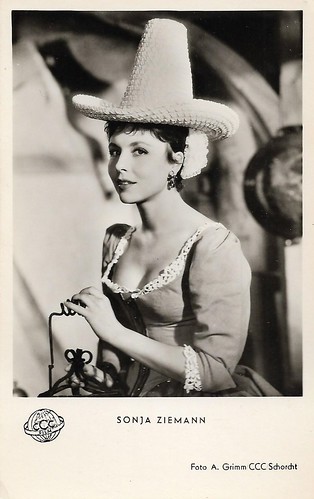
German postcard. Photo: Arthur Grimm / CCC Film (Artur Brauner) / Schorcht. Sonja Ziemann in Das Bad auf der Tenne (Paul Martin, 1956).
On 17 February 2020, German film and television actress, singer, and dancer Sonja Ziemann (1926) passed away at the age of 94. The delicately lovely, dark-haired, and innocent-looking Ziemann was one of the first stars of Germany's post-war cinema. She starred in film operettas and Heimatfilms as Schwarzwaldmädel/The Black Forest Girl (1950) and Grün ist die Heide/The Heath is Green (1951). Her private life knew several tragedies.
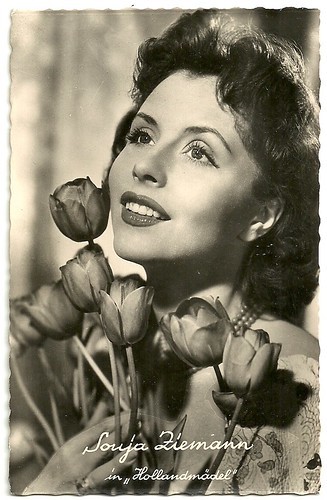
German postcard. Photo: CCC (Central Cinema Company Film). Sonja Ziemann in Hollandmädel/Dutch Girls (J.A. Hübler-Kahla, 1953).

German postcard, no. 988/1, 1925-1926. Photo: Kiesel, Berlin.
Dutch actor Ernst Winar (1894-1978) appeared in 34 films between 1916 and 1955, in The Netherlands and as well in Germany. He got his first major role in Germany in Die Benefizvorstellung der Vier Teufel/The benefit performance of the four devils (1920) by Danish director Anders Wilhelm Sandberg. The film was a success and numerous films followed. He was also a film director and made 14 films between 1922 and 1955. First, he was responsible for three episodes of the Terra series Flappy with Adolphe Engers in the lead role. In 1922, he directed his first feature film, the crime film Der Mann im Hintergrund/The man in the background, but the film was released only after several changes in October 1924. In 1932 Winar returned to the Netherlands. He made the short sound film Hollandsch Hollywood (1933) for which revue star Fien de la Mar sang the title song, announcing a new Dutch film industry. In 1935 Winar and Fien de la Mar worked together again on the musical Op Stap (Ernst Winar, 1935) which also featured revue stars Louis and Heintje Davids and Adolphe Engers, who was also back from Berlin. In the early 1960s, he edited the first short films of Paul Verhoeven.

German postcard by Ross Verlag, no. 3186/1, 1928-1929.
Impressive Dutch actor Adolphe Engers (1884-1945) appeared in some 50 German and Dutch films in the 1920s and 1930s. In the 1920s he became a very busy actor in Germany, often playing with fellow compatriote actors like Ernst Winar. Already in his second German film, Der Liebeskorridor/The Love Passage (Emil Albes, 1920), Engers had the male lead of the film, opposite Erika Glässner. Engers played in Ernst Winar's German-Dutch coproduction De man op den achtergrond/Der Mann im Hintergrund (The Man in the Back, 1922). He was also highly succesful with his leading role in the Flappy serial, three short films directed by Winar for the Berliner Terra Film AG. Engers also acted in films by other Dutch filmmakers residing in Berlin like Theo Frenkel and Jaap Speyer.

Dutch postcard by B. Brouwer, Amsterdam. Photo: Bernard Eilers, Amsterdam.
Little Henkie Klein (1921-ca. 1993) was a child actor in German and Dutch films of the silent era. He was called the 'Dutch Jackie Coogan'. He was the son of film director Henk Kleinman(n). Henkie appeared in his father's film Die Fahrt ins Verderben/Op hoop van zegen (Henk Kleinman, James Bauer, 1924). This was the second film version of 'Op hoop van zegen' (On hope of blessing), a classic Dutch fisher drama written by Herman Heijermans in 1900. The success of the production lead to another film based on a play by Heijermans, Die vom Schicksal Verfolgten/Droomkoninkje/Little Dream King (Henk Kleinman, 1926) with Wilhelm Dieterle (aka William Dieterle) and Aud Egede Nissen. Little Henkie played the lead of a boy born with a clubfoot who creates his own dream world.

Dutch postcard by Monopole Film, Rotterdam. Photo: Dick van Maarseveen.
Still of a set built for Bleeke Bet (Alex Benno, Richard Oswald, 1934), a street in the old neighbourhood De Jordaan in Amsterdam. The set designer was Hans Ledersteger.

Dutch postcard by M. B.& Z. (M. Bonnist & Zonen, Amsterdam) for Hollandia Film Prod. / Loet C. Barnstijn. Photo: Johan Kaart jr., Willy Costello and Jan van Ees in De Jantjes/The Tars (Jaap Speyer, 1934).
The musical drama De Jantjes (Jaap Speyer, 1934) is a little pre-war Dutch gem. It was the second Dutch sound film and a huge box office hit at the time. De Jantjes (the international title is The Tars) was based on a popular Jordaan play (a play set in an old neighbourhood of Amsterdam, the Jordaan) by Herman Bouber, which was already filmed in 1922.

Dutch postcard by Hollandia Film Prod. / Loet C. Barnstijn. Photo: Joan Remmelts, Jan van Ees , Sylvain Poons , Johan Kaart jr. , Henriëtte Davids , Willy Castello , Susie Klein in De Jantjes (Jaap Speyer, 1934).

German postcard by Ross Verlag, no. 7644/1, 1932-1933. Photo: Atelier Jacobi.
The Dutch-German actress Ery Bos (1910-2005) had a short but productive film career in the early German sound film. In only three years, from 1932 to 1934 she took part in a dozen films.

Dutch postcard by M. B.& Z. (M. Bonnist & Zonen, Amsterdam). Photo: Filma. Truus van Aalten and Roland Varno in Het meisje met de blauwe hoed/The Girl with the Blue Hat (Rudolf Meinert, 1934).
Dutch-born actor Roland Varno (1908-1996) is best known for his role as one of the schoolboys in Der blaue Engel/The Blue Angel (Josef von Sternberg, 1930). He appeared in more German and Dutch films of the early 1930s and he also worked in Hollywood as a character actor, mainly in B-pictures.
Dutch film star Truus van Aalten (1910-1999) made 29 films in the 1920s and 1930s, and only one of them in the Netherlands, Het meisje met de blauwe hoed/The Girl with the Blue Hat (Rudolf Meinert, 1934).

German postcard by Film-Foto-Verlag, no. G 223, 1941-1944. Photo: Berlin-Film / Foto Binz.
Blonde Winnie Markus (1921-2002) started as a Ufa star during the Nazi period and became in the 1950s one of Germany’s most famous actresses.

German postcard by Film-Foto-Verlag, no. G 151, 1941-1944. Photo: Wesel / Berlin-Film.
German singer and actress Magda Schneider (1909-1996) is best known as the mother of film star Romy Schneider, but in the 1930s, 1940s, and 1950s, she herself starred in some 40 films. First, she appeared on the screen as a charming Wiener mädel (Viennese girl) and after the war, she often played the understanding mother or aunt.

Cover of the special issue of Illustrierter Film-Kurier on the German biopic Rembrandt/ Ewiger Rembrandt (Hans Steinhoff, 1942), with Ewald Balser in the title role.
Rembrandt/ Ewiger Rembrandt (Hans Steinhoff, 1942) was shot both at the Dutch film studio Cinetone and the near The Hague based Filmstad studio, during the German Occupation of the Netherlands in World War Two. It was the first German film production in Holland during WWII, made between 1941 and 1942. Afterward several would follow, mainly by the newly founded company Berlin-Film. While the cast was fully German, some crew members were Dutch such as assistant-director Charles Huguenot van der Linden. Leading in the cast were Ewald Balser (Rembrandt), Herta Feiler (Saskia), Elisabeth Flickenschildt (Geertje), Gisela Uhlen (Hendrikje), Theodor Loos (Jan Six), Aribert Wäscher (Uijlenburgh), and Paul Henckels (etcher Seeghers). Small parts were for well-known routinés such as Eduard von Winterstein, Frida Richard, Nicolas Koline, Angelo Ferrari, and Viktor Janson, according to IMDb . Sets were by Walter Röhrig, famous for his art direction of the Expressionist cinema.

Dutch postcard by Ed. Int. Filmpers, Amsterdam.
Conny Froboess visited the Netherlands a few times, probably first in May 1959 when she visited Amsterdam to promote her new film Teenager-Melodie/Wenn die Conny mit dem Peter (Fritz Umgelter, 1958). She returned in February 1960 for a performance at the Scheveningen Kurhaus during a dance contest, and in September 1962 for the Grand Gala du Disque.

German postcard. Photo: Omega Film. Autographed postcard of Alexander Kerst in Ciske - Ein Kind Braucht Liebe (Wolfgang Staudte, 1955), based on the novel by Dutch author Piet Bakker.
This was the German version of the parallel made Dutch film Ciske, de rat (Wolfgang Staudte, 1955), situated and shot in the city of Amsterdam (with interiors shot at the Amsterdam Cinetone film studio). Kerst played the sailor Freymuth, Ciske's father. Part of the Dutch cast played in the German version as well, including Kees Brusse as Ciske's teacher Bruis, and young Dick van der Velde as Ciske himself. While the Dutch version became the third-best viewed Dutch film in the Netherlands and won a Silver Lion in Venice, the German version was not a huge success in Germany and remained one of the most unknown films of Staudte.

Dutch postcard by Uitg. Takken, Utrecht, no. 3192. Photo: N.V. Standaardfilms. Ellen van Hemert in Jenny (Willy van Hemert, 1958).
Ellen van Hemert (1937) starred in the Dutch romcom Jenny (1958). Jenny was the first Dutch film in colour. The film was directed by Ellen's father Willy van Hemert, a television director who made only one theatrical feature. The producer was NV Standaardfilms. Furthermore, Ellen van Hemert made only a few television films in the early sixties. She is the sister of film director Ruud van Hemert and she was married to actor Coen Flink.

East-German postcard by VEB Progress Film-Vertrieb, Berlin, no. 2010, 1964. Retail price: 0,20 DM. Photo: publicity still for De Overval/The Silent Raid (Paul Rotha, 1962).
Dutch actor Rob de Vries (1918–1969) was the star of the classic war film De Overval/The Silent Raid (1962). During the 1940s and 1950s, he appeared in more Dutch films that were internationally successful.

German postcard by VEB Progress Film-Vertrieb, Berlin, no. 54/68. Photo: Wenze DEFA. Lore Frisch in Zar und Zimmermann/Tsar and Carpenter (Hans Müller, 1956), adapted from the comical opera by Albert Lortzing.
Lore Frisch (1925-1962) was a German film actress of the 1950s and early 1960s, who in the 1950s starred in the popular DEFA films Der Ochse von Kulm (1955), Zar und Zimmermann (1956), and Meine Frau macht Musik (1958). When her married lover abandoned her, she committed suicide.

German postcard. Photo: Arthur Grimm / CCC Film (Artur Brauner) / Schorcht. Sonja Ziemann in Das Bad auf der Tenne (Paul Martin, 1956).
On 17 February 2020, German film and television actress, singer, and dancer Sonja Ziemann (1926) passed away at the age of 94. The delicately lovely, dark-haired, and innocent-looking Ziemann was one of the first stars of Germany's post-war cinema. She starred in film operettas and Heimatfilms as Schwarzwaldmädel/The Black Forest Girl (1950) and Grün ist die Heide/The Heath is Green (1951). Her private life knew several tragedies.

German postcard. Photo: CCC (Central Cinema Company Film). Sonja Ziemann in Hollandmädel/Dutch Girls (J.A. Hübler-Kahla, 1953).
Published on November 12, 2020 22:00
November 11, 2020
Directed by Federico Fellini
A hundred years ago, Italian film director and screenwriter Federico Fellini (1920-1993) was born in the Italian town of Rimini, on the Adriatic coast. Fellini was one of the most influential filmmakers of all time. He was known for his distinct style that blends fantasy and baroque images with earthiness. In a career spanning almost fifty years, Fellini won the Palme d'Or for La Dolce Vita (1960), was nominated for twelve Academy Awards. He won an Oscar for La Strada (1954), Le notti di Cabiria (1957), 8½ (1963), and Amarcord (1973).
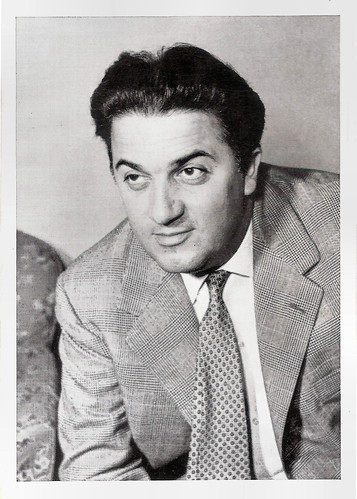
Federico Fellini. German cigarette card.
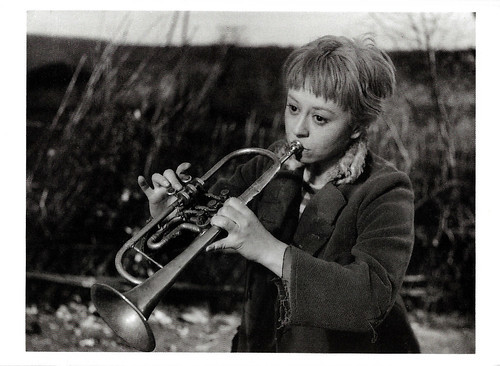
Swiss postcard by Collection Cinémathéque Suisse, Lausanne / News Productions, Baulmes, no. 56518. Photo: Ponti - De Laurentis. Giulietta Masina as Gelsomina in La Strada (Federico Fellini, 1954).
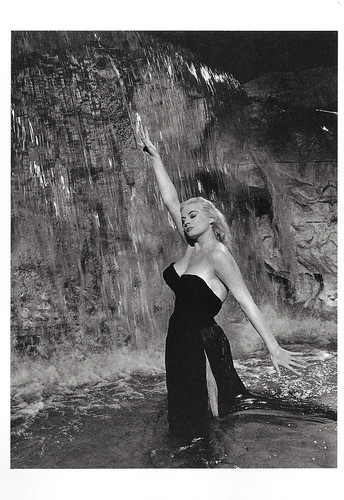
French postcard in the Collection Magie Noire by Editions Hazan, Paris, no. 6323. Anita Ekberg in La dolce vita (Federico Fellini, 1960).
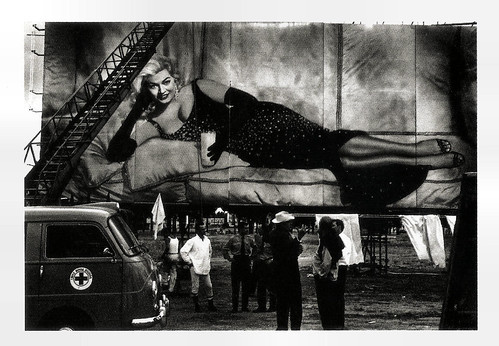
French postcard. Photo: Nicolas Tikhomiroff / Magnum Photos. Caption: Federico Fellini in great discussion during the filming of his segment of Boccaccio '70 (Vittorio De Sica, Luchino Visconti, Federico Fellini, Mario Monicelli, 1962), the Roman studios of Cinecitta in 1961.

Swiss postcard by Musée de l'Elysée, Lausanne / News Productions, Baulmes, no. 55108. Photo: Michelangelo Durazzo / AMA, Paris. Federico Fellini directing a scene of the film 8½ (1963).
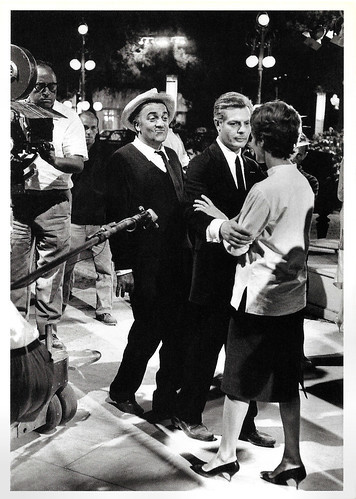
Swiss postcard by News Productions, Baulmes, no. 55590. Photo: Michelangelo Durazzo / ANA / Musée de l'Elysée, Lausanne, Switzerland. Caption: Federico Fellini directing a scene of the film 8 1/2 (1963) with Marcello Mastroianni and Anouk Aimee.

French postcard by Éditions Hazan, Paris, 1988. Photo: Sam Levin, 1969. Federico Fellini at the set of Satyricon (1969).
Observing how Italian films were made
Federico Fellini was born in 1920 in Rimini in the Emilia-Romagna region. His native Rimini and characters there like Saraghina (the devil herself said the priests who ran his school) - and the Gambettola farmhouse of his paternal grandmother would later be remembered in several of his films. His traveling salesman father Urbano Fellini showed up in La dolce vita (1960) and 8½ (1963). His mother Ida Barbiani was from Rome and accompanied him there in 1939.
Fellini's first passion was the theatre, and at the age of 12, he briefly ran away from home to join the circus, later entering college solely to avoid being drafted. He enrolled in the University of Rome. Intrigued by the image of reporters in American films, he tried out the real-life role of a journalist. Additionally, Fellini worked as an artist on fumetti (Italy's illustrated magazines), and occasionally even made his living as a caricaturist at Roman restaurants.
He caught the attention of several editors with his caricatures and cartoons and then started submitting articles. Several articles were recycled into a radio series about newlyweds 'Cico and Pallina'. Pallina was played by acting student Giulietta Masina , who became Fellini's real-life wife in 1943. They remained together until his death.
The young Fellini loved vaudeville and was befriended in 1939 by leading comedian Aldo Fabrizi. Fabrizi recruited Fellini to supply stories and ideas for his performances between 1939 and 1944. The two men worked in tandem on a number of largely forgotten film comedies, among them No Me Lo Dire!/Do not tell me! (Mario Mattoli, 1940) starring Erminio Macario, Quarta pagina/3/4 of a Page (Nicola Manzari, 1942), and Campo de Fiori (Mario Bonnard, 1943).
When young director Roberto Rossellini wanted Fabrizi to play Don Pietro in Roma città aperta/Rome, Open City (Roberto Rosselini, 1945), he made the contact through Fellini. Federico Fellini worked on that film's script and is also on the credits for Rosselini's Paisà/Paisan (Roberto Rosselini, 1946). Dale O'Connor at IMDb : "On that film, he wandered into the editing room, started observing how Italian films were made (a lot like the old silent films with an emphasis on visual effects, dialogue dubbed in later). Fellini in his mid-20s had found his life's work."
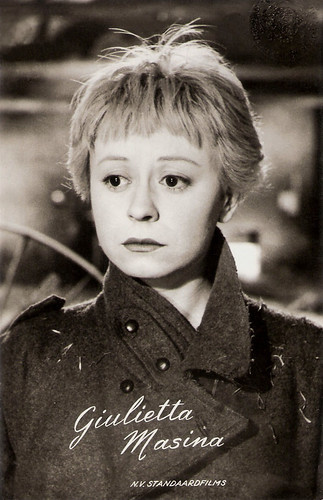
Dutch postcard by Uitg. Takken, Utrecht, no. 3381. Photo: N.V. Standaardfilms. Giulietta Masina as Gelsomina in La strada (Federico Fellini, 1954).
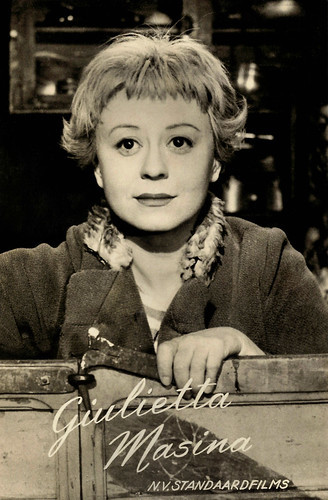
Dutch postcard by Uitg. Takken, Utrecht, no. 3382. Photo: N.V. Standaardfilms. Giulietta Masina in La Strada (Federico Fellini, 1954).
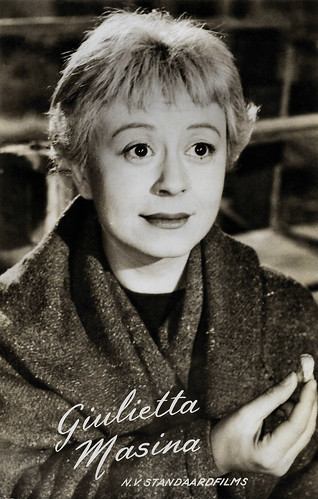
Dutch postcard by Uitg. Takken, Utrecht, no. 3383. Photo: N.V. Standaardfilms. Giulietta Masina in La Strada (Federico Fellini, 1954).
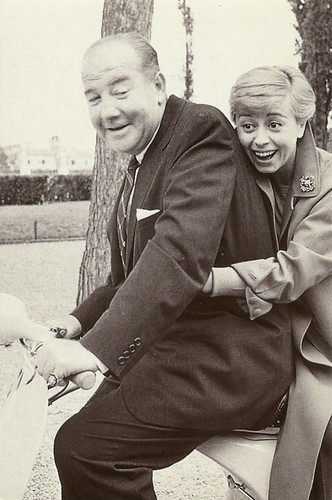
Italian postcard by Ed Graphicarta, Pontedera for Kit Postcards Vespa. Photo: Piaggio. Broderick Crawford and Giulietta Masina together on a Vespa. They played together in Il bidone/The Swindle (Federico Fellini, 1955).
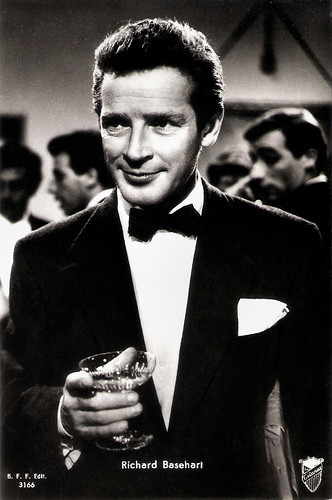
Italian postcard by B.F.F. Edit., no. 3166. Photo: G.B. Poletto /Titanus. Richard Basehart in Il bidone/The Swindle (Federico Fellini, 1955).
Sex and death in Rome's high society
Federico Fellini collaborated on films by Pietro Germi, including In nome della legge/In the Name of the Law (Pietro Germi, 1949) and Il Cammino Della Speranza/The Path of Hope (Pietro Germi, 1950), and Alberto Lattuda, including Il Delitto di Giovanni Episcopo/Flesh Will Surrender (Alberto Lattuada, 1947) with Aldo Fabrizi, and Il Mulino del Po (Pietro Germi, 1949) with Carla Del Poggio .
In 1948, Fellini completed the screenplay for Il Miracolo/The Miracle, the second and longer section of Rossellini's two-part effort Amore/Ways of Love (Roberto Rossellini, 1948). Here Fellini's utterly original worldview first began to truly take shape in the form of archetypal characters (a simple-minded peasant girl and her male counterpart, a kind of holy simpleton), recurring motifs (show business, parties, the sea), and an ambiguous relationship with religion and spirituality. He further explored this in his script for Rossellini's Francesco, Giullare di Dio/The Flowers of St. Francis (Roberto Rosselini, 1949), featuring Aldo Fabrizi.
In 1950, Fellini made his first attempt at directing one of his own screenplays with the help of Alberto Lattuda, Luci del Varieta (Federico Fellini, Alberto Lattudada, 1950), starring Peppino De Filippo , Carla Del Poggio , and Giulietta Masina . The film further developed his fusion of Neorealism with the atmosphere of Surrealism. Fellini then directed the romantic satire Lo sceicco bianco/The White Sheik (Federico Fellini, 1952) featuring Alberto Sordi . The film marked his first work with composer Nino Rota.
Fellini's initial masterpiece, I Vitteloni/Spivs, followed in 1953. The first of his features to receive international distribution, it later won the Silver Lion at the Venice Film Festival, the first of many similar honours.
The brilliant La Strada/The Road (Federico Fellini, 1954) starring Anthony Quinn and Giulieta Masina followed. The film garnered the Silver Lion as well as the Oscar for Best Foreign Language Picture. After helming Il Bidone/The Swindle (1955), Fellini and a group of screenwriters (including a young Pier Paolo Pasolini) began work on Le Notti di Cabiria/Nights of Cabiria (Federico Fellini, 1957), which also won an Oscar.
Then he mounted La Dolce Vita/The Sweet Life (Federico Fellini, 1960), the first of his pictures to star actor Marcello Mastroianni . He would become Fellini's cinematic alter ego over the course of several subsequent collaborations. La Dolce Vita's portrait of sex and death in Rome's high society created a tremendous scandal at its Milan premiere, where the audience booed, insulted, and spat on the director. Regardless, La Dolce Vita won the Palm d'Or at the Cannes Film Festival and remains a landmark in cinematic history.
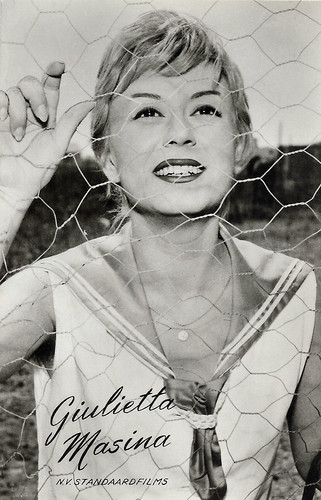
Dutch postcard by Uitg. Takken, Utrecht, no. 3380. Photo: N.V. Standaardfilms. Giulietta Masina in Le notti di Cabiria (Federico Fellini, 1957).
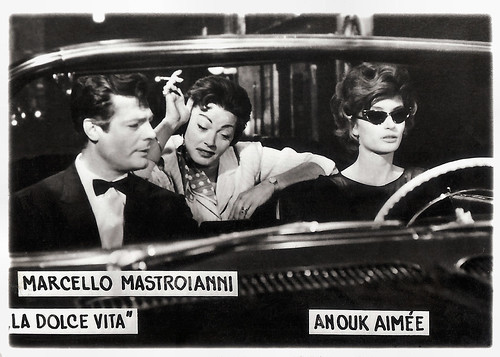
Small Romanian collectors card by Casa Filmului Acin. Photo: Marcello Mastroianni and Anouk Aimée in La Dolce Vita (Federico Fellini, 1960).
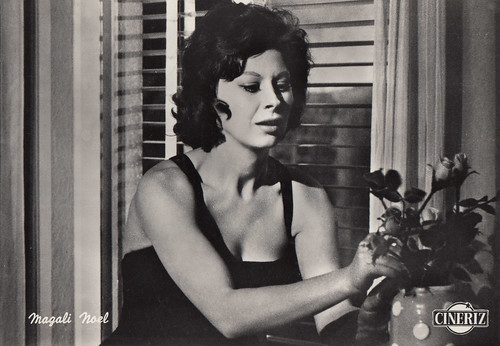
Italian postcard by Bromofoto, Milano, no. 1703. Photo: Cineriz. Magali Noël in La Dolce Vita (Federico Fellini, 1960). Collection: Marlene Pilaete.
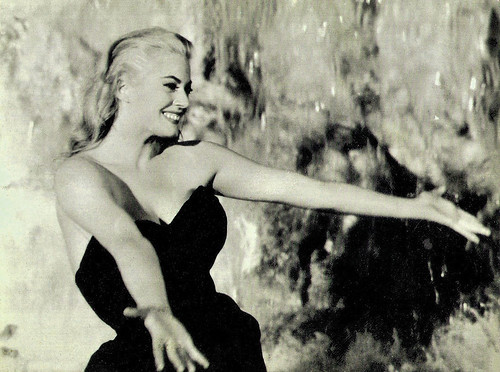
Italian postcard by La Rotografica Romana. Photo: Pierluigi / Riama Film / Cineriz. Anita Ekberg in La Dolce Vita (Federico Fellini, 1960).
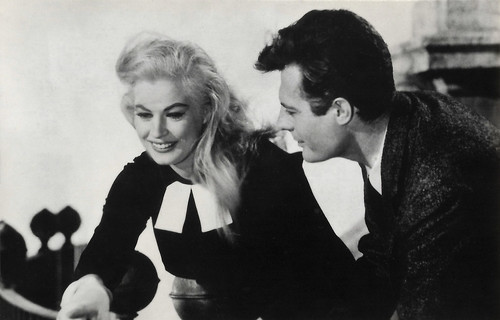
Small Czechoslovakian card by Pressfoto, Praha (Prague), no. S 83/7, 1965. Retail price: 0,50 Kcs. Anita Ekberg and Marcello Mastroianni in La dolce vita (Federico Fellini, 1960).
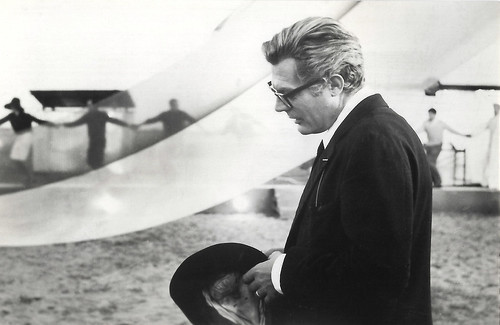
Small Czechoslovakian card by Presseojo, Praha (Prague), no. 83/9, 1965. Retail price: 0,50 Kcs. Marcello Mastroianni in 8½ (Federico Fellini, 1963).
Life and dreams as raw material for films
During the 1960s, many films by Federico Fellini were influenced by the work of Swiss psychiatrist Carl Jung and his ideas on the role of archetypes and the collective unconscious. The women who had both attracted and frightened him in his youth and an Italy dominated in his youth by Benito Mussolini and Pope Pius XII inspired Fellini's dreams.
In the 1960s, he started to record them in notebooks, and life and dreams became the raw material for such films as 8½ (Federico Fellini, 1963) or Fellini - Satyricon (Federico Fellini, 1969). With Giulietta Degli Spiriti/Juliet of the Spirits (Federico Fellini, 1965), Fellini worked for the first time in colour.
After experimenting with LSD under the supervision of doctors, he began scripting Il Viaggio di G. Mastorna. Over a year of pre-production followed, hampered by difficulties with producers, actors, and even a jury trial. Finally on 10 April 1967, Fellini suffered a nervous breakdown, resulting in a month-long nursing homestay. Ultimately, he gave up on ever bringing Il Viaggio di G. Mastorna to the screen, and his new producer, Alberto Grimaldi, was forced to buy out former producer Dino De Laurentis for close to half a billion liras.
As the decade drew to a close, Fellini returned to work with a vengeance, first resurfacing with Toby Dammitt, a short feature for the collaborative film Tre Passi nel Delirio/Histoires extraordinaires/Spirits of the Dead (Federico Fellini, Louis Malle, Roger Vadim, 1968). Turning to television, he helmed Fellini: A Director's Notebook (Federico Fellini, 1969), a one-hour special for NBC, followed by the feature effort Fellini - Satyricon (Federico Fellini, 1969). I Clowns/The Clowns followed in 1970, with Roma/Fellini's Roma bowing in 1972.
Amarcord (Federico Fellini, 1973), a childhood reminiscence, won a fourth Academy Award in 1974. It proved to be his final international success. He later shot Il Casanova di Federico Fellini/Casanova (Federico Fellini, 1976) with Donald Sutherland, Prova d'Orchestra/Orchestra Rehearsal (Federico Fellini, 1979), and La Citta delle Donne/The City of Women (Federico Fellini, 1980), which were less successful.
Fellini turned to publishing with 'Fare un Film', an anthology of notes about his life and work. E la Nave Va/The Ship Sails On (Federico Fellini, 1983) and Ginger e Fred/Ginger & Fred (Federico Fellini, 1985) followed, but by the time of L'Intervista (Federico Fellini, 1987), he was facing considerable difficulty finding financing for his projects. His last completed film was La Voce Della Luna/The Voice of the Moon (Federico Fellini, 1989) with Roberto Benigni .
In the early 1990s, Fellini helmed a handful of television commercials, and in 1993 he won his fifth Academy Award for a lifetime of service to the film industry. In 1993, Federico Fellini died the day after his 50th wedding anniversary. He was 73 years old.
Jason Ankeny at AllMovie : "One of the most visionary figures to emerge from the fertile motion picture community of postwar-era Italy, Federico Fellini brought a new level of autobiographical intensity to his craft; more than any other filmmaker of his era, he transformed the realities of his life into the surrealism of his art. Though originally a product of the neorealist school, the eccentricity of Fellini's characterizations and his absurdist sense of comedy set him squarely apart from contemporaries like Vittorio De Sica or Roberto Rossellini, and at the peak of his career his work adopted a distinctively poetic, flamboyant, and influential style so unique that only the term 'Felliniesqu'" could accurately describe it."
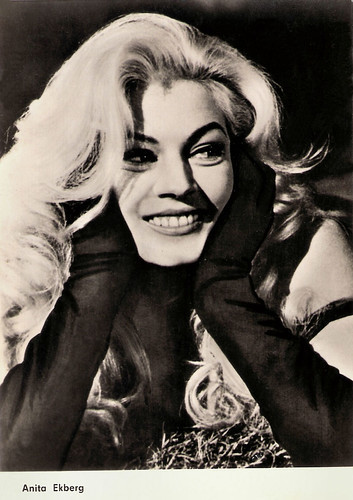
East-German postcard by VEB Progress FilmVertrieb, Berlin, no. 2391, 1965. Photo: Anita Ekberg in Boccaccio '70 (Federico Fellini, 1962).
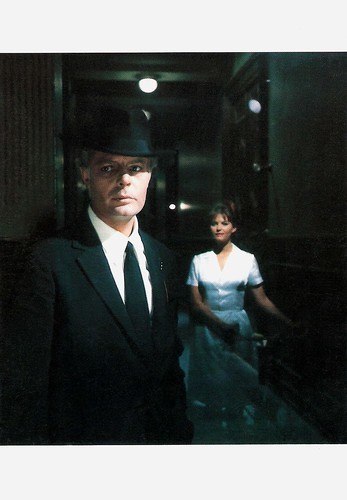
French postcard by Edition La Malibran, Paris, no. MC 38, 1990. Photo: Claude Schwartz. Marcello Mastroianni and Claudia Cardinale in Otto e Mezzo/8½ (Federico Fellini, 1963).
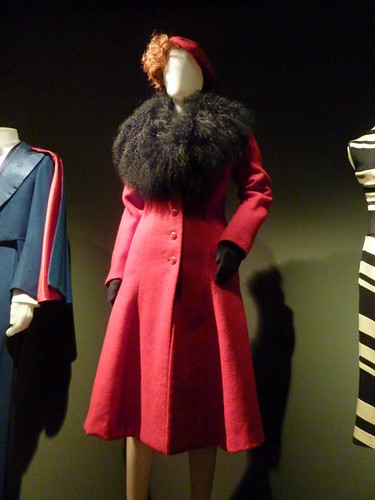
Costume in Cinecittà, Rome of Magali Noël (Gradisca) in Amarcord (Federico Fellini, 1973).
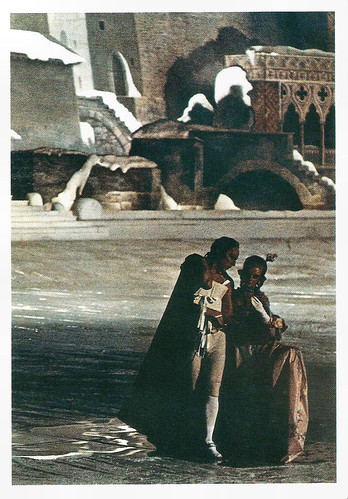
French postcard in the Collection Cinéma Couleur by Editions Le Malibran, Nancy, no. MC 40. Donald Sutherland in Il Casanova di Federico Fellini (Federico Fellini, 1976).
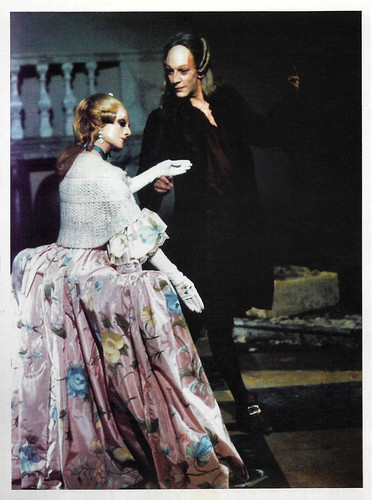
Italian postcard in the Federico Fellini series by Gruppo Prospettive. Photo: F. Pinna / RAM Studio. Donald Sutherland in Il Casanova di Federico Fellini (Federico Fellini, 1976).
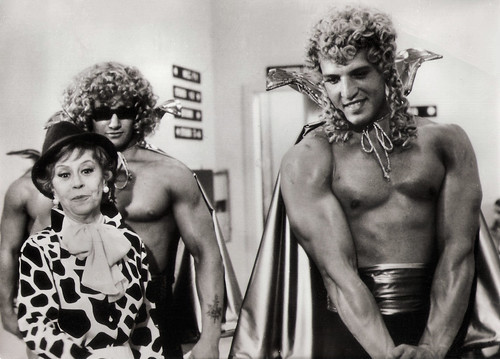
German press photo by Tobis. Giulietta Masina in Ginger e Fred (Federico Fellini, 1986).
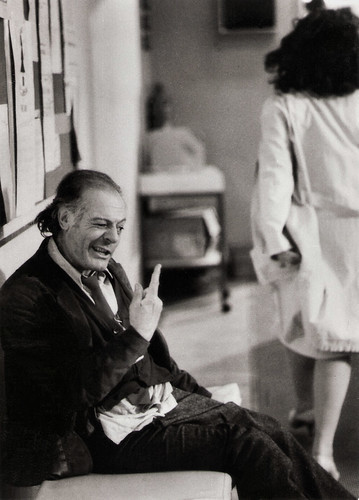
German press photo, no. 5. Photo: Tobis. Marcello Mastroianni in Ginger e Fred (Federico Fellini, 1986).
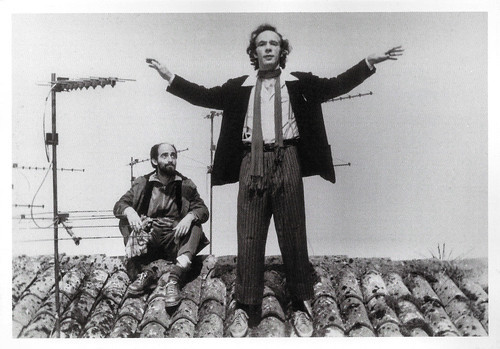
French postcard by DR. Photo: La Cinémathèque Française. Roberto Benigni and Angelo Orlando in La Voce della luna/The Voice of the Moon (Federico Fellini, 1990).
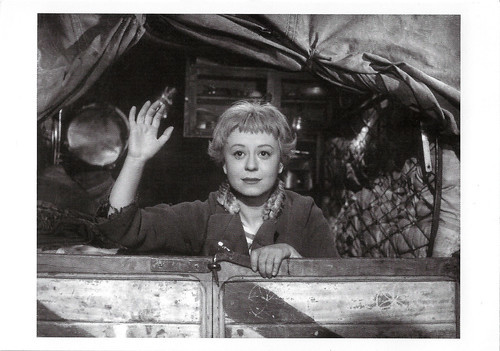
French postcard by DR / Le Cinémathéque Française. Giulietta Masina as Gelsomina in La Strada (Federico Fellini, 1954).
Source: Jason Ankeny (AllMovie), (IMDb), Wikipedia, and .

Federico Fellini. German cigarette card.

Swiss postcard by Collection Cinémathéque Suisse, Lausanne / News Productions, Baulmes, no. 56518. Photo: Ponti - De Laurentis. Giulietta Masina as Gelsomina in La Strada (Federico Fellini, 1954).

French postcard in the Collection Magie Noire by Editions Hazan, Paris, no. 6323. Anita Ekberg in La dolce vita (Federico Fellini, 1960).

French postcard. Photo: Nicolas Tikhomiroff / Magnum Photos. Caption: Federico Fellini in great discussion during the filming of his segment of Boccaccio '70 (Vittorio De Sica, Luchino Visconti, Federico Fellini, Mario Monicelli, 1962), the Roman studios of Cinecitta in 1961.

Swiss postcard by Musée de l'Elysée, Lausanne / News Productions, Baulmes, no. 55108. Photo: Michelangelo Durazzo / AMA, Paris. Federico Fellini directing a scene of the film 8½ (1963).

Swiss postcard by News Productions, Baulmes, no. 55590. Photo: Michelangelo Durazzo / ANA / Musée de l'Elysée, Lausanne, Switzerland. Caption: Federico Fellini directing a scene of the film 8 1/2 (1963) with Marcello Mastroianni and Anouk Aimee.

French postcard by Éditions Hazan, Paris, 1988. Photo: Sam Levin, 1969. Federico Fellini at the set of Satyricon (1969).
Observing how Italian films were made
Federico Fellini was born in 1920 in Rimini in the Emilia-Romagna region. His native Rimini and characters there like Saraghina (the devil herself said the priests who ran his school) - and the Gambettola farmhouse of his paternal grandmother would later be remembered in several of his films. His traveling salesman father Urbano Fellini showed up in La dolce vita (1960) and 8½ (1963). His mother Ida Barbiani was from Rome and accompanied him there in 1939.
Fellini's first passion was the theatre, and at the age of 12, he briefly ran away from home to join the circus, later entering college solely to avoid being drafted. He enrolled in the University of Rome. Intrigued by the image of reporters in American films, he tried out the real-life role of a journalist. Additionally, Fellini worked as an artist on fumetti (Italy's illustrated magazines), and occasionally even made his living as a caricaturist at Roman restaurants.
He caught the attention of several editors with his caricatures and cartoons and then started submitting articles. Several articles were recycled into a radio series about newlyweds 'Cico and Pallina'. Pallina was played by acting student Giulietta Masina , who became Fellini's real-life wife in 1943. They remained together until his death.
The young Fellini loved vaudeville and was befriended in 1939 by leading comedian Aldo Fabrizi. Fabrizi recruited Fellini to supply stories and ideas for his performances between 1939 and 1944. The two men worked in tandem on a number of largely forgotten film comedies, among them No Me Lo Dire!/Do not tell me! (Mario Mattoli, 1940) starring Erminio Macario, Quarta pagina/3/4 of a Page (Nicola Manzari, 1942), and Campo de Fiori (Mario Bonnard, 1943).
When young director Roberto Rossellini wanted Fabrizi to play Don Pietro in Roma città aperta/Rome, Open City (Roberto Rosselini, 1945), he made the contact through Fellini. Federico Fellini worked on that film's script and is also on the credits for Rosselini's Paisà/Paisan (Roberto Rosselini, 1946). Dale O'Connor at IMDb : "On that film, he wandered into the editing room, started observing how Italian films were made (a lot like the old silent films with an emphasis on visual effects, dialogue dubbed in later). Fellini in his mid-20s had found his life's work."

Dutch postcard by Uitg. Takken, Utrecht, no. 3381. Photo: N.V. Standaardfilms. Giulietta Masina as Gelsomina in La strada (Federico Fellini, 1954).

Dutch postcard by Uitg. Takken, Utrecht, no. 3382. Photo: N.V. Standaardfilms. Giulietta Masina in La Strada (Federico Fellini, 1954).

Dutch postcard by Uitg. Takken, Utrecht, no. 3383. Photo: N.V. Standaardfilms. Giulietta Masina in La Strada (Federico Fellini, 1954).

Italian postcard by Ed Graphicarta, Pontedera for Kit Postcards Vespa. Photo: Piaggio. Broderick Crawford and Giulietta Masina together on a Vespa. They played together in Il bidone/The Swindle (Federico Fellini, 1955).

Italian postcard by B.F.F. Edit., no. 3166. Photo: G.B. Poletto /Titanus. Richard Basehart in Il bidone/The Swindle (Federico Fellini, 1955).
Sex and death in Rome's high society
Federico Fellini collaborated on films by Pietro Germi, including In nome della legge/In the Name of the Law (Pietro Germi, 1949) and Il Cammino Della Speranza/The Path of Hope (Pietro Germi, 1950), and Alberto Lattuda, including Il Delitto di Giovanni Episcopo/Flesh Will Surrender (Alberto Lattuada, 1947) with Aldo Fabrizi, and Il Mulino del Po (Pietro Germi, 1949) with Carla Del Poggio .
In 1948, Fellini completed the screenplay for Il Miracolo/The Miracle, the second and longer section of Rossellini's two-part effort Amore/Ways of Love (Roberto Rossellini, 1948). Here Fellini's utterly original worldview first began to truly take shape in the form of archetypal characters (a simple-minded peasant girl and her male counterpart, a kind of holy simpleton), recurring motifs (show business, parties, the sea), and an ambiguous relationship with religion and spirituality. He further explored this in his script for Rossellini's Francesco, Giullare di Dio/The Flowers of St. Francis (Roberto Rosselini, 1949), featuring Aldo Fabrizi.
In 1950, Fellini made his first attempt at directing one of his own screenplays with the help of Alberto Lattuda, Luci del Varieta (Federico Fellini, Alberto Lattudada, 1950), starring Peppino De Filippo , Carla Del Poggio , and Giulietta Masina . The film further developed his fusion of Neorealism with the atmosphere of Surrealism. Fellini then directed the romantic satire Lo sceicco bianco/The White Sheik (Federico Fellini, 1952) featuring Alberto Sordi . The film marked his first work with composer Nino Rota.
Fellini's initial masterpiece, I Vitteloni/Spivs, followed in 1953. The first of his features to receive international distribution, it later won the Silver Lion at the Venice Film Festival, the first of many similar honours.
The brilliant La Strada/The Road (Federico Fellini, 1954) starring Anthony Quinn and Giulieta Masina followed. The film garnered the Silver Lion as well as the Oscar for Best Foreign Language Picture. After helming Il Bidone/The Swindle (1955), Fellini and a group of screenwriters (including a young Pier Paolo Pasolini) began work on Le Notti di Cabiria/Nights of Cabiria (Federico Fellini, 1957), which also won an Oscar.
Then he mounted La Dolce Vita/The Sweet Life (Federico Fellini, 1960), the first of his pictures to star actor Marcello Mastroianni . He would become Fellini's cinematic alter ego over the course of several subsequent collaborations. La Dolce Vita's portrait of sex and death in Rome's high society created a tremendous scandal at its Milan premiere, where the audience booed, insulted, and spat on the director. Regardless, La Dolce Vita won the Palm d'Or at the Cannes Film Festival and remains a landmark in cinematic history.

Dutch postcard by Uitg. Takken, Utrecht, no. 3380. Photo: N.V. Standaardfilms. Giulietta Masina in Le notti di Cabiria (Federico Fellini, 1957).

Small Romanian collectors card by Casa Filmului Acin. Photo: Marcello Mastroianni and Anouk Aimée in La Dolce Vita (Federico Fellini, 1960).

Italian postcard by Bromofoto, Milano, no. 1703. Photo: Cineriz. Magali Noël in La Dolce Vita (Federico Fellini, 1960). Collection: Marlene Pilaete.

Italian postcard by La Rotografica Romana. Photo: Pierluigi / Riama Film / Cineriz. Anita Ekberg in La Dolce Vita (Federico Fellini, 1960).

Small Czechoslovakian card by Pressfoto, Praha (Prague), no. S 83/7, 1965. Retail price: 0,50 Kcs. Anita Ekberg and Marcello Mastroianni in La dolce vita (Federico Fellini, 1960).

Small Czechoslovakian card by Presseojo, Praha (Prague), no. 83/9, 1965. Retail price: 0,50 Kcs. Marcello Mastroianni in 8½ (Federico Fellini, 1963).
Life and dreams as raw material for films
During the 1960s, many films by Federico Fellini were influenced by the work of Swiss psychiatrist Carl Jung and his ideas on the role of archetypes and the collective unconscious. The women who had both attracted and frightened him in his youth and an Italy dominated in his youth by Benito Mussolini and Pope Pius XII inspired Fellini's dreams.
In the 1960s, he started to record them in notebooks, and life and dreams became the raw material for such films as 8½ (Federico Fellini, 1963) or Fellini - Satyricon (Federico Fellini, 1969). With Giulietta Degli Spiriti/Juliet of the Spirits (Federico Fellini, 1965), Fellini worked for the first time in colour.
After experimenting with LSD under the supervision of doctors, he began scripting Il Viaggio di G. Mastorna. Over a year of pre-production followed, hampered by difficulties with producers, actors, and even a jury trial. Finally on 10 April 1967, Fellini suffered a nervous breakdown, resulting in a month-long nursing homestay. Ultimately, he gave up on ever bringing Il Viaggio di G. Mastorna to the screen, and his new producer, Alberto Grimaldi, was forced to buy out former producer Dino De Laurentis for close to half a billion liras.
As the decade drew to a close, Fellini returned to work with a vengeance, first resurfacing with Toby Dammitt, a short feature for the collaborative film Tre Passi nel Delirio/Histoires extraordinaires/Spirits of the Dead (Federico Fellini, Louis Malle, Roger Vadim, 1968). Turning to television, he helmed Fellini: A Director's Notebook (Federico Fellini, 1969), a one-hour special for NBC, followed by the feature effort Fellini - Satyricon (Federico Fellini, 1969). I Clowns/The Clowns followed in 1970, with Roma/Fellini's Roma bowing in 1972.
Amarcord (Federico Fellini, 1973), a childhood reminiscence, won a fourth Academy Award in 1974. It proved to be his final international success. He later shot Il Casanova di Federico Fellini/Casanova (Federico Fellini, 1976) with Donald Sutherland, Prova d'Orchestra/Orchestra Rehearsal (Federico Fellini, 1979), and La Citta delle Donne/The City of Women (Federico Fellini, 1980), which were less successful.
Fellini turned to publishing with 'Fare un Film', an anthology of notes about his life and work. E la Nave Va/The Ship Sails On (Federico Fellini, 1983) and Ginger e Fred/Ginger & Fred (Federico Fellini, 1985) followed, but by the time of L'Intervista (Federico Fellini, 1987), he was facing considerable difficulty finding financing for his projects. His last completed film was La Voce Della Luna/The Voice of the Moon (Federico Fellini, 1989) with Roberto Benigni .
In the early 1990s, Fellini helmed a handful of television commercials, and in 1993 he won his fifth Academy Award for a lifetime of service to the film industry. In 1993, Federico Fellini died the day after his 50th wedding anniversary. He was 73 years old.
Jason Ankeny at AllMovie : "One of the most visionary figures to emerge from the fertile motion picture community of postwar-era Italy, Federico Fellini brought a new level of autobiographical intensity to his craft; more than any other filmmaker of his era, he transformed the realities of his life into the surrealism of his art. Though originally a product of the neorealist school, the eccentricity of Fellini's characterizations and his absurdist sense of comedy set him squarely apart from contemporaries like Vittorio De Sica or Roberto Rossellini, and at the peak of his career his work adopted a distinctively poetic, flamboyant, and influential style so unique that only the term 'Felliniesqu'" could accurately describe it."

East-German postcard by VEB Progress FilmVertrieb, Berlin, no. 2391, 1965. Photo: Anita Ekberg in Boccaccio '70 (Federico Fellini, 1962).

French postcard by Edition La Malibran, Paris, no. MC 38, 1990. Photo: Claude Schwartz. Marcello Mastroianni and Claudia Cardinale in Otto e Mezzo/8½ (Federico Fellini, 1963).

Costume in Cinecittà, Rome of Magali Noël (Gradisca) in Amarcord (Federico Fellini, 1973).

French postcard in the Collection Cinéma Couleur by Editions Le Malibran, Nancy, no. MC 40. Donald Sutherland in Il Casanova di Federico Fellini (Federico Fellini, 1976).

Italian postcard in the Federico Fellini series by Gruppo Prospettive. Photo: F. Pinna / RAM Studio. Donald Sutherland in Il Casanova di Federico Fellini (Federico Fellini, 1976).

German press photo by Tobis. Giulietta Masina in Ginger e Fred (Federico Fellini, 1986).

German press photo, no. 5. Photo: Tobis. Marcello Mastroianni in Ginger e Fred (Federico Fellini, 1986).

French postcard by DR. Photo: La Cinémathèque Française. Roberto Benigni and Angelo Orlando in La Voce della luna/The Voice of the Moon (Federico Fellini, 1990).

French postcard by DR / Le Cinémathéque Française. Giulietta Masina as Gelsomina in La Strada (Federico Fellini, 1954).
Source: Jason Ankeny (AllMovie), (IMDb), Wikipedia, and .
Published on November 11, 2020 22:00
November 10, 2020
Jackie Cooper
American actor, television director, producer, and executive Jackie Cooper (1922-2011) was one of the most popular child stars of the 1930s. He was endearing to audiences with his ability to make them laugh or cry. Jackie is also the youngest performer to have been nominated for an Oscar for Best Actor in a Leading Role, for Skippy (1931). He was one of the few child actors who managed to make the transition to an adult career. In later life, he produced and directed over 250 films and television shows.

Dutch postcard by J.S.A., no. 184. Photo: Metro-Goldwyn-Mayer. Jackie Cooper in The Champ (King Vidor, 1931). Sent by mail in 1932.
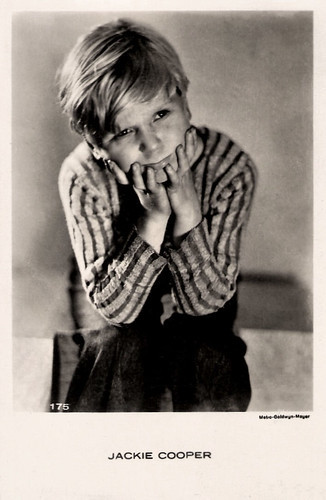
Dutch postcard, no. 175. Photo: Metro-Goldwyn-Mayer. Jackie Cooper in The Champ (King Vidor, 1931).

Dutch postcard, no. 152. Photo: Metro-Goldwyn-Mayer. Jackie Cooper in The Champ (King Vidor, 1931).
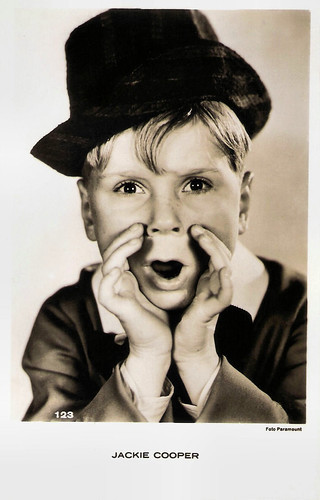
Dutch postcard, no. 1235. Photo: Paramount. Jackie Cooper in Skippy (Norman Taurog, 1931).
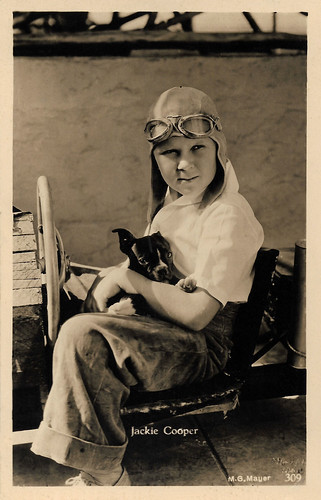
Dutch postcard, no. 309. Photo: Metro-Goldwyn-Mayer. Jackie Cooper in Skippy (Norman Taurog, 1931).
One of Our Gang's major characters
Jackie Cooper was born as John Cooper Jr. in 1922 in Los Angeles, California. Cooper's father, John Cooper, left the family when Jackie was 2 years old. The two never reunited after he had left the family. His mother, Mabel Leonard Bigelow (née Polito), was a stage pianist. Cooper's maternal uncle, Jack Leonard, was a screenwriter and his maternal aunt, Julie Leonard, was an actress married to director Norman Taurog. Cooper's stepfather was C.J. Bigelow, a studio production manager.
Cooper first appeared in films as an extra with his grandmother, who took him to her auditions hoping it would help her get extra work. At age 3, Jackie appeared in Bobby Clark and Lloyd Hamilton comedies under the name of 'Leonard'. Cooper graduated to bit parts in feature films such as Fox Movietone Follies of 1929 (David Butler, 1929) and Sunny Side Up (David Butler, 1929) with Janet Gaynor .
His director in those films, David Butler, recommended Cooper to director Leo McCarey, who arranged an audition for the Our Gang comedy series produced by Hal Roach. In 1929, Cooper signed a three-year contract after joining the series in the short Boxing Gloves (Robert A. McGowan, 1929). He initially was to be a supporting character in the series, but by early 1930 his success in transitioning to sound films enabled him to become one of Our Gang's major characters. He appeared in 15 shorts over the next two years.
He was the main character in the episodes The First Seven Years (Robert A. McGowan, 1930) and When the Wind Blows (James W. Horne, 1930). His most notable Our Gang shorts explore his crush on Miss Crabtree, the schoolteacher played by June Marlowe: Teacher's Pet (Robert A. McGowan, 1930), School's Out (Robert A. McGowan, 1930), and Love Business (Robert A. McGowan, 1930).
In 1931, while under contract to Hal Roach Studios, Jackie Cooper was loaned to Paramount to star in Skippy (1931), directed by his uncle, Norman Taurog. At age 9, Cooper was nominated for an Academy Award for Best Actor, the youngest actor to be nominated for such an Oscar. Although Paramount paid Roach $25,000 for Cooper's services, Roach paid Cooper a standard salary of $50 per week.
Our Gang producer Hal Roach sold Jackie's contract to Metro-Goldwyn-Mayer in 1931. Cooper acted with Wallace Beery in The Champ (King Vidor, 1931), The Bowery (Raoul Walsh, 1933), Treasure Island (Victor Fleming, 1934), and O'Shaughnessy's Boy (Richard Boleslawski, 1935). In his autobiography, Cooper wrote that Beery was a disappointment and accused him of upstaging him and attempting to undermine his performances out of jealousy.
Cooper outgrew his preteen cuteness by the late 1930s and was forced to accept whatever work that came along. he enjoyed the occasional plum role in such films as The Return of Frank James (Fritz Lang, 1940) with Henry Fonda , and the first two Henry Aldrich films, What a Life (Theodore Reed, 1939) and Life with Henry (Theodore Reed, 1941). Cooper served in the U.S. Navy during World War II, remaining in the reserves until 1982, retiring at the rank of captain and receiving the Legion of Merit.
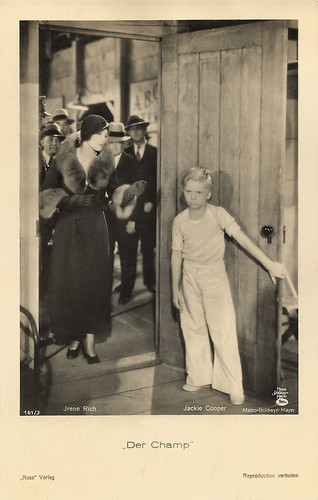
German postcard by Ross Verlag, no. 161/3. Photo: Metro-Goldwyn-Mayer Jackie Cooper in The Champ (King Vidor, 1931).
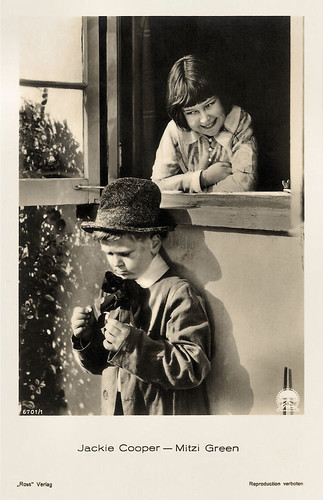
German postcard by Ross Verlag, no. 6701/1, 1931-1932. Photo: Paramount. Jackie Cooper and Mitzi Green in Skippy (Norman Taurog, 1931).
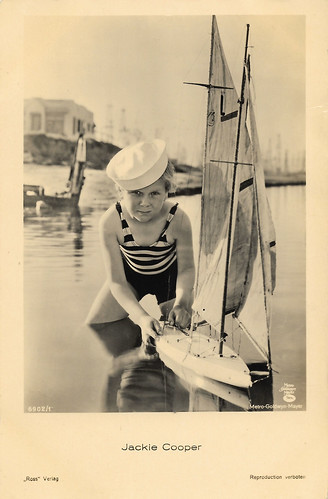
German postcard by Ross Verlag, no. 6902/1, 1931-1932. Photo: Metro-Goldwyn-Mayer.
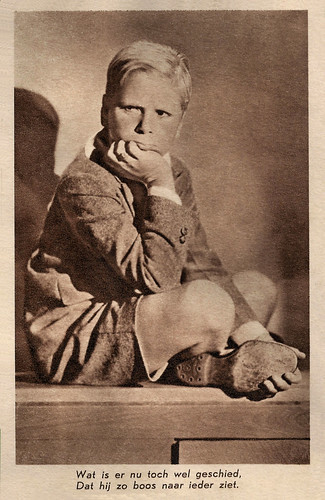
Dutch postcard. Sent by mail in 1938. Photo: Jackie Cooper in Skippy (Norman Taurog, 1931). Caption: What has happened now. That he looks so angry at everyone.
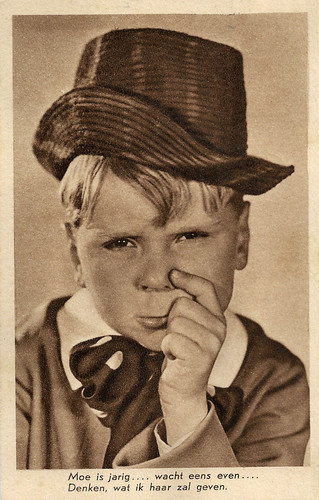
Dutch postcard. Sent by mail in 1938. Photo: Jackie Cooper in Skippy (Norman Taurog, 1931). Caption: It's Mum's birthday... wait a second ... Think, what will I give her.
Please Don't Shoot My Dog
After the war, Jackie Cooper was cast in a stage production of 'Mr. Roberts' (1950) in Boston, Massachusetts in the role of Ensign Pulver. In 1954, he guest-starred on TV in the legal drama Justice. He starred in two television sitcoms, The People's Choice (1955-1958) with Patricia Breslin and Hennesey (1959-1962) with Abby Dalton.
From 1964 to 1969, Cooper was vice president of program development at Columbia Pictures Screen Gems TV division. He was responsible for packaging series such as Bewitched and selling them to the networks. In 1964, Cooper appeared in Rod Serling's The Twilight Zone episode Caesar and Me, and in the made-for-television film Shadow on the Land (Richard C. Sarafian, 1968). Cooper left Columbia in 1969.
He appeared in the fourth season of Hawaii Five-O in an episode called The Burning Ice (1971), in Candidate for Crime (1973) starring Peter Falk as Columbo, and in the series Mobile One (1975). Cooper’s work as director on episodes of M*A*S*H and The White Shadow earned him Emmy awards.
In the 1970s and 1980s, Cooper appeared as Daily Planet editor Perry White in the Superman film series, Superman (Richard Donner, 1978), Superman II (Richard Lester, 1980), Superman III (Richard Lester, 1983), and Superman IV: The Quest for Peace (Sidney J. Furie, 1987). He got the role after Keenan Wynn, who was originally cast as White, became unavailable after suffering a heart attack.
Cooper's final film role was as Ace Morgan in Surrender (Jerry Belson, 1987), starring Sally Field, Michael Caine , and Steve Guttenberg. Cooper announced his retirement in 1989, although he continued directing episodes of the syndicated series Superboy. He began spending more time training and racing horses at Hollywood Park and outside San Diego during the Del Mar racing season. Cooper lived in Beverly Hills from 1955 until his death.
Cooper's autobiography, 'Please Don't Shoot My Dog', was published in 1982. The title refers to an incident during the filming of Skippy, when Norman Taurog, who was directing Cooper in a crying scene, ordered a security guard to take away his dog and pretend to shoot him backstage. The stunt resulted in genuine tears; however, even upon discovering his dog was fine, Cooper was left with ill feelings toward his uncle.
For his contributions to the motion picture industry, Cooper was honored with a Hollywood Walk of Fame star located at 1507 Vine Street. Cooper died in 2011 from natural causes, in Santa Monica, California. He was survived by his two sons. He was interred at Arlington National Cemetery in Arlington, Virginia, in honor of his naval service.
Jackie Cooper was married to June Horne from 1944 until 1949, with whom he had a son, John 'Jack' Cooper, III (1946). June was the daughter of director James W. Horne and actress Cleo Ridgely. Cooper was married to Hildy Parks from 1950 until 1951 or 1954 (sources differ), and to Barbara Rae Kraus from 1954 until her death in 2009. Cooper and Kraus had three children, Russell (1956), Julie (1957-1997), and Cristina (1959-2009).
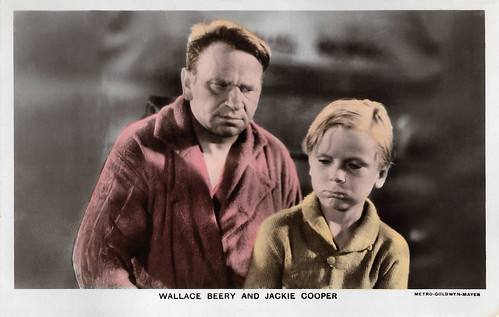
British postcard in the Film Partners Series, London, no. PC 71. Photo: Metro-Goldwyn-Mayer (MGM). Wallace Beery and Jackie Cooper in The Champ (King Vidor, 1931).
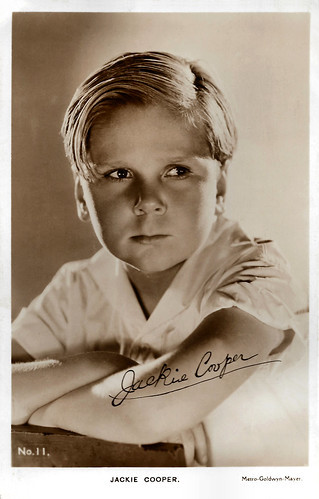
British postcard in the Film-Kurier Series, London, no. 11. Photo: Metro-Goldwyn-Mayer.
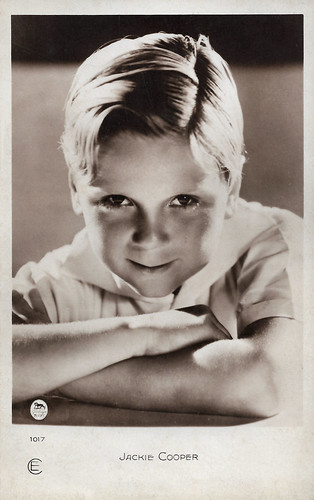
French postcard by Cinémagazine-Edition, no. 1017. Photo: Metro-Goldwyn-Mayer. Jackie Cooper in The Champ (King Vidor, 1931).
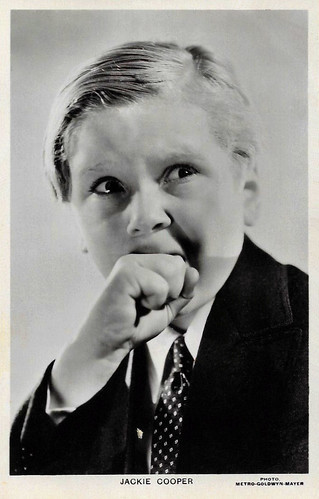
British postcard in the Picturegoer Series, London, no. 568a. Photo: Metro-Goldwyn-Mayer. Jackie Cooper in The Champ (King Vidor, 1931).

British postcard in the Film Partners Series, London, no. P 71. Photo: Metro-Goldwyn-Mayer (MGM). Wallace Beery and Jackie Cooper in The Champ (King Vidor, 1931).
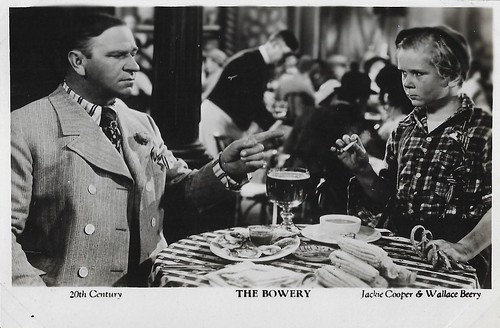
British postcard by Film Weekly. Photo: 20th Century / United Artists. Wallace Beery and Jackie Cooper in The Bowery (Raoul Walsh, 1933).
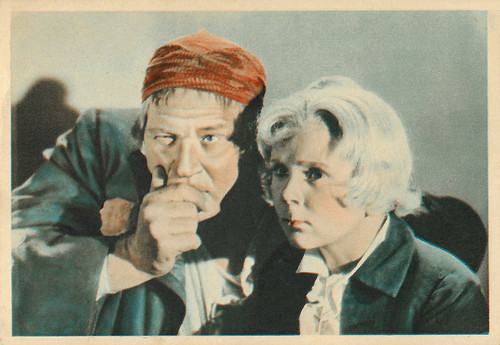
British postcard by De Reszke Cigarettes, no. 46. Photo: Metro-Goldwyn-Mayer (MGM). Wallace Beery and Jackie Cooper in Treasure Island (Victor Fleming, 1934).
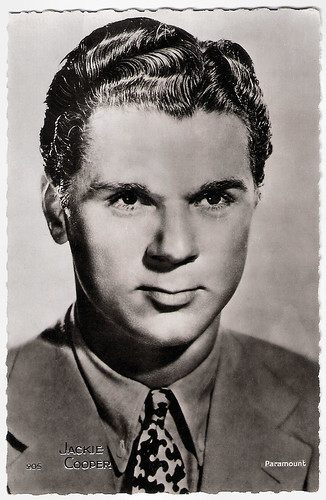
French postcard by Editions P.I., Paris, no. 205. Photo: Paramount.
Sources: Hal Erickson (AllMovie), Find A Grave, Wikipedia, and .

Dutch postcard by J.S.A., no. 184. Photo: Metro-Goldwyn-Mayer. Jackie Cooper in The Champ (King Vidor, 1931). Sent by mail in 1932.

Dutch postcard, no. 175. Photo: Metro-Goldwyn-Mayer. Jackie Cooper in The Champ (King Vidor, 1931).

Dutch postcard, no. 152. Photo: Metro-Goldwyn-Mayer. Jackie Cooper in The Champ (King Vidor, 1931).

Dutch postcard, no. 1235. Photo: Paramount. Jackie Cooper in Skippy (Norman Taurog, 1931).

Dutch postcard, no. 309. Photo: Metro-Goldwyn-Mayer. Jackie Cooper in Skippy (Norman Taurog, 1931).
One of Our Gang's major characters
Jackie Cooper was born as John Cooper Jr. in 1922 in Los Angeles, California. Cooper's father, John Cooper, left the family when Jackie was 2 years old. The two never reunited after he had left the family. His mother, Mabel Leonard Bigelow (née Polito), was a stage pianist. Cooper's maternal uncle, Jack Leonard, was a screenwriter and his maternal aunt, Julie Leonard, was an actress married to director Norman Taurog. Cooper's stepfather was C.J. Bigelow, a studio production manager.
Cooper first appeared in films as an extra with his grandmother, who took him to her auditions hoping it would help her get extra work. At age 3, Jackie appeared in Bobby Clark and Lloyd Hamilton comedies under the name of 'Leonard'. Cooper graduated to bit parts in feature films such as Fox Movietone Follies of 1929 (David Butler, 1929) and Sunny Side Up (David Butler, 1929) with Janet Gaynor .
His director in those films, David Butler, recommended Cooper to director Leo McCarey, who arranged an audition for the Our Gang comedy series produced by Hal Roach. In 1929, Cooper signed a three-year contract after joining the series in the short Boxing Gloves (Robert A. McGowan, 1929). He initially was to be a supporting character in the series, but by early 1930 his success in transitioning to sound films enabled him to become one of Our Gang's major characters. He appeared in 15 shorts over the next two years.
He was the main character in the episodes The First Seven Years (Robert A. McGowan, 1930) and When the Wind Blows (James W. Horne, 1930). His most notable Our Gang shorts explore his crush on Miss Crabtree, the schoolteacher played by June Marlowe: Teacher's Pet (Robert A. McGowan, 1930), School's Out (Robert A. McGowan, 1930), and Love Business (Robert A. McGowan, 1930).
In 1931, while under contract to Hal Roach Studios, Jackie Cooper was loaned to Paramount to star in Skippy (1931), directed by his uncle, Norman Taurog. At age 9, Cooper was nominated for an Academy Award for Best Actor, the youngest actor to be nominated for such an Oscar. Although Paramount paid Roach $25,000 for Cooper's services, Roach paid Cooper a standard salary of $50 per week.
Our Gang producer Hal Roach sold Jackie's contract to Metro-Goldwyn-Mayer in 1931. Cooper acted with Wallace Beery in The Champ (King Vidor, 1931), The Bowery (Raoul Walsh, 1933), Treasure Island (Victor Fleming, 1934), and O'Shaughnessy's Boy (Richard Boleslawski, 1935). In his autobiography, Cooper wrote that Beery was a disappointment and accused him of upstaging him and attempting to undermine his performances out of jealousy.
Cooper outgrew his preteen cuteness by the late 1930s and was forced to accept whatever work that came along. he enjoyed the occasional plum role in such films as The Return of Frank James (Fritz Lang, 1940) with Henry Fonda , and the first two Henry Aldrich films, What a Life (Theodore Reed, 1939) and Life with Henry (Theodore Reed, 1941). Cooper served in the U.S. Navy during World War II, remaining in the reserves until 1982, retiring at the rank of captain and receiving the Legion of Merit.

German postcard by Ross Verlag, no. 161/3. Photo: Metro-Goldwyn-Mayer Jackie Cooper in The Champ (King Vidor, 1931).

German postcard by Ross Verlag, no. 6701/1, 1931-1932. Photo: Paramount. Jackie Cooper and Mitzi Green in Skippy (Norman Taurog, 1931).

German postcard by Ross Verlag, no. 6902/1, 1931-1932. Photo: Metro-Goldwyn-Mayer.

Dutch postcard. Sent by mail in 1938. Photo: Jackie Cooper in Skippy (Norman Taurog, 1931). Caption: What has happened now. That he looks so angry at everyone.

Dutch postcard. Sent by mail in 1938. Photo: Jackie Cooper in Skippy (Norman Taurog, 1931). Caption: It's Mum's birthday... wait a second ... Think, what will I give her.
Please Don't Shoot My Dog
After the war, Jackie Cooper was cast in a stage production of 'Mr. Roberts' (1950) in Boston, Massachusetts in the role of Ensign Pulver. In 1954, he guest-starred on TV in the legal drama Justice. He starred in two television sitcoms, The People's Choice (1955-1958) with Patricia Breslin and Hennesey (1959-1962) with Abby Dalton.
From 1964 to 1969, Cooper was vice president of program development at Columbia Pictures Screen Gems TV division. He was responsible for packaging series such as Bewitched and selling them to the networks. In 1964, Cooper appeared in Rod Serling's The Twilight Zone episode Caesar and Me, and in the made-for-television film Shadow on the Land (Richard C. Sarafian, 1968). Cooper left Columbia in 1969.
He appeared in the fourth season of Hawaii Five-O in an episode called The Burning Ice (1971), in Candidate for Crime (1973) starring Peter Falk as Columbo, and in the series Mobile One (1975). Cooper’s work as director on episodes of M*A*S*H and The White Shadow earned him Emmy awards.
In the 1970s and 1980s, Cooper appeared as Daily Planet editor Perry White in the Superman film series, Superman (Richard Donner, 1978), Superman II (Richard Lester, 1980), Superman III (Richard Lester, 1983), and Superman IV: The Quest for Peace (Sidney J. Furie, 1987). He got the role after Keenan Wynn, who was originally cast as White, became unavailable after suffering a heart attack.
Cooper's final film role was as Ace Morgan in Surrender (Jerry Belson, 1987), starring Sally Field, Michael Caine , and Steve Guttenberg. Cooper announced his retirement in 1989, although he continued directing episodes of the syndicated series Superboy. He began spending more time training and racing horses at Hollywood Park and outside San Diego during the Del Mar racing season. Cooper lived in Beverly Hills from 1955 until his death.
Cooper's autobiography, 'Please Don't Shoot My Dog', was published in 1982. The title refers to an incident during the filming of Skippy, when Norman Taurog, who was directing Cooper in a crying scene, ordered a security guard to take away his dog and pretend to shoot him backstage. The stunt resulted in genuine tears; however, even upon discovering his dog was fine, Cooper was left with ill feelings toward his uncle.
For his contributions to the motion picture industry, Cooper was honored with a Hollywood Walk of Fame star located at 1507 Vine Street. Cooper died in 2011 from natural causes, in Santa Monica, California. He was survived by his two sons. He was interred at Arlington National Cemetery in Arlington, Virginia, in honor of his naval service.
Jackie Cooper was married to June Horne from 1944 until 1949, with whom he had a son, John 'Jack' Cooper, III (1946). June was the daughter of director James W. Horne and actress Cleo Ridgely. Cooper was married to Hildy Parks from 1950 until 1951 or 1954 (sources differ), and to Barbara Rae Kraus from 1954 until her death in 2009. Cooper and Kraus had three children, Russell (1956), Julie (1957-1997), and Cristina (1959-2009).

British postcard in the Film Partners Series, London, no. PC 71. Photo: Metro-Goldwyn-Mayer (MGM). Wallace Beery and Jackie Cooper in The Champ (King Vidor, 1931).

British postcard in the Film-Kurier Series, London, no. 11. Photo: Metro-Goldwyn-Mayer.

French postcard by Cinémagazine-Edition, no. 1017. Photo: Metro-Goldwyn-Mayer. Jackie Cooper in The Champ (King Vidor, 1931).

British postcard in the Picturegoer Series, London, no. 568a. Photo: Metro-Goldwyn-Mayer. Jackie Cooper in The Champ (King Vidor, 1931).

British postcard in the Film Partners Series, London, no. P 71. Photo: Metro-Goldwyn-Mayer (MGM). Wallace Beery and Jackie Cooper in The Champ (King Vidor, 1931).

British postcard by Film Weekly. Photo: 20th Century / United Artists. Wallace Beery and Jackie Cooper in The Bowery (Raoul Walsh, 1933).

British postcard by De Reszke Cigarettes, no. 46. Photo: Metro-Goldwyn-Mayer (MGM). Wallace Beery and Jackie Cooper in Treasure Island (Victor Fleming, 1934).

French postcard by Editions P.I., Paris, no. 205. Photo: Paramount.
Sources: Hal Erickson (AllMovie), Find A Grave, Wikipedia, and .
Published on November 10, 2020 22:00
November 9, 2020
De Jantjes (1934)
Next week EFSP will follow Cinefest, the 17th International Festival of German Film-Heritage in Hamburg. The theme of the festival is 'Cinema, War, and Tulips: German-Dutch Film Relations'. A landmark in the Dutch cinema, which will not be shown at the festival, is the musical drama De Jantjes/The Tars (Jaap Speyer, 1934). Before, director Jaap Speyer had a productive career in the silent German cinema of the 1920s. De Jantjes was the second Dutch sound film and a huge box office hit at the time. The film was based on a popular play by Herman Bouber and one of the leads was played by his wife, character actress Aaf Bouber.
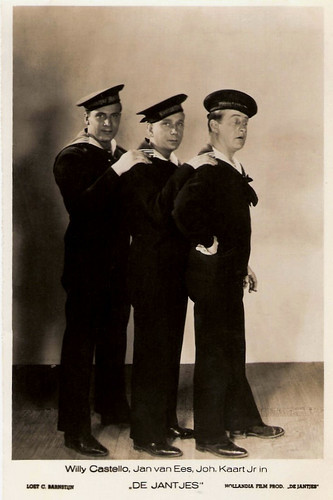
Dutch postcard by Hollandia Film Prod. / Loet C. Barnstijn. Photo: Jan van Ees , Willy Castello , and Johan Kaart jr. in De Jantjes (1934).
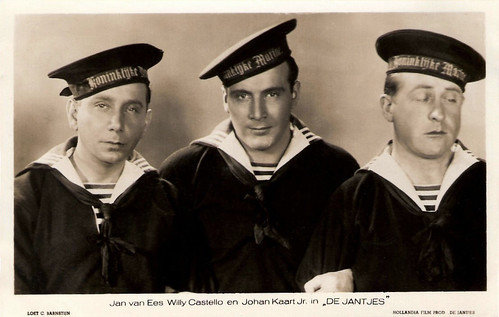
Dutch postcard by Hollandia Film Prod. / Loet C. Barnstijn. Photo: Jan van Ees , Willy Castello , and Johan Kaart jr. in De Jantjes (1934).
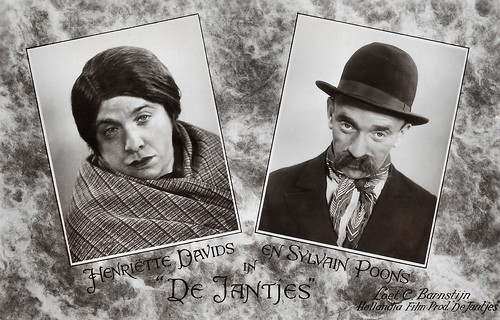
Dutch postcard by M. Bonist & Zonen, Amsterdam, no. B 314. Photo: Loet C. Barnstijn / Hollandia Film Prod. Heintje Davids and Sylvain Poons in De Jantjes/The Tars (Jaap Speijer, 1934).
Jordaan Play
De Jantjes (the international title is The Tars) was based on a popular 'Jordaan play' (a play set in an old neighbourhood of Amsterdam, the Jordaan) by Herman Bouber.
The music of the songs was written by Louis Davids. The musical was performed for the first time in 1920 with Louis Davids and his wife Margie Morris in the principal parts. The musical is one of the classics of the Dutch entertainment world.
De Jantjes had already been adapted as a silent film in 1922 starring Louis Davids . In 1933 director Jaap Speyer, who had made many silent films in Germany, started to shoot a new sound version.
There was even a competition which film would be the first Dutch sound film in the cinema. The other competitor, Willem van Oranje/Willem of Orange (Jan Teunissen, 1934) won, but lost at the box office, and got the worst reviews.
De Jantjes/The Tars (Jaap Speyer, 1934) has nice camera work by Henk Alsem and Akos Farkas and a couple of classic Dutch songs. The cast is excellent including popular revue and film stars as Fien de la Mar , Cissy van Bennekom , Sylvain Poons , Heintje (Henriette) Davids and her brother Louis Davids , and Aaf Bouber , the wife of the author.
The title characters are three sailors, played by Jan van Ees , Willy Castello and Johan Kaart jr. , who return from the Dutch Indies to their old neighbourhood. There they meet love and labour problems.

Dutch postcard by M. B. & Z. (M. Bonnist & Zonen, Amsterdam) for Hollandia Film Prod. / Loet C. Barnstijn. Photo: Johan Kaart jr. , Willy Castello , and Jan van Ees in De Jantjes (1934).

Dutch postcard by Hollandia Film Prod. / Loet C. Barnstijn. Photo:Joan Remmelts, Jan van Ees , Sylvain Poons , Johan Kaart jr. , Henriëtte Davids , Willy Castello , Susie Klein in De Jantjes (1934).

Dutch postcard by Hollandia Film Prod. / Loet C. Barnstijn. Photo: Johan Kaart jr., Suzy Klein, Willy Castello, Heintje Davids, Jan van Ees and Sylvain Poons in De Jantjes (1934).
Aaf Bouber
Aaf Bouber (1885-1974), the wife of author Herman Bouber, played the central role of Aunt Piet in De Jantjes/The Tars (1934). She acted in several Dutch films from the 1910s into the 1950s.
As a child, she was already loving the stage and performed at parties and markets in her hometown Hoorn. When she was sixteen she left home for Amsterdam and was engaged for the variety show 'Amsterdam' starring Louisette and Chrétienne in grand theatre Carré.
In the following years, she worked with such Dutch stage legends as Willem Hart and Louis Bouwmeester . She also acted in silent films like Fatum (Theo Frenkel sr., 1914) with Louis Bouwmeester , the fisher drama Het wrak in de Noordzee (Theo Frenkel sr., 1915) and Genie tegen geweld (Theo Frenkel sr., 1916).
Then she met Herman Bouber, director of the Plantage Theatre. He helped her to develop into an incomparable character actress in his popular folk plays like 'De Jantjes', 'Bleeke Bet' and 'Oranje Hein' all situated in the old Amsterdam neighbourhood De Jordaan.
She also played in the silent films Cirque Hollandais/Dutch Circus (Theo Frenkel Sr., 1924) starring Louis Bouwmeester , Oranje Hein/Orange Hein (Alex Benno, 1925) and Klassenstrijd/Class Struggle (Willy Mullens, 1928).
In the many performances through the years of De Jantjes, Aaf Bouber (often billed as Aaf Bouber-ten Hoope) would play all the female roles. After the surprising success of the sound film version of De Jantjes (Jaap Speyer, 1934) she would play the title character in another film based on a play by her husband, Bleeke Bet/Pale Beth (Richard Oswald, Alex Benno, 1934), which also became a big hit.
Other films of the 1930s include the fisher drama Op hoop van Zegen (Alex Benno, Louis Saalborn, 1934), De Suikerfreule (Haro van Peski, 1935), another adaptation of Oranje Hein (Max Nosseck, 1936), Drie wensen/Three Wishes (Kurt Gerron, 1937), the Daddy Longlegs adaptation Vadertje Langbeen (Friedrich Zelnik a.k.a. Frederic Zelnik, 1938) and Ergens in Nederland/Somewhere in the Netherlands (Ludwig Berger, 1940). The latter film was just ready for release when the Netherlands was conquered by the Nazis, who forbade its exhibition.
During the war, she was seen in 7 maal 7/Seven Times Seven (Walter Smith a.o., 1942) and De laatste dagen van een eiland/The Final Days of an Island (Ernst Winar, 1942). After the war she made one more film, the comedy Sterren stralen overal/Stars Twinkle Everywhere (Gerard Rutten, 1953).
During her long career, she would also play hundreds of roles on the stage, radio and television. When Aaf Bouber was 85 she played her last role in the TV thriller Ritueel/Ritual (1970). She passed away in 1974.
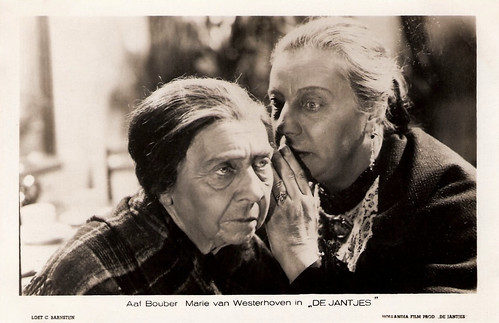
Dutch postcard. Photo: Loet C. Barnstijn / Hollandia Film Prod. Aaf Bouber is seen on the left with at right Marie van Westerhoven as the gossip Betje in De Jantjes (1934).
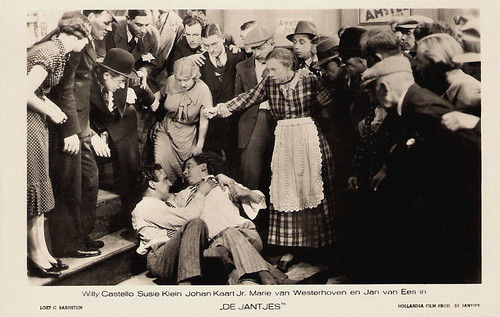
Dutch postcard by Hollandia Film Prod. / Loet C. Barnstijn. Photo: Willy Castello , Suzie Klein, Johan Kaart jr. , Marie van Westerhoven, and Jan van Ees in De Jantjes (1934).
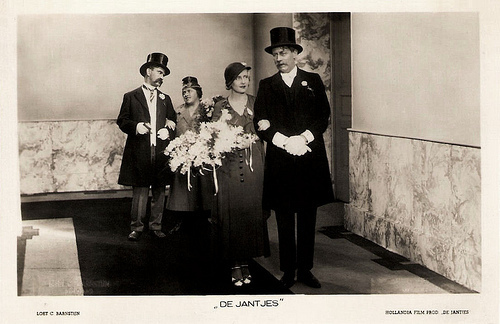
Dutch postcard. Photo: Loet C. Barnstijn / Hollandia Film Prod. Heintje Davids and Sylvain Poons in De Jantjes (1934).
Sources: De Boubers (Dutch), Wikipedia (Dutch), and IMDb.

Dutch postcard by Hollandia Film Prod. / Loet C. Barnstijn. Photo: Jan van Ees , Willy Castello , and Johan Kaart jr. in De Jantjes (1934).

Dutch postcard by Hollandia Film Prod. / Loet C. Barnstijn. Photo: Jan van Ees , Willy Castello , and Johan Kaart jr. in De Jantjes (1934).

Dutch postcard by M. Bonist & Zonen, Amsterdam, no. B 314. Photo: Loet C. Barnstijn / Hollandia Film Prod. Heintje Davids and Sylvain Poons in De Jantjes/The Tars (Jaap Speijer, 1934).
Jordaan Play
De Jantjes (the international title is The Tars) was based on a popular 'Jordaan play' (a play set in an old neighbourhood of Amsterdam, the Jordaan) by Herman Bouber.
The music of the songs was written by Louis Davids. The musical was performed for the first time in 1920 with Louis Davids and his wife Margie Morris in the principal parts. The musical is one of the classics of the Dutch entertainment world.
De Jantjes had already been adapted as a silent film in 1922 starring Louis Davids . In 1933 director Jaap Speyer, who had made many silent films in Germany, started to shoot a new sound version.
There was even a competition which film would be the first Dutch sound film in the cinema. The other competitor, Willem van Oranje/Willem of Orange (Jan Teunissen, 1934) won, but lost at the box office, and got the worst reviews.
De Jantjes/The Tars (Jaap Speyer, 1934) has nice camera work by Henk Alsem and Akos Farkas and a couple of classic Dutch songs. The cast is excellent including popular revue and film stars as Fien de la Mar , Cissy van Bennekom , Sylvain Poons , Heintje (Henriette) Davids and her brother Louis Davids , and Aaf Bouber , the wife of the author.
The title characters are three sailors, played by Jan van Ees , Willy Castello and Johan Kaart jr. , who return from the Dutch Indies to their old neighbourhood. There they meet love and labour problems.

Dutch postcard by M. B. & Z. (M. Bonnist & Zonen, Amsterdam) for Hollandia Film Prod. / Loet C. Barnstijn. Photo: Johan Kaart jr. , Willy Castello , and Jan van Ees in De Jantjes (1934).

Dutch postcard by Hollandia Film Prod. / Loet C. Barnstijn. Photo:Joan Remmelts, Jan van Ees , Sylvain Poons , Johan Kaart jr. , Henriëtte Davids , Willy Castello , Susie Klein in De Jantjes (1934).

Dutch postcard by Hollandia Film Prod. / Loet C. Barnstijn. Photo: Johan Kaart jr., Suzy Klein, Willy Castello, Heintje Davids, Jan van Ees and Sylvain Poons in De Jantjes (1934).
Aaf Bouber
Aaf Bouber (1885-1974), the wife of author Herman Bouber, played the central role of Aunt Piet in De Jantjes/The Tars (1934). She acted in several Dutch films from the 1910s into the 1950s.
As a child, she was already loving the stage and performed at parties and markets in her hometown Hoorn. When she was sixteen she left home for Amsterdam and was engaged for the variety show 'Amsterdam' starring Louisette and Chrétienne in grand theatre Carré.
In the following years, she worked with such Dutch stage legends as Willem Hart and Louis Bouwmeester . She also acted in silent films like Fatum (Theo Frenkel sr., 1914) with Louis Bouwmeester , the fisher drama Het wrak in de Noordzee (Theo Frenkel sr., 1915) and Genie tegen geweld (Theo Frenkel sr., 1916).
Then she met Herman Bouber, director of the Plantage Theatre. He helped her to develop into an incomparable character actress in his popular folk plays like 'De Jantjes', 'Bleeke Bet' and 'Oranje Hein' all situated in the old Amsterdam neighbourhood De Jordaan.
She also played in the silent films Cirque Hollandais/Dutch Circus (Theo Frenkel Sr., 1924) starring Louis Bouwmeester , Oranje Hein/Orange Hein (Alex Benno, 1925) and Klassenstrijd/Class Struggle (Willy Mullens, 1928).
In the many performances through the years of De Jantjes, Aaf Bouber (often billed as Aaf Bouber-ten Hoope) would play all the female roles. After the surprising success of the sound film version of De Jantjes (Jaap Speyer, 1934) she would play the title character in another film based on a play by her husband, Bleeke Bet/Pale Beth (Richard Oswald, Alex Benno, 1934), which also became a big hit.
Other films of the 1930s include the fisher drama Op hoop van Zegen (Alex Benno, Louis Saalborn, 1934), De Suikerfreule (Haro van Peski, 1935), another adaptation of Oranje Hein (Max Nosseck, 1936), Drie wensen/Three Wishes (Kurt Gerron, 1937), the Daddy Longlegs adaptation Vadertje Langbeen (Friedrich Zelnik a.k.a. Frederic Zelnik, 1938) and Ergens in Nederland/Somewhere in the Netherlands (Ludwig Berger, 1940). The latter film was just ready for release when the Netherlands was conquered by the Nazis, who forbade its exhibition.
During the war, she was seen in 7 maal 7/Seven Times Seven (Walter Smith a.o., 1942) and De laatste dagen van een eiland/The Final Days of an Island (Ernst Winar, 1942). After the war she made one more film, the comedy Sterren stralen overal/Stars Twinkle Everywhere (Gerard Rutten, 1953).
During her long career, she would also play hundreds of roles on the stage, radio and television. When Aaf Bouber was 85 she played her last role in the TV thriller Ritueel/Ritual (1970). She passed away in 1974.

Dutch postcard. Photo: Loet C. Barnstijn / Hollandia Film Prod. Aaf Bouber is seen on the left with at right Marie van Westerhoven as the gossip Betje in De Jantjes (1934).

Dutch postcard by Hollandia Film Prod. / Loet C. Barnstijn. Photo: Willy Castello , Suzie Klein, Johan Kaart jr. , Marie van Westerhoven, and Jan van Ees in De Jantjes (1934).

Dutch postcard. Photo: Loet C. Barnstijn / Hollandia Film Prod. Heintje Davids and Sylvain Poons in De Jantjes (1934).
Sources: De Boubers (Dutch), Wikipedia (Dutch), and IMDb.
Published on November 09, 2020 22:00
November 8, 2020
Ken Maynard
Ken Maynard (1895–1973) was one of the superstars among the film cowboys. He was most active from the 1920s to the 1940s.
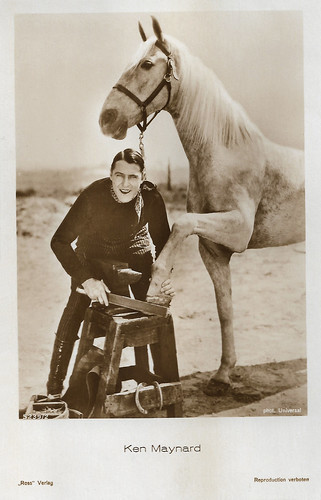
German postcard by Ross Verlag, no. 5239/2, 1930-1931. Photo: Universal.
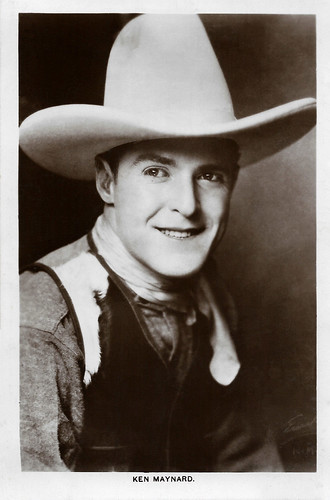
British postcard in the Picturegoer Series, London, no. 380. Photo: Roman Freulich.
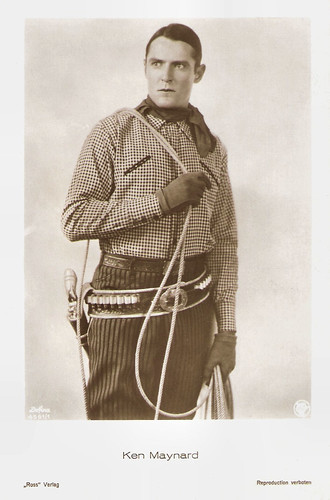
German postcard by Ross Verlag, no. 4561/1, 1929-1930. Photo: Defina / First National Pictures.
The first singing cowboy in the movies
Kenneth Olin Maynard was born in 1895 in Vevay, Indiana, USA. His brother was the cowboy actor Kermit Maynard. Studio publicity incorrectly puts his birthplace at Mission, Texas. Ken spent his boyhood around Columbus, Indiana, and eventually attended, but not graduated from, Indiana University.
Reportedly, Ken Maynard began his career as a trick rider with the Buffalo Bill Wild West Show and later with the Ringling Brothers circus. When the circus was playing in Los Angeles, California, actor Buck Jones encouraged Maynard to try working in the movies.
His film debut, The Man Who Won (William A. Wellman, 1923) starring Dustin Farnum, was the first of many. He scored good notices with a secondary role in Janice Meredith (E. Mason Hopper, 1924) opposite Marion Davies .
Figuring it was better to be a big fish in a small pond, Ken signed with an independent low budget producer, J. Charles Davis and became a star in its low budget releases, $50,000 Reward (Clifford S. Elfelt, 1924) with Esther Ralston , and The Grey Vulture (Forrest Sheldon, 1926).
Maynard signed with Fox's First National Pictures and starred in some twenty silent Westerns. He remained with First National after it was sold off to Warner Brothers. Ken, at this point, was in his prime and at the top of his game with audiences. He was famous for the daredevil stunts he could enact with his white horse, Tarzan. These were photographed fairly close so audiences could see that Maynard was doing his own stunts.
Jack Backstreet at IMDb : "Few stars were ever as disliked within the business but held in such high regard by fans as Ken Maynard. To never have met Maynard was reportedly a blessing. And despite his innumerable personality shortcomings, no other western star of the period had so many opportunities thrown his way."
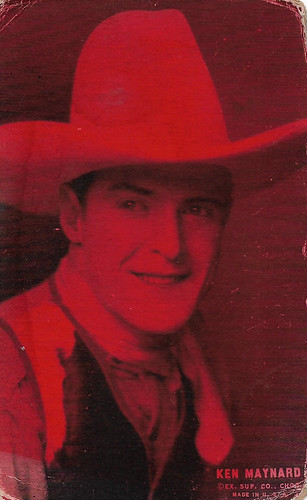
American Arcade card by Ex. Sup. Co., Chicago.
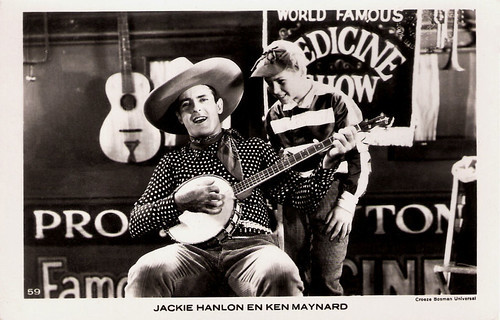
Dutch postcard by JosPe, no. 59. Photo: Croeze Bosman Universal. Ken Maynard and Jackie Hanlon in Parade of the West (Harry Joe Brown, 1930).
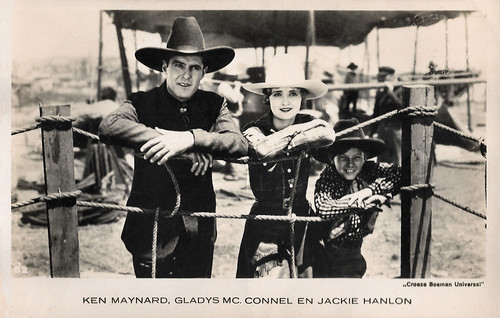
Dutch postcard by JosPe, no. 62. Photo: Croeze Bosman Universal. Ken Maynard, Gladys McConnell, and Jackie Hanlon in Parade of the West (Harry Joe Brown, 1930).
On the wrong side of the studio's gates
Ken Maynard lavished a fortune on women, fancy cars, and even had his own airplane. In 1929, he accepted a lucrative offer from Carl Laemmle to jump to Universal. Laemmle offered Ken his own company and creative control, which put him into the ranks of Hoot Gibson (then Universal's premier Western star), Tom Mix, and William S. Hart .
Maynard became the first singing cowboy in the movies. He recorded two songs for Columbia Records, 'The Lone Star Trail' and 'The Cowboy's Lament'. In one of his early sound films, Parade of the West (Harry Joe Brown, 1930), he sang the songs 'Down in Union County', 'The Old Chisholm Trail' and 'Sal's Got a Wooden Leg'.
For the 1931-1932 production season, the studio, riding high with its homegrown monster craze, opted to ditch Westerns altogether and Ken, who studio head Carl Laemmle had quickly grown to dislike, found himself on the wrong side of the studio's gates.
Other independent producers took a chance on the hotheaded star—among them Tiffany Productions and Sono Art-World Wide Pictures—before he returned to Universal in 1933. Maynard played several musical instruments and was featured that year on the violin in The Fiddlin' Buckaroo (Ken Maynard, 1933), and on the banjo in The Trail Drive (Alan James, 1933).
During the 1930s, he moved from one studio to another and finally went back to rodeo work. He returned to the screen in 1943 for low-budget Monogram Pictures in a new series called The Trail Blazers. He was teamed with fellow veteran stars Hoot Gibson and Bob Steele, and the trio offered action for the kids and nostalgia for their elders.
It wasn't long before Maynard's raging temperament again cost him the job; he liked Gibson but didn't like Steele, and left the series after seven films. One final film, Harmony Trail (Robert Emmett Tansey, 1944), was made by independent producer Walt Mattox. Ken Maynard retired for good except for bit parts. He made appearances at state fairs and rodeos. He owned a small circus operation featuring rodeo riders but eventually lost it to creditors.
Married multiple times, Manyard's last wife, Bertha Denham died in 1968 and he found himself living largely off meager Social Security checks. His last years were miserable. He was an alcoholic, who lived alone and in poverty in a trailer. Maynard never had any children.
More than 25 years after his last starring role, Maynard returned to the screen in two small roles in Bigfoot (Robert F. Slatzer, 1970) and The Marshal of Windy Hollow (Jerry Whittington, filmed in 1972 but never released).
In 1973, Ken Maynard died of stomach cancer largely forgotten at the Woodland Hills Motion Picture Home in Los Angeles. He was 77. Maynard was interred at Forest Lawn Cypress Cemetery in Cypress, California. He has a star on the Hollywood Walk of Fame at 6751 Hollywood Blvd.
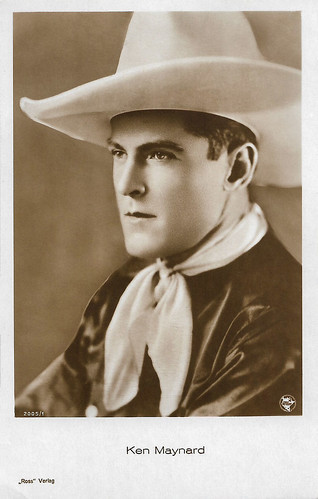
German postcard by Ross Verlag, no. 2005/1, 1927-1928. Photo: First National.
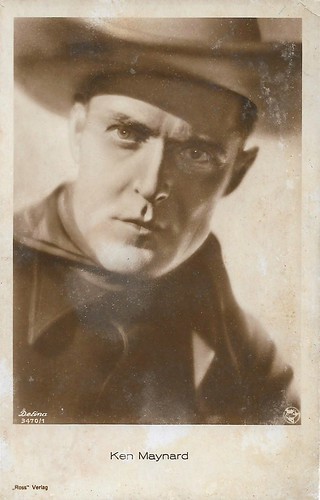
German postcard by Ross Verlag, no. 3470/1, 1928-1929. Photo: Defina / First National.
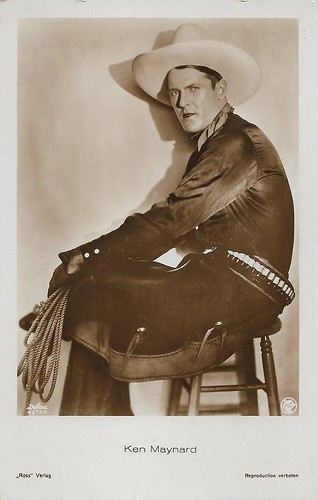
German postcard by Ross Verlag, no. 4370/1, 1929-1930. Photo: Defina / First National.
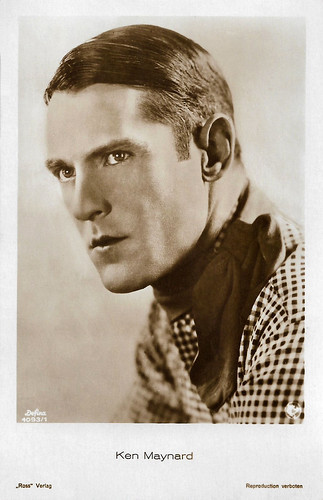
German postcard by Ross Verlag, no. 4393/1, 1929-1930. Photo: Defina / First National.
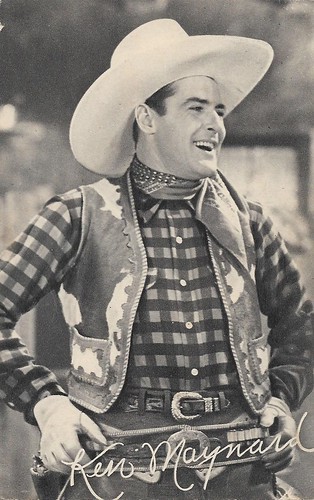
American postcard, c. 1935. Real Photogravure.
Sources: (IMDb), (IMDb), Les Adams (IMDb), Wikipedia, and .

German postcard by Ross Verlag, no. 5239/2, 1930-1931. Photo: Universal.

British postcard in the Picturegoer Series, London, no. 380. Photo: Roman Freulich.

German postcard by Ross Verlag, no. 4561/1, 1929-1930. Photo: Defina / First National Pictures.
The first singing cowboy in the movies
Kenneth Olin Maynard was born in 1895 in Vevay, Indiana, USA. His brother was the cowboy actor Kermit Maynard. Studio publicity incorrectly puts his birthplace at Mission, Texas. Ken spent his boyhood around Columbus, Indiana, and eventually attended, but not graduated from, Indiana University.
Reportedly, Ken Maynard began his career as a trick rider with the Buffalo Bill Wild West Show and later with the Ringling Brothers circus. When the circus was playing in Los Angeles, California, actor Buck Jones encouraged Maynard to try working in the movies.
His film debut, The Man Who Won (William A. Wellman, 1923) starring Dustin Farnum, was the first of many. He scored good notices with a secondary role in Janice Meredith (E. Mason Hopper, 1924) opposite Marion Davies .
Figuring it was better to be a big fish in a small pond, Ken signed with an independent low budget producer, J. Charles Davis and became a star in its low budget releases, $50,000 Reward (Clifford S. Elfelt, 1924) with Esther Ralston , and The Grey Vulture (Forrest Sheldon, 1926).
Maynard signed with Fox's First National Pictures and starred in some twenty silent Westerns. He remained with First National after it was sold off to Warner Brothers. Ken, at this point, was in his prime and at the top of his game with audiences. He was famous for the daredevil stunts he could enact with his white horse, Tarzan. These were photographed fairly close so audiences could see that Maynard was doing his own stunts.
Jack Backstreet at IMDb : "Few stars were ever as disliked within the business but held in such high regard by fans as Ken Maynard. To never have met Maynard was reportedly a blessing. And despite his innumerable personality shortcomings, no other western star of the period had so many opportunities thrown his way."

American Arcade card by Ex. Sup. Co., Chicago.

Dutch postcard by JosPe, no. 59. Photo: Croeze Bosman Universal. Ken Maynard and Jackie Hanlon in Parade of the West (Harry Joe Brown, 1930).

Dutch postcard by JosPe, no. 62. Photo: Croeze Bosman Universal. Ken Maynard, Gladys McConnell, and Jackie Hanlon in Parade of the West (Harry Joe Brown, 1930).
On the wrong side of the studio's gates
Ken Maynard lavished a fortune on women, fancy cars, and even had his own airplane. In 1929, he accepted a lucrative offer from Carl Laemmle to jump to Universal. Laemmle offered Ken his own company and creative control, which put him into the ranks of Hoot Gibson (then Universal's premier Western star), Tom Mix, and William S. Hart .
Maynard became the first singing cowboy in the movies. He recorded two songs for Columbia Records, 'The Lone Star Trail' and 'The Cowboy's Lament'. In one of his early sound films, Parade of the West (Harry Joe Brown, 1930), he sang the songs 'Down in Union County', 'The Old Chisholm Trail' and 'Sal's Got a Wooden Leg'.
For the 1931-1932 production season, the studio, riding high with its homegrown monster craze, opted to ditch Westerns altogether and Ken, who studio head Carl Laemmle had quickly grown to dislike, found himself on the wrong side of the studio's gates.
Other independent producers took a chance on the hotheaded star—among them Tiffany Productions and Sono Art-World Wide Pictures—before he returned to Universal in 1933. Maynard played several musical instruments and was featured that year on the violin in The Fiddlin' Buckaroo (Ken Maynard, 1933), and on the banjo in The Trail Drive (Alan James, 1933).
During the 1930s, he moved from one studio to another and finally went back to rodeo work. He returned to the screen in 1943 for low-budget Monogram Pictures in a new series called The Trail Blazers. He was teamed with fellow veteran stars Hoot Gibson and Bob Steele, and the trio offered action for the kids and nostalgia for their elders.
It wasn't long before Maynard's raging temperament again cost him the job; he liked Gibson but didn't like Steele, and left the series after seven films. One final film, Harmony Trail (Robert Emmett Tansey, 1944), was made by independent producer Walt Mattox. Ken Maynard retired for good except for bit parts. He made appearances at state fairs and rodeos. He owned a small circus operation featuring rodeo riders but eventually lost it to creditors.
Married multiple times, Manyard's last wife, Bertha Denham died in 1968 and he found himself living largely off meager Social Security checks. His last years were miserable. He was an alcoholic, who lived alone and in poverty in a trailer. Maynard never had any children.
More than 25 years after his last starring role, Maynard returned to the screen in two small roles in Bigfoot (Robert F. Slatzer, 1970) and The Marshal of Windy Hollow (Jerry Whittington, filmed in 1972 but never released).
In 1973, Ken Maynard died of stomach cancer largely forgotten at the Woodland Hills Motion Picture Home in Los Angeles. He was 77. Maynard was interred at Forest Lawn Cypress Cemetery in Cypress, California. He has a star on the Hollywood Walk of Fame at 6751 Hollywood Blvd.

German postcard by Ross Verlag, no. 2005/1, 1927-1928. Photo: First National.

German postcard by Ross Verlag, no. 3470/1, 1928-1929. Photo: Defina / First National.

German postcard by Ross Verlag, no. 4370/1, 1929-1930. Photo: Defina / First National.

German postcard by Ross Verlag, no. 4393/1, 1929-1930. Photo: Defina / First National.

American postcard, c. 1935. Real Photogravure.
Sources: (IMDb), (IMDb), Les Adams (IMDb), Wikipedia, and .
Published on November 08, 2020 22:00
November 7, 2020
Michael Douglas
Michael Douglas (1944) is an American actor-producer best known for his roles in films like Wall Street (1987), Fatal Attraction (1987), and Basic Instinct (1992). The elder son of Kirk Douglas gained fame after starring in the police series Streets of San Francisco (1972–1977). Douglas branched out into independent feature production in 1975 with the acclaimed One Flew Over the Cuckoo's Nest (1975), for which he won an Oscar as one of the film's producers. Starring roles followed in The China Syndrome (1979), Romancing the Stone (1984), and Wall Street (1987), for which he won his second Oscar. Later films include Traffic (2000), Wonder Boys (2000), the Emmy Award-winning Behind the Candelabra (2013), and Ant-Man (2015).
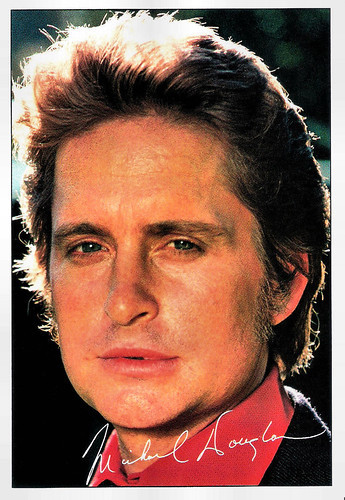
German collectors card by Bravo, ca. 1980.
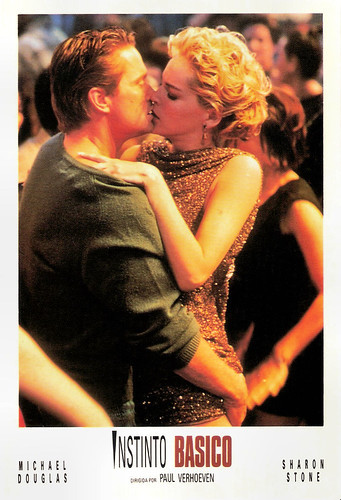
Spanish postcard by Novograf. Photo: Michael Douglas and Sharon Stone in Basic Instinct (Paul Verhoeven, 1992).
Only seeing Kirk on holidays
Michael Kirk Douglas was born in 1944, in New Brunswick, New Jersey, to film legend Kirk Douglas and his wife, British actress Diana Dill. Douglas grew up with three brothers: Joel, Peter, and Eric. Douglas's parents divorced when he was six, and he went to live with his mother and her new husband.
Only seeing Kirk on holidays, Michael attended the Eaglebrook School in Deerfield, Massachusetts, where he was about a year younger than all of his classmates. Douglas's strained relationship with his father developed more as he progressed through life. Douglas attended the elite preparatory the Choate Rosemary Hall School and spent his summers with his father on film sets.
Deciding he wanted to be an actor in his teenage years, Michael often asked his father about getting a 'foot in the door'. Kirk was strongly opposed to Michael pursuing an acting career, saying that it was an industry with many downs and few ups and that he wanted all four of his sons to stay out of it. Michael, however, was persistent and studied drama at the University of California, Santa Barbara, and in New York at the Neighborhood Playhouse School of the Theatre and the American Place Theatre.
Michael began his Hollywood career as an assistant director on some of his father's 1960s films. He made his film acting debut in his father's film Cast a Giant Shadow (Melville Shavelson, 1966). A few months after moving to New York, Douglas got his first big break, when he was cast in the pivotal role of the free-spirited scientist who compromises his liberal views to accept a lucrative job with a high-tech chemical corporation in the CBS Playhouse production of Ellen M. Violett's drama, The Experiment (1969).
Then followed the leading role in the adaptation of John Weston's controversial novel, Hail, Hero! (David Miller, 1969). His performance in this Vietnam-era antiwar film earned him a nomination for the Golden Globe Award for Most Promising Male Newcomer. He played a well-meaning, almost saintly young pacifist determined not only to justify his beliefs to his conservative parents but also to test them under fire in the jungles of Indochina.
He made a handful of mostly forgettable films. The best was the Disney-produced family adventure Napoleon and Samantha (1972) with the young Jodie Foster. Finally, Douglas became well-known as the sidekick of Karl Malden in the TV series The Streets of San Francisco (1972-1977). The police series became one of ABC's highest-rated prime-time programs in the mid-1970s. Douglas earned three successive Emmy Award nominations for his performance and he directed two episodes of the show.
During the annual breaks in the shooting schedule for The Streets of San Francisco, Douglas devoted his time to his film production company, Big Stick Productions, Ltd., which produced several short subjects in the early 1970s. He got involved in (executive) producing One Flew Over the Cuckoo's Nest (Milos Forman, 1975) after his father, who owned the rights to Ken Kesey's novel since the early 1960s, couldn't successfully develop it into a film for many years. After a number of major studios turned Michael down, he formed a partnership with Saul Zaentz, a record industry executive, and the two set about recruiting the cast and crew. One Flew Over the Cuckoo's Nest (Miloš Forman, 1975). It became the second film in Hollywood history to win Oscars in all five major categories: best picture, best actor ( Jack Nicholson ), best actress (Louise Fletcher), best director (Miloš Forman). The film grossed more than $180 million at the box office.
Despite the success of the film, it was difficult for Douglas to find work as an actor, having received so much recognition as a producer. After leaving The Streets of San Francisco in 1976, Douglas played a hospital doctor in the medical thriller Coma (Michael Crichton, 1978) with Genevieve Bujold, Claudia Weill's feminist comedy It's My Turn (1980) starring Jill Clayburgh, and Peter Hyams' gripping tale of modern-day vigilante justice, The Star Chamber (1983).
Douglas then co-produced and co-starred with Jane Fonda and Jack Lemmon in The China Syndrome (James Bridges, 1979), a drama about a nuclear power plant accident. The film received Oscar nominations for Lemmon and Fonda, as well as for Best Screenplay. The National Board of Review named the film one of the best films of the year. The following year, Douglas was involved in a serious skiing accident that sidelined his acting career for three years.
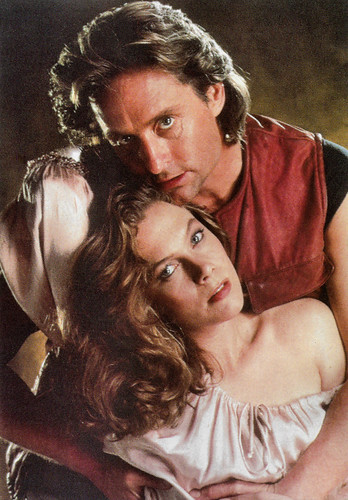
French postcard by Edition Erving, Paris, no. 702. Michael Douglas and Kathleen Turner in Romancing the Stone (Robert Zemeckis, 1984).
Greed is good
Michael Douglas became a star with his leading role in tongue-in-cheek romantic fantasy Romancing the Stone (Robert Zemeckis, 1984). He portrayed Jack Colton, an Indiana Jones-type adventurer, opposite Kathleen Turner as Joan Wilder, the dowdy writer of gothic romances, and Danny DeVito as the feisty comic foil Ralphie. Romancing was a resounding hit and grossed more than $100 million at the box office. Their successful teaming led to a sequel, The Jewel of the Nile (Lewis Teague, 1985). The three worked again in The War of the Roses (Danny DeVito, 1989), a dark comedy about an ugly divorce.
In between, he played Zach the dictatorial director/choreographer in Richard Attenborough 's screen version of Broadway's longest-running musical A Chorus Line (1985). In 1987, Douglas made two films that reflected a much darker side: the psychological thriller Fatal Attraction (Adrian Lyne, 1987), in which he played an adulterer stalked by an ex-lover — played by Glenn Close — and Wall Street (Oliver Stone, 1987), in which he played the ruthless corporate raider Gordon Gekko, whose trademark slogan is "Greed is good". For this role, he won an Oscar for Best Actor.
Encyclopaedia Britannica : "Several of Douglas’s performances flaunt this dichotomy: his villainous characters exhibit personal magnetism, and his heroes are often victim to their own inadequacies. He (like his father) was one of the few actors to build a successful career out of portraying less-than-virtuous characters."
Douglas next starred in Ridley Scott's thriller Black Rain (1989) He continued exploring his dark side in the erotic thriller Basic Instinct (Paul Verhoeven, 1992), co-starring Sharon Stone . The film was one of the year's top-grossing films and sparked controversy over its depictions of bisexuality and lesbianism.
In 1988, Douglas formed a production company, Stonebridge Entertainment, Inc., which produced Flatliners (Joel Schumacher, 1990) and Radio Flyer (Richard Donner, 1992). In 1992, he began a 30-day treatment for alcoholism and drug addiction at Sierra Tucson Center.
Douglas gave one of his most powerful performances opposite Robert Duvall in Joel Schumacher's controversial drama Falling Down (1993). That year, he also produced the hit comedy Made in America (Richard Benjamin, 1993) starring Whoopi Goldberg, then starred opposite Demi Moore as a sexually harassed man in Disclosure (Barry Levinson, 1994), based on the bestseller by Michael Crichton, and as the titular commander-in-chief in the romantic comedy The American President (Rob Reiner, 1995), co-starring Annette Bening.
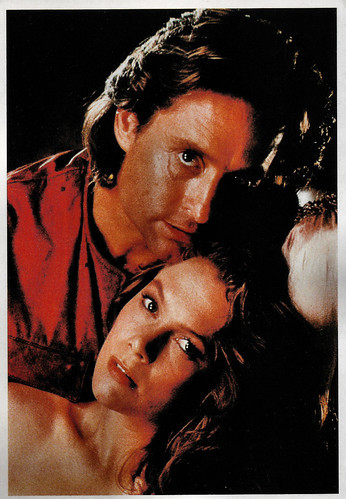
French postcard by Ebullitions, no. 12. Michael Douglas and Kathleen Turner in Romancing the Stone (Robert Zemeckis, 1984).
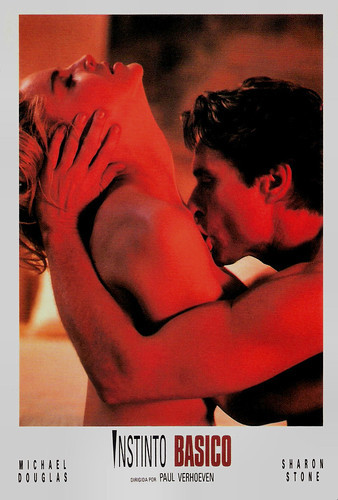
Spanish postcard by Novograf. Photo: Michael Douglas and Sharon Stone in Basic Instinct (Paul Verhoeven, 1992).
A Father, A Son... Once Upon a Time in Hollywood
In 1994, Michael Douglas signed a development deal at Paramount that included The Ghost and the Darkness (Stephen Hopkins, 1996), The Game (David Fincher, 1997) with Sean Penn, and A Perfect Murder (Andrew Davis, 1998). He executive produced The Rainmaker (Francis Ford Coppola, 1997), starring Matt Damon, as well as the action film, Face/Off (John Woo, 1997) with John Travolta and Nicolas Cage.
Douglas earned critical acclaim for his starring role as a rumpled college professor and novelist suffering from writer's block in Wonder Boys (Curtis Hanson, 2000) co-starring Tobey Maguire and Frances McDormand. In Traffic (Steven Soderbergh, 2000), Douglas played Robert Wakefield, a newly appointed drug czar confronted by the drug war both at home and abroad. Traffic was named Best Picture by New York Film Critics and won four Oscars (Best Screenplay, Best Editing, Best Director, and Best Supporting Actor for Benicio del Toro).
Douglas then headlined the psychological thriller Don't Say a Word (Gary Fleder, 2001), co-starring Brittany Murphy. He featured alongside his famous father, his mother, and his son, Cameron in It Runs in the Family (2003), about a multi-generational dysfunctional Manhattan family clan trying to get along. The film fared poorly at the box office. In 2004 Michael and Kirk filmed the intimate HBO documentary A Father, A Son... Once Upon a Time in Hollywood. Directed by award-winning filmmaker Lee Grant, the documentary examines the professional and personal lives of both men, and the impacts they each made on the film industry.
In 2010, Douglas announced that he would be reprising his role as Gordon Gekko in Wall Street 2: Money Never Sleeps (Oliver Stone, 2010), a sequel set in 2008 amid the global financial crisis. Once again, he was nominated for a Golden Globe for his performance. Douglas went on to play the famous 1950s and 1960s entertainer Liberace in Behind the Candelabra (Steven Soderbergh, 2013), a witty account of Liberace’s private life near the end of his career. Matt Damon played his partner Scott Thorson in the critically acclaimed television film. Douglas won an Emmy Award for his role.
He also filmed Last Vegas (John Turtletaub, 2013) with Robert De Niro . In the following years, Douglas starred opposite Diane Keaton in And So It Goes (Rob Reiner, 2014) and the Marvel superhero action/comedy Ant-Man (Peyton Reed, 2015) opposite Paul Rudd. He reprised his role as biochemist Hank Pym in the sequel Ant-Man and the Wasp (Peyton Reed, 2018) and also appeared in the superhero film Avengers: Endgame (Anthony Russo, Joe Russo, 2019).
In 1977, Michael Douglas married Diandra Luker. They had one son, Cameron, but separated in 1995 and later divorced. In 2000, Douglas married Welsh actress Catherine Zeta-Jones , his Traffic co-star. The couple welcomed a son, Dylan Michael Douglas, in 2000, followed by daughter Carys Zeta Douglas in 2003. In 2013, Douglas and Zeta-Jones separated after more than 12 years of marriage, but they reconciled in 2014. In 2017, he became a grandfather when his son Cameron Douglas and his girlfriend Viviane Thibes welcomed a daughter, Lua Izzy Douglas.
Outside of his busy acting career, Michael Douglas is active in promoting human rights. His work in this area includes serving as a United Nations messenger of peace. Douglas recently starred as as an aging actor turned acting teacher in Chuck Lorre's comedy series The Kominsky Method (2018-2019), for which he won the Golden Globe Award for Best Actor – Television Series Musical or Comedy, and in the Netflix series Green Eggs and Ham (2019), based on Dr. Seuss’s children’s classic, where he voices Guy-Am-I.
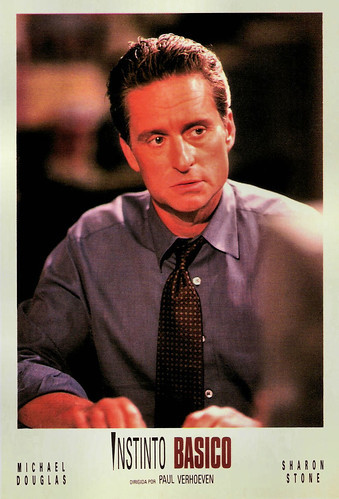
Spanish postcard by Novograf. Photo: Michael Douglas in Basic Instinct (Paul Verhoeven, 1992).
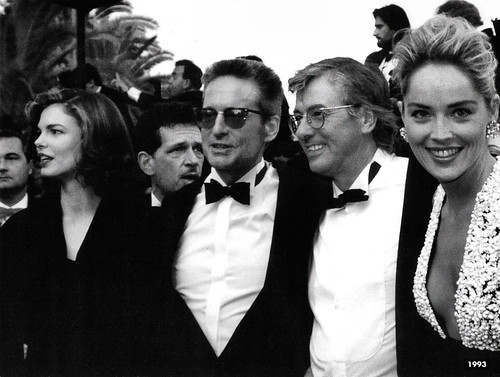
Big photo, 1993. Jeanne Tripplehorn, Michael Douglas, Paul Verhoeven, Sharon Stone at the Premiere of Basic Instinct (Paul Verhoeven, 1992) in Cannes.
Sources: (IMDb), Encyclopaedia Britannica, Biography.com, Wikipedia, and .

German collectors card by Bravo, ca. 1980.

Spanish postcard by Novograf. Photo: Michael Douglas and Sharon Stone in Basic Instinct (Paul Verhoeven, 1992).
Only seeing Kirk on holidays
Michael Kirk Douglas was born in 1944, in New Brunswick, New Jersey, to film legend Kirk Douglas and his wife, British actress Diana Dill. Douglas grew up with three brothers: Joel, Peter, and Eric. Douglas's parents divorced when he was six, and he went to live with his mother and her new husband.
Only seeing Kirk on holidays, Michael attended the Eaglebrook School in Deerfield, Massachusetts, where he was about a year younger than all of his classmates. Douglas's strained relationship with his father developed more as he progressed through life. Douglas attended the elite preparatory the Choate Rosemary Hall School and spent his summers with his father on film sets.
Deciding he wanted to be an actor in his teenage years, Michael often asked his father about getting a 'foot in the door'. Kirk was strongly opposed to Michael pursuing an acting career, saying that it was an industry with many downs and few ups and that he wanted all four of his sons to stay out of it. Michael, however, was persistent and studied drama at the University of California, Santa Barbara, and in New York at the Neighborhood Playhouse School of the Theatre and the American Place Theatre.
Michael began his Hollywood career as an assistant director on some of his father's 1960s films. He made his film acting debut in his father's film Cast a Giant Shadow (Melville Shavelson, 1966). A few months after moving to New York, Douglas got his first big break, when he was cast in the pivotal role of the free-spirited scientist who compromises his liberal views to accept a lucrative job with a high-tech chemical corporation in the CBS Playhouse production of Ellen M. Violett's drama, The Experiment (1969).
Then followed the leading role in the adaptation of John Weston's controversial novel, Hail, Hero! (David Miller, 1969). His performance in this Vietnam-era antiwar film earned him a nomination for the Golden Globe Award for Most Promising Male Newcomer. He played a well-meaning, almost saintly young pacifist determined not only to justify his beliefs to his conservative parents but also to test them under fire in the jungles of Indochina.
He made a handful of mostly forgettable films. The best was the Disney-produced family adventure Napoleon and Samantha (1972) with the young Jodie Foster. Finally, Douglas became well-known as the sidekick of Karl Malden in the TV series The Streets of San Francisco (1972-1977). The police series became one of ABC's highest-rated prime-time programs in the mid-1970s. Douglas earned three successive Emmy Award nominations for his performance and he directed two episodes of the show.
During the annual breaks in the shooting schedule for The Streets of San Francisco, Douglas devoted his time to his film production company, Big Stick Productions, Ltd., which produced several short subjects in the early 1970s. He got involved in (executive) producing One Flew Over the Cuckoo's Nest (Milos Forman, 1975) after his father, who owned the rights to Ken Kesey's novel since the early 1960s, couldn't successfully develop it into a film for many years. After a number of major studios turned Michael down, he formed a partnership with Saul Zaentz, a record industry executive, and the two set about recruiting the cast and crew. One Flew Over the Cuckoo's Nest (Miloš Forman, 1975). It became the second film in Hollywood history to win Oscars in all five major categories: best picture, best actor ( Jack Nicholson ), best actress (Louise Fletcher), best director (Miloš Forman). The film grossed more than $180 million at the box office.
Despite the success of the film, it was difficult for Douglas to find work as an actor, having received so much recognition as a producer. After leaving The Streets of San Francisco in 1976, Douglas played a hospital doctor in the medical thriller Coma (Michael Crichton, 1978) with Genevieve Bujold, Claudia Weill's feminist comedy It's My Turn (1980) starring Jill Clayburgh, and Peter Hyams' gripping tale of modern-day vigilante justice, The Star Chamber (1983).
Douglas then co-produced and co-starred with Jane Fonda and Jack Lemmon in The China Syndrome (James Bridges, 1979), a drama about a nuclear power plant accident. The film received Oscar nominations for Lemmon and Fonda, as well as for Best Screenplay. The National Board of Review named the film one of the best films of the year. The following year, Douglas was involved in a serious skiing accident that sidelined his acting career for three years.

French postcard by Edition Erving, Paris, no. 702. Michael Douglas and Kathleen Turner in Romancing the Stone (Robert Zemeckis, 1984).
Greed is good
Michael Douglas became a star with his leading role in tongue-in-cheek romantic fantasy Romancing the Stone (Robert Zemeckis, 1984). He portrayed Jack Colton, an Indiana Jones-type adventurer, opposite Kathleen Turner as Joan Wilder, the dowdy writer of gothic romances, and Danny DeVito as the feisty comic foil Ralphie. Romancing was a resounding hit and grossed more than $100 million at the box office. Their successful teaming led to a sequel, The Jewel of the Nile (Lewis Teague, 1985). The three worked again in The War of the Roses (Danny DeVito, 1989), a dark comedy about an ugly divorce.
In between, he played Zach the dictatorial director/choreographer in Richard Attenborough 's screen version of Broadway's longest-running musical A Chorus Line (1985). In 1987, Douglas made two films that reflected a much darker side: the psychological thriller Fatal Attraction (Adrian Lyne, 1987), in which he played an adulterer stalked by an ex-lover — played by Glenn Close — and Wall Street (Oliver Stone, 1987), in which he played the ruthless corporate raider Gordon Gekko, whose trademark slogan is "Greed is good". For this role, he won an Oscar for Best Actor.
Encyclopaedia Britannica : "Several of Douglas’s performances flaunt this dichotomy: his villainous characters exhibit personal magnetism, and his heroes are often victim to their own inadequacies. He (like his father) was one of the few actors to build a successful career out of portraying less-than-virtuous characters."
Douglas next starred in Ridley Scott's thriller Black Rain (1989) He continued exploring his dark side in the erotic thriller Basic Instinct (Paul Verhoeven, 1992), co-starring Sharon Stone . The film was one of the year's top-grossing films and sparked controversy over its depictions of bisexuality and lesbianism.
In 1988, Douglas formed a production company, Stonebridge Entertainment, Inc., which produced Flatliners (Joel Schumacher, 1990) and Radio Flyer (Richard Donner, 1992). In 1992, he began a 30-day treatment for alcoholism and drug addiction at Sierra Tucson Center.
Douglas gave one of his most powerful performances opposite Robert Duvall in Joel Schumacher's controversial drama Falling Down (1993). That year, he also produced the hit comedy Made in America (Richard Benjamin, 1993) starring Whoopi Goldberg, then starred opposite Demi Moore as a sexually harassed man in Disclosure (Barry Levinson, 1994), based on the bestseller by Michael Crichton, and as the titular commander-in-chief in the romantic comedy The American President (Rob Reiner, 1995), co-starring Annette Bening.

French postcard by Ebullitions, no. 12. Michael Douglas and Kathleen Turner in Romancing the Stone (Robert Zemeckis, 1984).

Spanish postcard by Novograf. Photo: Michael Douglas and Sharon Stone in Basic Instinct (Paul Verhoeven, 1992).
A Father, A Son... Once Upon a Time in Hollywood
In 1994, Michael Douglas signed a development deal at Paramount that included The Ghost and the Darkness (Stephen Hopkins, 1996), The Game (David Fincher, 1997) with Sean Penn, and A Perfect Murder (Andrew Davis, 1998). He executive produced The Rainmaker (Francis Ford Coppola, 1997), starring Matt Damon, as well as the action film, Face/Off (John Woo, 1997) with John Travolta and Nicolas Cage.
Douglas earned critical acclaim for his starring role as a rumpled college professor and novelist suffering from writer's block in Wonder Boys (Curtis Hanson, 2000) co-starring Tobey Maguire and Frances McDormand. In Traffic (Steven Soderbergh, 2000), Douglas played Robert Wakefield, a newly appointed drug czar confronted by the drug war both at home and abroad. Traffic was named Best Picture by New York Film Critics and won four Oscars (Best Screenplay, Best Editing, Best Director, and Best Supporting Actor for Benicio del Toro).
Douglas then headlined the psychological thriller Don't Say a Word (Gary Fleder, 2001), co-starring Brittany Murphy. He featured alongside his famous father, his mother, and his son, Cameron in It Runs in the Family (2003), about a multi-generational dysfunctional Manhattan family clan trying to get along. The film fared poorly at the box office. In 2004 Michael and Kirk filmed the intimate HBO documentary A Father, A Son... Once Upon a Time in Hollywood. Directed by award-winning filmmaker Lee Grant, the documentary examines the professional and personal lives of both men, and the impacts they each made on the film industry.
In 2010, Douglas announced that he would be reprising his role as Gordon Gekko in Wall Street 2: Money Never Sleeps (Oliver Stone, 2010), a sequel set in 2008 amid the global financial crisis. Once again, he was nominated for a Golden Globe for his performance. Douglas went on to play the famous 1950s and 1960s entertainer Liberace in Behind the Candelabra (Steven Soderbergh, 2013), a witty account of Liberace’s private life near the end of his career. Matt Damon played his partner Scott Thorson in the critically acclaimed television film. Douglas won an Emmy Award for his role.
He also filmed Last Vegas (John Turtletaub, 2013) with Robert De Niro . In the following years, Douglas starred opposite Diane Keaton in And So It Goes (Rob Reiner, 2014) and the Marvel superhero action/comedy Ant-Man (Peyton Reed, 2015) opposite Paul Rudd. He reprised his role as biochemist Hank Pym in the sequel Ant-Man and the Wasp (Peyton Reed, 2018) and also appeared in the superhero film Avengers: Endgame (Anthony Russo, Joe Russo, 2019).
In 1977, Michael Douglas married Diandra Luker. They had one son, Cameron, but separated in 1995 and later divorced. In 2000, Douglas married Welsh actress Catherine Zeta-Jones , his Traffic co-star. The couple welcomed a son, Dylan Michael Douglas, in 2000, followed by daughter Carys Zeta Douglas in 2003. In 2013, Douglas and Zeta-Jones separated after more than 12 years of marriage, but they reconciled in 2014. In 2017, he became a grandfather when his son Cameron Douglas and his girlfriend Viviane Thibes welcomed a daughter, Lua Izzy Douglas.
Outside of his busy acting career, Michael Douglas is active in promoting human rights. His work in this area includes serving as a United Nations messenger of peace. Douglas recently starred as as an aging actor turned acting teacher in Chuck Lorre's comedy series The Kominsky Method (2018-2019), for which he won the Golden Globe Award for Best Actor – Television Series Musical or Comedy, and in the Netflix series Green Eggs and Ham (2019), based on Dr. Seuss’s children’s classic, where he voices Guy-Am-I.

Spanish postcard by Novograf. Photo: Michael Douglas in Basic Instinct (Paul Verhoeven, 1992).

Big photo, 1993. Jeanne Tripplehorn, Michael Douglas, Paul Verhoeven, Sharon Stone at the Premiere of Basic Instinct (Paul Verhoeven, 1992) in Cannes.
Sources: (IMDb), Encyclopaedia Britannica, Biography.com, Wikipedia, and .
Published on November 07, 2020 22:00
November 6, 2020
One of Ross Verlag's first series
One of the earliest series by Ross Verlag - or Verlag "Ross" as then still was written on the postcards - is series 2001: twelve postcards with colour portraits printed on a white paper. The material used is heavier than the regular postcards. The series, published in 1919, features seven actresses and one actor of the German silent cinema. The card numbers are printed on the back of the cards. All the portraits in this series have also been used for sepia-tinted cards by Ross Verlag or by its predecessor Rotophot in the Film Sterne series.
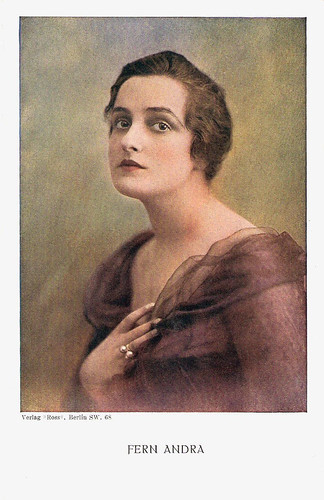
German postcard by Verlag Ross, Berlin, no. 2001/1. Photo: Fern Andra Atelier. See also: Film Sterne, no. 151/3.
'Modern' American actress Fern Andra (1893-1974) became one of the most popular film stars of the German cinema in the 1910s and early 1920s. In her films she mastered tightrope, riding a horse without a saddle, driving cars and motorcycles, bobsleighing, and even boxing.
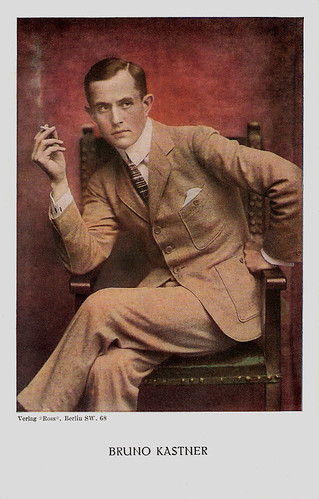
German postcard by Verlag Ross, Berlin, no. 2001/2. Photo: Becker & Maass. Also on Film Sterne, no. 138/1.
German actor Bruno Kastner (1890-1932) was one of the most beloved stars of the 1910s and 1920s. His parts as the elegant and charming dandy made him a heartthrob of the German silent cinema.
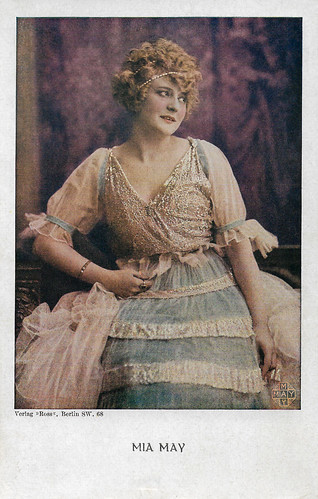
German postcard by Verlag Ross, Berlin, no. 2001/3. Photo: Becker & Maass / May Film. Also on Film Sterne, no. 105/4.
Mia May (1884-1980) was one of the first divas of the German cinema. She starred in many films of her husband, producer, writer, and director Joe May.
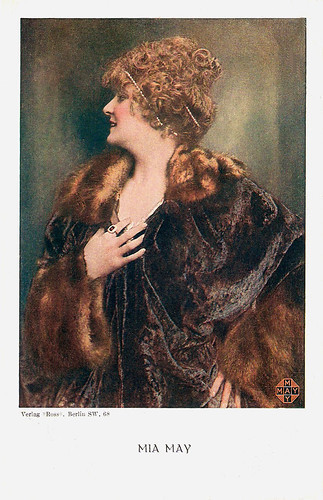
German postcard by Verlag Ross, Berlin, no. 2001/4. Photo: Becker & Maass / May Film. Also on Film Sterne, no. 105/1.
Mia May (1884-1980) was one of the first divas of the German cinema. She starred in many films of her husband, producer, writer, and director Joe May.
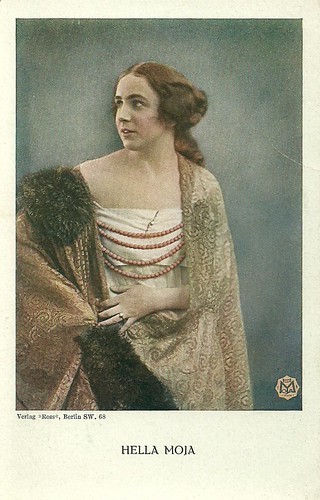
German postcard by Verlag Ross, Berlin, no. 2001/5. Photo: Becker & Maass / Hella Moja Film. Also on Film Sterne, no. 165/2.
During the First World War and the following years Hella Moja (1890-1951) was one of the most popular stars of the German silent cinema. There was even a Hella Moja serial and in 1918 she founded her own film company.
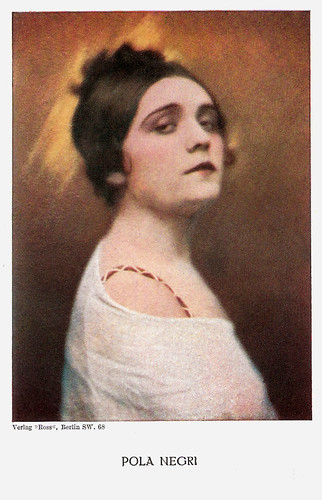
German postcard by Verlag Ross, Berlin, no. 2001/6. Photo: Anny Eberth. Also on Ross Verlag, no. 233, c. 1919-1920.
Polish film actress Pola Negri (1897-1987) achieved notoriety as a femme fatale in German and American silent films between the 1910s and 1930s. In the late 1910s and the 1920s, she achieved notoriety as a femme fatale in silent films in Poland, Berlin, and Hollywood. Negri was an overnight sensation in Lubitsch' Madame du Barry/Passion (1919).
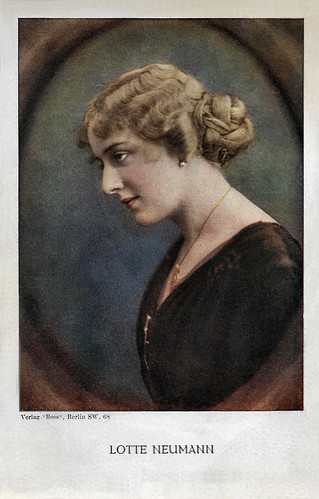
German postcard by Verlag Ross, Berlin, no. 2001/7. Photo: Becker & Maass. Also on Film Sterne, no. 194/3.
Lotte Neumann (1896-1977) was one of the most successful actresses in the early days of the German silent cinema. She also worked as a screenwriter and a producer.
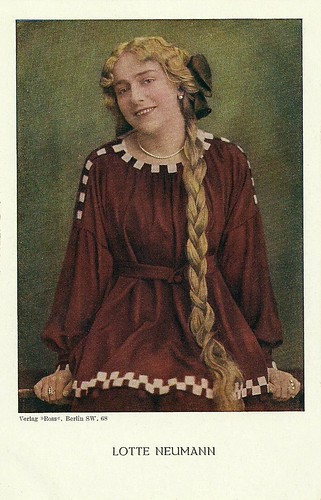
German postcard by Verlag Ross, Berlin, no. 2001/8. Photo: Becker & Maass. Also on Film Sterne, no. 150/2.
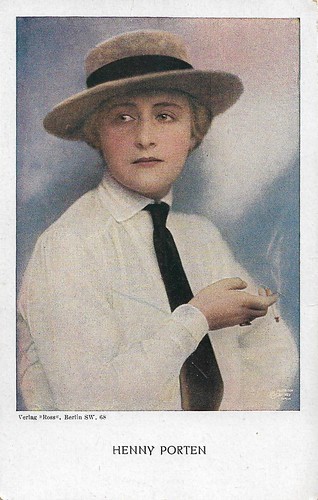
German postcard by Verlag Ross, Berlin, no. 2001/9. Photo: Becker & Maass / Messter Film, Berlin. Also on Verlag Ross, no. 303/1.
Sturdy and blond Henny Porten (1890-1960) was one of Germany's most important and popular film actresses of the silent cinema. She became the quintessence of German womanhood, ladylike yet kindhearted and a not a little petit bourgeois. She was also the producer of many of her own films.
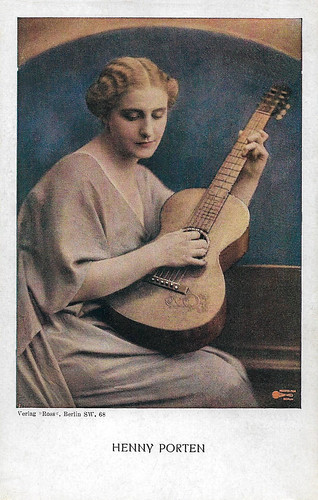
German postcard by Verlag Ross, Berlin, no. 2001/10. Photo: Becker & Maass / Messter Film, Berlin. Also on Verlag Ross, no. 301/3.
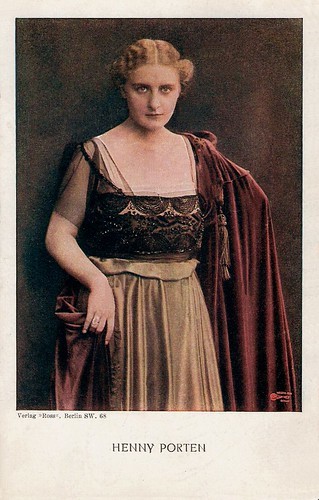
German postcard by Verlag Ross, Berlin, no. 2001/11. Photo: Becker & Maass / Messter Film. Also on Film Sterne, no. 215/1.
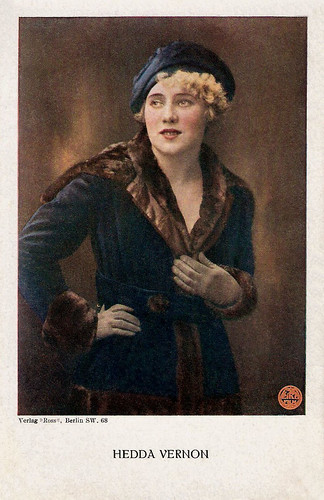
German postcard by Verlag Ross, no. 2001/12. Photo: Becker & Maass / Eiko Film. Also on Verlag Ross, no. 232/2.
German actress, writer, and producer Hedda Vernon (1886-1925) appeared in more than 60 films of the early silent period. During the 1910s she was such a popular film star that she got her own Hedda-Vernon serial.
Source: many thanks to Mark Goffee of Rossverlag.com.

German postcard by Verlag Ross, Berlin, no. 2001/1. Photo: Fern Andra Atelier. See also: Film Sterne, no. 151/3.
'Modern' American actress Fern Andra (1893-1974) became one of the most popular film stars of the German cinema in the 1910s and early 1920s. In her films she mastered tightrope, riding a horse without a saddle, driving cars and motorcycles, bobsleighing, and even boxing.

German postcard by Verlag Ross, Berlin, no. 2001/2. Photo: Becker & Maass. Also on Film Sterne, no. 138/1.
German actor Bruno Kastner (1890-1932) was one of the most beloved stars of the 1910s and 1920s. His parts as the elegant and charming dandy made him a heartthrob of the German silent cinema.

German postcard by Verlag Ross, Berlin, no. 2001/3. Photo: Becker & Maass / May Film. Also on Film Sterne, no. 105/4.
Mia May (1884-1980) was one of the first divas of the German cinema. She starred in many films of her husband, producer, writer, and director Joe May.

German postcard by Verlag Ross, Berlin, no. 2001/4. Photo: Becker & Maass / May Film. Also on Film Sterne, no. 105/1.
Mia May (1884-1980) was one of the first divas of the German cinema. She starred in many films of her husband, producer, writer, and director Joe May.

German postcard by Verlag Ross, Berlin, no. 2001/5. Photo: Becker & Maass / Hella Moja Film. Also on Film Sterne, no. 165/2.
During the First World War and the following years Hella Moja (1890-1951) was one of the most popular stars of the German silent cinema. There was even a Hella Moja serial and in 1918 she founded her own film company.

German postcard by Verlag Ross, Berlin, no. 2001/6. Photo: Anny Eberth. Also on Ross Verlag, no. 233, c. 1919-1920.
Polish film actress Pola Negri (1897-1987) achieved notoriety as a femme fatale in German and American silent films between the 1910s and 1930s. In the late 1910s and the 1920s, she achieved notoriety as a femme fatale in silent films in Poland, Berlin, and Hollywood. Negri was an overnight sensation in Lubitsch' Madame du Barry/Passion (1919).

German postcard by Verlag Ross, Berlin, no. 2001/7. Photo: Becker & Maass. Also on Film Sterne, no. 194/3.
Lotte Neumann (1896-1977) was one of the most successful actresses in the early days of the German silent cinema. She also worked as a screenwriter and a producer.

German postcard by Verlag Ross, Berlin, no. 2001/8. Photo: Becker & Maass. Also on Film Sterne, no. 150/2.

German postcard by Verlag Ross, Berlin, no. 2001/9. Photo: Becker & Maass / Messter Film, Berlin. Also on Verlag Ross, no. 303/1.
Sturdy and blond Henny Porten (1890-1960) was one of Germany's most important and popular film actresses of the silent cinema. She became the quintessence of German womanhood, ladylike yet kindhearted and a not a little petit bourgeois. She was also the producer of many of her own films.

German postcard by Verlag Ross, Berlin, no. 2001/10. Photo: Becker & Maass / Messter Film, Berlin. Also on Verlag Ross, no. 301/3.

German postcard by Verlag Ross, Berlin, no. 2001/11. Photo: Becker & Maass / Messter Film. Also on Film Sterne, no. 215/1.

German postcard by Verlag Ross, no. 2001/12. Photo: Becker & Maass / Eiko Film. Also on Verlag Ross, no. 232/2.
German actress, writer, and producer Hedda Vernon (1886-1925) appeared in more than 60 films of the early silent period. During the 1910s she was such a popular film star that she got her own Hedda-Vernon serial.
Source: many thanks to Mark Goffee of Rossverlag.com.
Published on November 06, 2020 22:00
November 5, 2020
Franziska Kinz
Franziska Kinz (1897-1980) was an Austrian singer, stage, and film actress. She made more than 35 films.
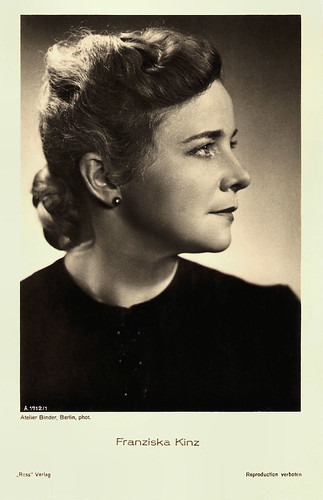
German postcard by Ross Verlag, no. A 1712/1, 1937-1938. Photo: Atelier Binder, Berlin.

German postcard by Ross Verlag, no. A 2558/1, 1939-1940. Photo: Sandau / Tobis.
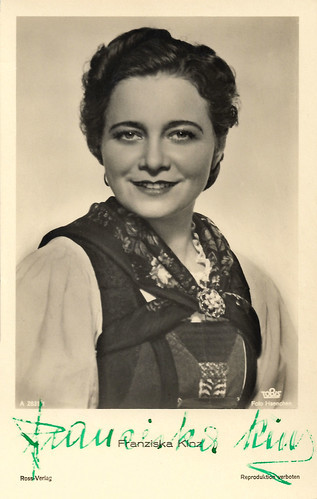
German postcard by Ross Verlag, no. A 2831/1, 1939-1940. Photo: Haenchen / Tobis.
Engaged with an opponent of the NS regime
Franziska Amalia Kinz was born in 1897 in Kufstein, Austria-Hungary (now Austria).
In 1924, she studied with Fritz Basil. After 4 months, he gave her a job at the Staatstheater in Munich. In 1929, Franziska Kinz made her first film, Das Tagebuch einer Verlorenen/Diary of a Lost Girl (G.W. Pabst, 1929), with Louise Brooks .
Her first sound film was the Swedish-German drama Väter und Söhne/Father and Son (Victor Sjöström, 1930) with Rudolf Rittner and Martin Herzberg. A separate Swedish-language film was released the following year.
In 1930, she played on stage in Darmstadt, and in 1933, at the Kammerspielen in Berlin and the Deutschen Theater in Berlin. Later followed engagements in Vienna and Munich.
Kinz was engaged with the politician and opponent of the NS regime Carlo Mierendorff. When he was put into a concentration camp in 1933 and later into prison, their ways were separated. Franziska married with a regime loyal journalist. Still, Kinz spoke up for Mierendorff's release which became a fact in 1938. Carlo Mierendorff died in a bunker during an air raid in 1943.
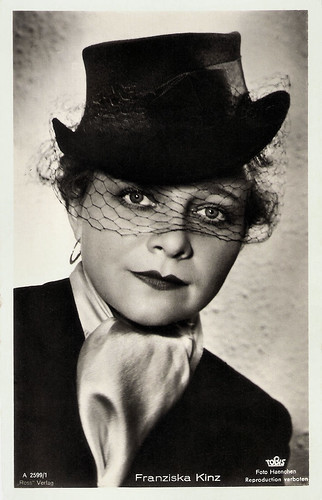
German postcard by Ross Verlag, no. A 2599/1, 1939-1940. Photo: Haenchen / Tobis.
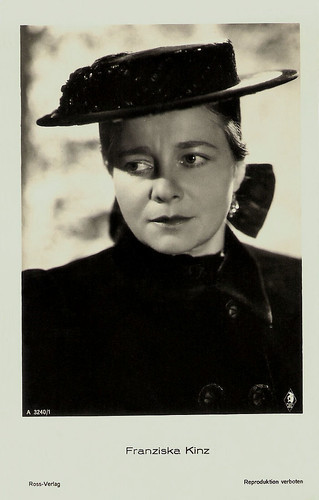
German postcard by Ross Verlag, no. A 3240/1, 1941-1944. Photo: Bavaria Filmkunst.
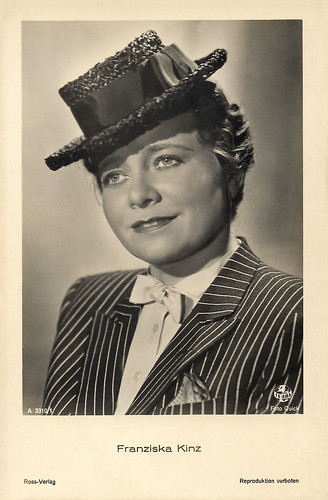
German postcard by Ross Verlag, no. A 3310/1, 1941-1944. Photo: Quick / Terra.
A scene-by-scene English language remake
Franziska Kinz played a supporting part in the drama Rasputin, Dämon der Frauen/Rasputin, Demon with Women (Adolf Trotz, 1932) starring Conrad Veidt . It portrays the influence wielded by Grigori Rasputin over the Russian Royal Family around the time of the First World War.
Another supporting part followed in the Swiss-German war film Tannenberg (Heinz Paul, 1932) starring Hans Stüwe and Käthe Haack . The film is based on the 1914 Battle of Tannenberg during the First World War. It cost over half a million Reichsmark to make and employed 8,000 people.
Another supporting part followed in the drama Mazurka (Willi Forst, 1935) starring Pola Negri as a woman, who is put on trial for murdering a predatory musician. It was partly shot on location in Warsaw. The film was made by Cine-Allianz whose Jewish owners Arnold Pressburger and Gregor Rabinovitch were dispossessed during the pre-production of the film.
Warner Brothers Studios acquired the U.S. distribution rights of the successful film but shelved the film in favour of its own scene-by-scene English language remake, Confession (Joe May, 1937), which starred Kay Francis.
During the Second World War, Kinz starred in Die Kellnerin Anna/The Waitress Anna (Peter Paul Brauer, 1941) with Elfriede Datzig as her daughter. She also appeared in the drama Nora (Harald Braun, 1944), starring Luise Ullrich , and an adaptation of Henrik Ibsen's play 'A Doll's House'.
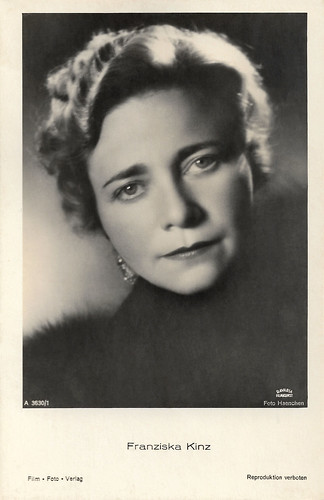
German postcard by Film-Foto-Verlag, no. A 3630/1, 1941-1944. Photo: Haenchen / Bavaria Filmkunst.
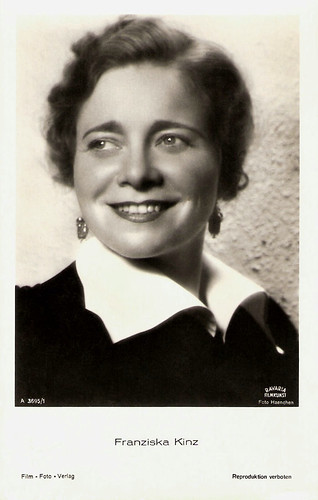
German postcard by Film-Foto-Verlag, no. A 3695/1, 1941-1944. Photo: Haenchen / Bavaria Filmkunst.
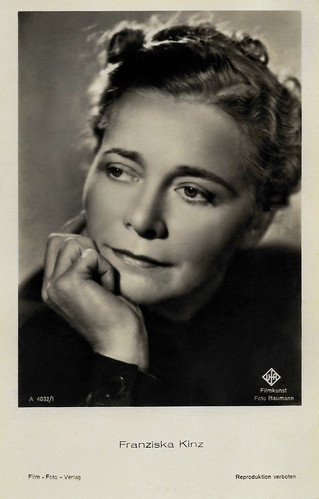
German postcard by Film-Foto-Verlag, no. A 4032/1, 1941-1944. Photo: Baumann / Ufa Filmkunst.
A cow called Daisy
Franziska Kinz was able to continue her career successfully after the war and experienced especially in the 1950s a very busy decade.
She had the female lead in the Heimat film Der Geigenmacher von Mittenwald/The Violin Maker of Mittenwald (Rudolf Schündler, 1950) opposite Willy Rösner and Paul Richter .
She also appeared in the French-Italian box office hit La Vache et le Prisonnier/The Cow and I (Henri Verneuil, 1959, starring Fernandel . It tells the story of a French prisoner of war in World War II forced to work on a farm in Germany who decides to escape by walking away with a cow he calls Marguerite (Daisy in English).
Her last screen appearance was in the TV drama Der Strohhalm/The Straw (Gerhard Klingenberg, 1964), based on a play by Eugene O'Neill. She also worked for the radio.
Franziska Kinz passed away in 1980 in Meran, Italy. She was 83.
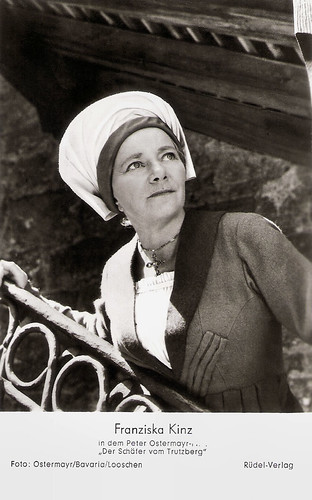
German card by Rüdel Verlag. Photo: Ostermayr / Bavaria / Looschen. Franziska Kinz in Der Schäfer vom Trutzberg/The shepherd from Trutzberg (Eduard von Borsody, 1959).
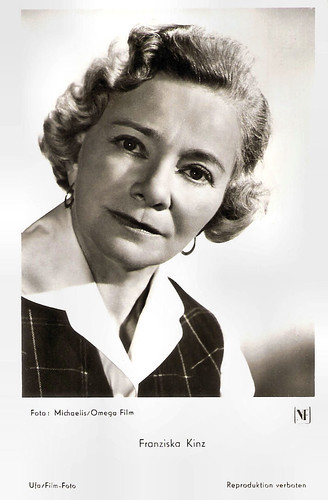
German postcard by Ufa/Film-Foto. Photo: Michaelis / Omega Film / NF. Franziska Kinz in Beichtgeheimnis/Confessional secret (Viktor Tourjansky, 1956).
Sources: (IMDb), Wikipedia (English and German), and .

German postcard by Ross Verlag, no. A 1712/1, 1937-1938. Photo: Atelier Binder, Berlin.

German postcard by Ross Verlag, no. A 2558/1, 1939-1940. Photo: Sandau / Tobis.

German postcard by Ross Verlag, no. A 2831/1, 1939-1940. Photo: Haenchen / Tobis.
Engaged with an opponent of the NS regime
Franziska Amalia Kinz was born in 1897 in Kufstein, Austria-Hungary (now Austria).
In 1924, she studied with Fritz Basil. After 4 months, he gave her a job at the Staatstheater in Munich. In 1929, Franziska Kinz made her first film, Das Tagebuch einer Verlorenen/Diary of a Lost Girl (G.W. Pabst, 1929), with Louise Brooks .
Her first sound film was the Swedish-German drama Väter und Söhne/Father and Son (Victor Sjöström, 1930) with Rudolf Rittner and Martin Herzberg. A separate Swedish-language film was released the following year.
In 1930, she played on stage in Darmstadt, and in 1933, at the Kammerspielen in Berlin and the Deutschen Theater in Berlin. Later followed engagements in Vienna and Munich.
Kinz was engaged with the politician and opponent of the NS regime Carlo Mierendorff. When he was put into a concentration camp in 1933 and later into prison, their ways were separated. Franziska married with a regime loyal journalist. Still, Kinz spoke up for Mierendorff's release which became a fact in 1938. Carlo Mierendorff died in a bunker during an air raid in 1943.

German postcard by Ross Verlag, no. A 2599/1, 1939-1940. Photo: Haenchen / Tobis.

German postcard by Ross Verlag, no. A 3240/1, 1941-1944. Photo: Bavaria Filmkunst.

German postcard by Ross Verlag, no. A 3310/1, 1941-1944. Photo: Quick / Terra.
A scene-by-scene English language remake
Franziska Kinz played a supporting part in the drama Rasputin, Dämon der Frauen/Rasputin, Demon with Women (Adolf Trotz, 1932) starring Conrad Veidt . It portrays the influence wielded by Grigori Rasputin over the Russian Royal Family around the time of the First World War.
Another supporting part followed in the Swiss-German war film Tannenberg (Heinz Paul, 1932) starring Hans Stüwe and Käthe Haack . The film is based on the 1914 Battle of Tannenberg during the First World War. It cost over half a million Reichsmark to make and employed 8,000 people.
Another supporting part followed in the drama Mazurka (Willi Forst, 1935) starring Pola Negri as a woman, who is put on trial for murdering a predatory musician. It was partly shot on location in Warsaw. The film was made by Cine-Allianz whose Jewish owners Arnold Pressburger and Gregor Rabinovitch were dispossessed during the pre-production of the film.
Warner Brothers Studios acquired the U.S. distribution rights of the successful film but shelved the film in favour of its own scene-by-scene English language remake, Confession (Joe May, 1937), which starred Kay Francis.
During the Second World War, Kinz starred in Die Kellnerin Anna/The Waitress Anna (Peter Paul Brauer, 1941) with Elfriede Datzig as her daughter. She also appeared in the drama Nora (Harald Braun, 1944), starring Luise Ullrich , and an adaptation of Henrik Ibsen's play 'A Doll's House'.

German postcard by Film-Foto-Verlag, no. A 3630/1, 1941-1944. Photo: Haenchen / Bavaria Filmkunst.

German postcard by Film-Foto-Verlag, no. A 3695/1, 1941-1944. Photo: Haenchen / Bavaria Filmkunst.

German postcard by Film-Foto-Verlag, no. A 4032/1, 1941-1944. Photo: Baumann / Ufa Filmkunst.
A cow called Daisy
Franziska Kinz was able to continue her career successfully after the war and experienced especially in the 1950s a very busy decade.
She had the female lead in the Heimat film Der Geigenmacher von Mittenwald/The Violin Maker of Mittenwald (Rudolf Schündler, 1950) opposite Willy Rösner and Paul Richter .
She also appeared in the French-Italian box office hit La Vache et le Prisonnier/The Cow and I (Henri Verneuil, 1959, starring Fernandel . It tells the story of a French prisoner of war in World War II forced to work on a farm in Germany who decides to escape by walking away with a cow he calls Marguerite (Daisy in English).
Her last screen appearance was in the TV drama Der Strohhalm/The Straw (Gerhard Klingenberg, 1964), based on a play by Eugene O'Neill. She also worked for the radio.
Franziska Kinz passed away in 1980 in Meran, Italy. She was 83.

German card by Rüdel Verlag. Photo: Ostermayr / Bavaria / Looschen. Franziska Kinz in Der Schäfer vom Trutzberg/The shepherd from Trutzberg (Eduard von Borsody, 1959).

German postcard by Ufa/Film-Foto. Photo: Michaelis / Omega Film / NF. Franziska Kinz in Beichtgeheimnis/Confessional secret (Viktor Tourjansky, 1956).
Sources: (IMDb), Wikipedia (English and German), and .
Published on November 05, 2020 22:00
November 4, 2020
Directed by Sergei Bondarchuk
Film director, co-producer, writer, and actor Sergei Bondarchuk (1920–1994) was one of the most important filmmakers of the Soviet Union and had a career that spanned over five decades. The theme of war ran through many of the films he directed. He won an Oscar for his spectacular epic Voyna i mir/War and Peace (1967), in which he also starred as Pierre Bezukhov.
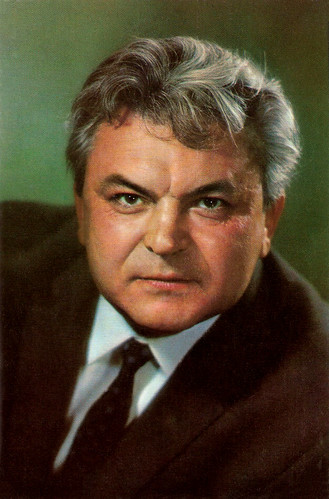
Soviet postcard, no. 72-6106, 1972. This postcard was printed in an edition of 200.000 cards. Retail price: 5 Kop.
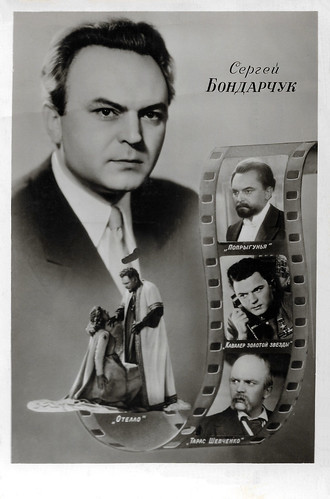
Soviet postcard, no. 4319, 1959. Retail price: 75 K. Photos: publicity stills for Otello/Othello (Sergei Yutkevich, 1956) with Irina Skobtseva, Poprygunya/The Cricket (Samson Samsonov, 1955), Kavalier zolotoy zvezdy/Cavalier of the Golden Star (Yuli Raizman, 1951), and Taras Shevchenko (Aleksandr Alov, Vladimir Naumov, Igor Savchenko, 1951).
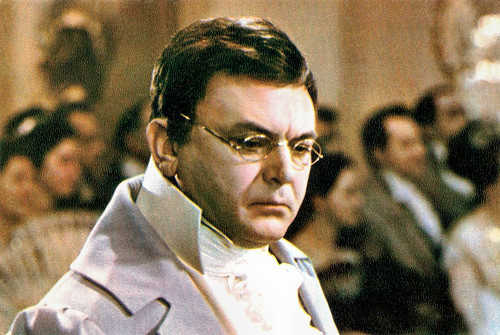
Soviet postcard, no. A 08341, 1969. Photo: publicity still for Voyna i mir/War and Peace. This postcard was printed in an edition of 500.000 cards. Retail price: 6 Kop.
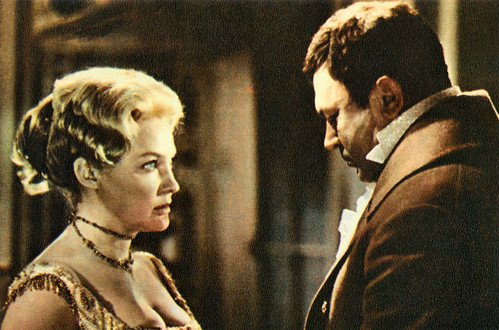
Soviet postcard by Izdanie Bjuro Propagandy Sovetskogo Kinoiskusstva, no. A 08347, 1969. Photo: Irina Skobtseva and Sergey Bondarchuk in Voyna i mir/War and Peace (Sergey Bondarchuk, 1966). This postcard was printed in an edition of 500.000 cards. Retail price: 6 Kop.
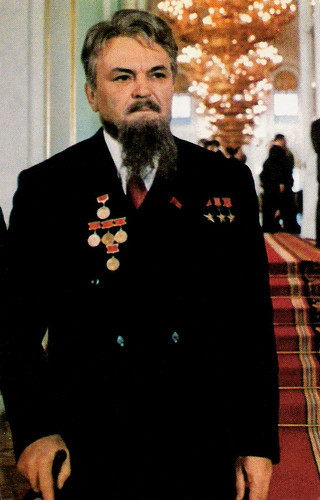
Soviet postcard, no. 109/75. Photo: Sergey Bondarchuk in Vybor tseli/Choice of Purpose (Igor Talankin, 1975). This postcard was printed in an edition of 200.000 cards. Retail price: 5 Kop.
People's Artist of the USSR
Sergei Fedorovich Bondarchuk (Russian pronunciation: Серге́й Фё́дорович Бондарчу́к; Ukrainian: Сергі́й Фе́дорович Бондарчу́к) was born in the village of Belozerka, in the Kherson Governorate, Ukraine (now Bilozerka, Kherson Oblast, Ukraine) in 1920. Bondarchuk spent his childhood in Southern Ukraine, then in Southern Russia in the cities of Yeysk and Taganrog.
Young Bondarchuk was fond of theatre and books by such authors as Anton Chekhov and Leo Tolstoy. As a schoolboy in Taganrog, he made his acting debut in 1937 on the stage of the Chekhov Drama Theatre. From 1938 on he studied at the Rostov-on-Don theater school.
In 1942 his studies were interrupted by the Nazi invasion during WWII. Bondarchuk was recruited for the Red Army to fight against Nazi Germany and served for four years. After being discharged from the army in 1946, he studied under Sergei Gerasimov at the acting department at the All-Union State Institute of Cinematography (VGIK) in Moscow.
In 1948 he made his film debut in the war drama Povest o nastoyashchem cheloveke/Story of a Real Man (Aleksandr Stolper, 1949) then co-starred in another war drama Molodaya gvardiya/The Young Guard (Sergei Gerasimov, 1949). In 1949 he married actress Inna Makarova. They had two children, including the actress Natalya Bondarchuk, but they divorced in 1956.
For his title role in Taras Shevchenko (Aleksandr Alov, Vladimir Naumov, Igor Savchenko, 1952), Bondarchuk won the Stalin Prize and was also designated People's Artist of the USSR. At the age of 32, he was the youngest Soviet actor ever to receive this honour. Then he played the title role in the internationally renowned adaptation of William Shakespeare's Otello/Othello (Sergei Yutkevich, 1956). Irina Skobtseva appeared opposite him as Desdemona, and four years later, the two actors married.
Bondarchuk expressed his own experience as a soldier of WWII when he starred in Sudba cheloveka/Destiny of a Man (Sergei Bondarchuk, 1959) about an ordinary, unheroic soldier struggling to survive in a German POW camp. He had played the role before in a televised version of a short story by Mikhail Sholokhov, but he was so unhappy with the result that he decided to direct a film version himself. His compelling performance and internationally acclaimed directorial debut earned him the top prize at that year's Moscow Film Festival and the Lenin Prize of the USSR in 1960.
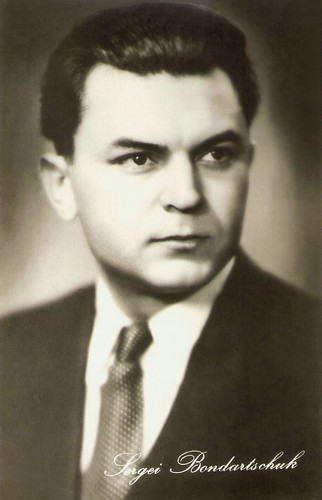
East-German postcard by VEB Progress Film-Vertrieb, Berlin, no. 201, 1957. Photo: Sovexportfilm. Retail price was 0,20 DM.
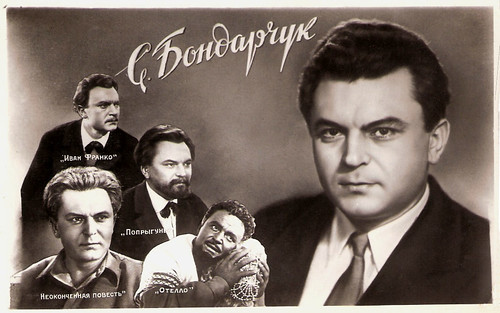
Soviet postcard by Molot, no. 34, 1959. This postcard was printed in an edition of 75.000 cards. Retail price: 75 K.
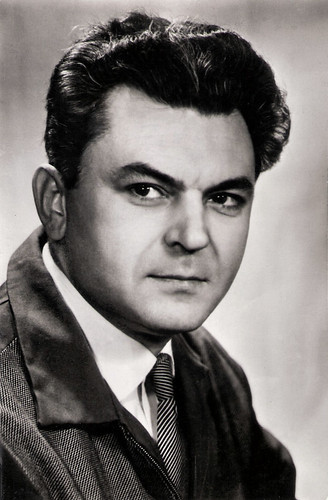
Soviet postcard by Fotostudnja Izogiza, Moscow, 1960. Photo: M. Trahmana. This postcard was printed in an edition of 30,000 cards. The price was 75 K.
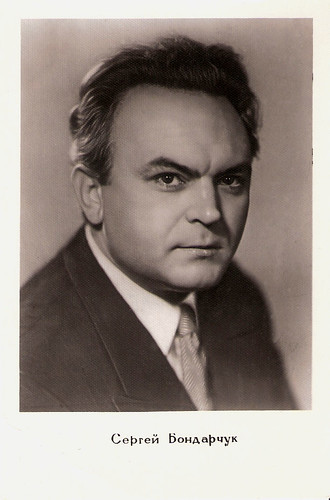
Soviet postcard, no. 46302, 1961. This postcard was printed in an edition of 200.000 cards. Retail price: 75 K.
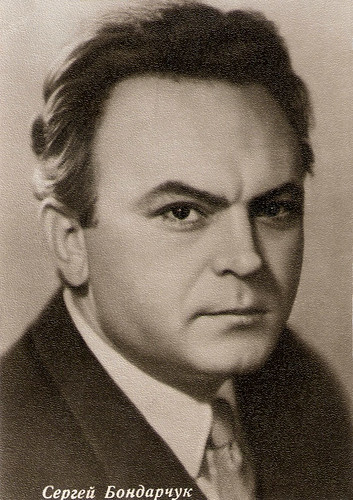
Soviet postcard by Izdanie Bjuro Propagandy Sovetskogo KinoiskusstvaI, Leningrad, no. M-15916 7/I, 1964. The retail price was 8 Kop. The circulation was 150,000.
Tens of thousands of extras
Sergei Bondarchuk shot to international fame with the astonishing epic Voyna i mir/War and Peace (Sergei Bondarchuk, 1965-1967), based on the famous novel by Leo Tolstoy. He both directed and played Pierre Bezukhov opposite a very impressive Lyudmila Savelyeva as Natasha Rostova.
The film took seven years to complete (from 1961 till 1968) and on the original release, it totaled more than ten hours of cinema. The Russian release was in two mammoth parts, totaling 507 minutes. For the US cinemas, the film was edited in four parts with a total of seven hours. The production involved over three hundred professional actors from several countries and also tens of thousands of extras from the Red Army in the filming of the 3rd two-hour-long episode about the historic Battle of Borodino against Napoleon's invasion.
The film was shot in 70mm wide-screen and color and Bondarchuk made history by introducing several remote-controlled cameras that were moving on 300 meter long wires above the scene of the battlefield. Remarkable were also his extensive pans, sometimes 360 degrees. With an estimated cost of $100,000,000 (over $800,000,000 adjusted for inflation in 2010, according to Steve Shelokhonov at IMDb ), it was the most expensive project in film history. It won Bondarchuk the Academy Award for Best Foreign Language Film in 1969, and a reputation of one of the finest directors of his generation.
After this victory, he starred with Yul Brynner , Hardy Krüger, Sylva Koscina , and Orson Welles in the Yugoslav epic Bitka na Neretvi/Battle of Neretva (Veljko Bulajic, 1969).
Although he was now the most awarded actor and director in the Soviet Union, he was not a member of the Soviet Communist Party. Soon Bondarchuk received an official recommendation to join it. To prevent running into hurdles with the Soviet government, he joined the Party in 1970. A year later, he was appointed president of the Union of Cinematographers, a semi-government post in the Soviet system of politically controlled culture. In 1970 he also began teaching drama at VGIK while continuing to direct and act.
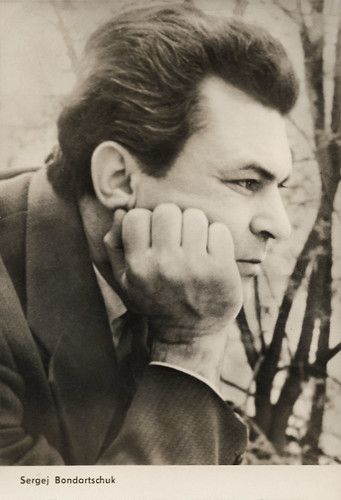
East-German postcard by VEB Progress Film-Vertrieb, Berlin, no. 2743, 1966.
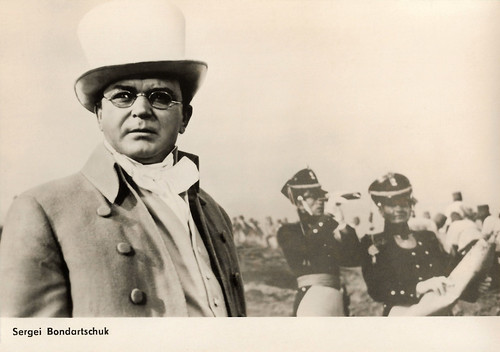
East-German postcard by VEB Progress Film-Vertrieb, Berlin, no. 3050, 1968. Photo: Sergey Bondarchuk in Voyna i mir/War and Peace (Sergey Bondarchuk, 1966).
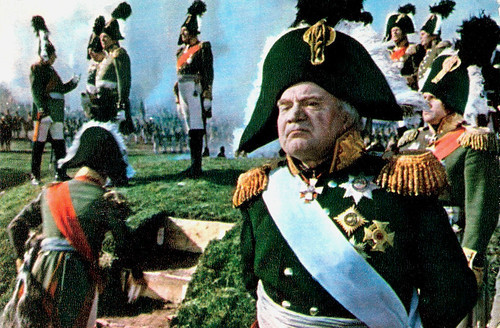
Soviet postcard, no. A 08359, 1969. Photo: publicity still for Voyna i mir/War and Peace. This postcard was printed in an edition of 500.000 cards. Retail price: 6 Kop.
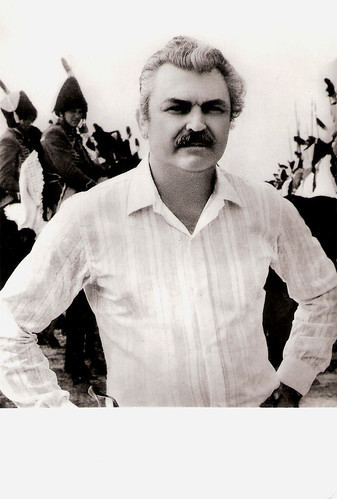
Hungarian postcard. Photo: Sergey Bondarchuk on the film set of Waterloo (Sergey Bondarchuk, 1970).
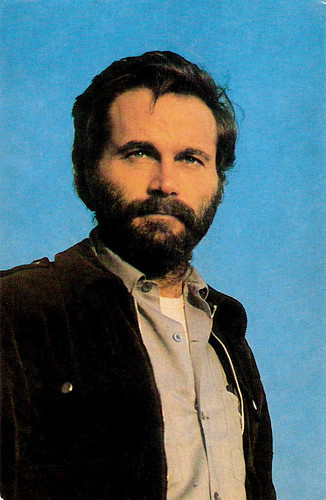
Franco Nero. Russian postcard, no. 109/76, 1976. Price: 5 Kop. Photo: N. Slezingera.
A symbol of conservatism
Sergei Bondarchuk’s first English language film was the big-budget Russian-Italian co-production Waterloo (Sergei Bondarchuk, 1970), co-produced by Dino De Laurentiis. In the cast were Rod Steiger as Napoleon, Christopher Plummer, Jack Hawkins , and several Russian actors including Sergo Zaqariadze, Yevgeni Samojlov, and Oleg Vidov . Orson Welles made a cameo as the old King Louis XVII of France. The result was remarkable for its masterly reconstruction of the final battle of Napoleon, but the film failed at the box office although it got favourable reviews.
In 1975 Bondarchuk directed another war drama, Oni srazhalis za rodinu/They Fought for Their Country (Sergei Bondarchuk, 1975) with Vasili Shukshin, which was entered into the Cannes Film Festival. Then followed the two-part Krasnye kolokola/Red Bells (Sergei Bondarchuk, 1982-1983) starring Franco Nero and Ursula Andress . This chronicle about the 1917 Russian Revolution was based on Ten Days that Shook the World, by American journalist John Reed, who had been portrayed a year earlier by Warren Beatty in Reds (Warren Beatty, 1981).
Bondarchuk’s next film, Boris Godunov (Sergei Bondarchuk, 1986) based on the play by Alexander Pushkin, was also screened at Cannes, but the cultural climate had changed. It was now the time of the liberalisation of the Soviet Union under Mikhail Gorbachev. In the Russian cinema, Bondarchuk had become a symbol of conservatism.
Steve Shelokhonov writes at IMDb that through the 1970s and 1980s Bondarchuk had "evolved into a politically controlled figure and turned to making such politically charged films". So he was voted out as president of the Union of Cinematographers in 1986.
Bondarchuk's last feature film was an epic TV version of Tikhiy Don/Quiet Flows the Don (Sergei Bondarchuk, 2006) based on the eponymous novel by Nobel Prize winner Mikhail Sholokhov, starring Rupert Everett . It was filmed in 1992-1993 but premiered on Russian television only in November 2006. At the end of filming, just before post-production, Bondarchuk learned about unfavorable clauses in his contract. It led to a bitter dispute with the producers over the rights to the film. Amidst this legal battle, the production was stopped and the film remained unedited in a bank vault, even after his death.
Sergei Bondarchuk suffered a heart attack in 1994 and died in Moscow at the age of 74. His death caused considerable mourning in Russia. Bondarchuk was survived by his second wife, actress Irina Skobtseva and their children, actress Alyona Bondarchuk, and actor/director Fyodor Bondarchuk. His eldest daughter, actress Natalya Bondarchuk is best known for her role in Andrei Tarkovsky's masterpiece Solaris (1972).
His son, Fyodor Bondarchuk who had appeared with him in Boris Godunov (1986), dedicated his directorial debut, 9 rota/The 9th Company (Fyodor Bondarchuk, 2005) to his father. The film is set in war-torn Afghanistan, whereas Sergei's directorial debut was set in WWII. In 2007, his ex-wife Inna Makarova unveiled a bronze statue of Sergei Bondarchuk in his native Yeysk.
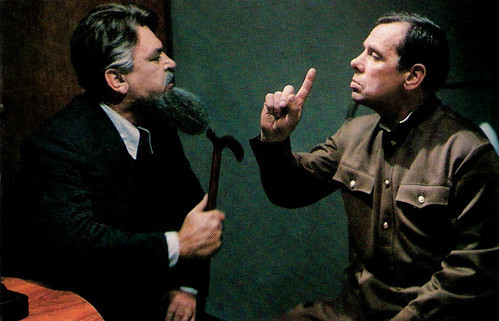
Soviet postcard, no. 109/75. Photo: Sergey Bondarchuk and Georgi Zhzhyonov in Vybor tseli/Choice of Purpose (Igor Talankin, 1975). This postcard was printed in an edition of 200.000 cards. Retail price: 5 Kop.
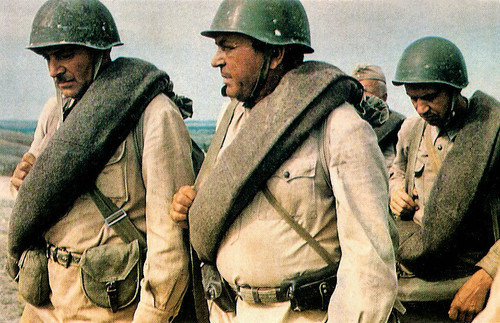
Soviet postcard, no. 109/76. Photo: Sergey Bondarchuk and Vyacheslav Tikhonov in Oni srazhalis za rodinu/They Fought for Their Country (Sergey Bondarchuk, 1975). This postcard was printed in an edition of 300.000 cards. Retail price: 5 Kop.
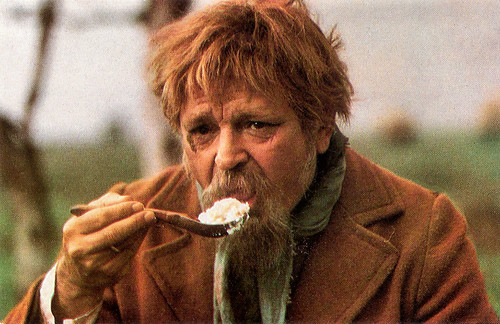
Soviet postcard. Sergey Bondarchuk in Step/The Steppe (Sergey Bondarchuk, 1979).
American 2019 trailer Voyna i mir/War and Peace (1965-1967). Source: Film at Lincoln Center (YouTube).
Trailer Waterloo (1970). Source: Danios12345 (YouTube).
Sources: (IMDb), Hal Erickson (AllMovie), Encyclopaedia Brittanica, TCM, Wikipedia, and .

Soviet postcard, no. 72-6106, 1972. This postcard was printed in an edition of 200.000 cards. Retail price: 5 Kop.

Soviet postcard, no. 4319, 1959. Retail price: 75 K. Photos: publicity stills for Otello/Othello (Sergei Yutkevich, 1956) with Irina Skobtseva, Poprygunya/The Cricket (Samson Samsonov, 1955), Kavalier zolotoy zvezdy/Cavalier of the Golden Star (Yuli Raizman, 1951), and Taras Shevchenko (Aleksandr Alov, Vladimir Naumov, Igor Savchenko, 1951).

Soviet postcard, no. A 08341, 1969. Photo: publicity still for Voyna i mir/War and Peace. This postcard was printed in an edition of 500.000 cards. Retail price: 6 Kop.

Soviet postcard by Izdanie Bjuro Propagandy Sovetskogo Kinoiskusstva, no. A 08347, 1969. Photo: Irina Skobtseva and Sergey Bondarchuk in Voyna i mir/War and Peace (Sergey Bondarchuk, 1966). This postcard was printed in an edition of 500.000 cards. Retail price: 6 Kop.

Soviet postcard, no. 109/75. Photo: Sergey Bondarchuk in Vybor tseli/Choice of Purpose (Igor Talankin, 1975). This postcard was printed in an edition of 200.000 cards. Retail price: 5 Kop.
People's Artist of the USSR
Sergei Fedorovich Bondarchuk (Russian pronunciation: Серге́й Фё́дорович Бондарчу́к; Ukrainian: Сергі́й Фе́дорович Бондарчу́к) was born in the village of Belozerka, in the Kherson Governorate, Ukraine (now Bilozerka, Kherson Oblast, Ukraine) in 1920. Bondarchuk spent his childhood in Southern Ukraine, then in Southern Russia in the cities of Yeysk and Taganrog.
Young Bondarchuk was fond of theatre and books by such authors as Anton Chekhov and Leo Tolstoy. As a schoolboy in Taganrog, he made his acting debut in 1937 on the stage of the Chekhov Drama Theatre. From 1938 on he studied at the Rostov-on-Don theater school.
In 1942 his studies were interrupted by the Nazi invasion during WWII. Bondarchuk was recruited for the Red Army to fight against Nazi Germany and served for four years. After being discharged from the army in 1946, he studied under Sergei Gerasimov at the acting department at the All-Union State Institute of Cinematography (VGIK) in Moscow.
In 1948 he made his film debut in the war drama Povest o nastoyashchem cheloveke/Story of a Real Man (Aleksandr Stolper, 1949) then co-starred in another war drama Molodaya gvardiya/The Young Guard (Sergei Gerasimov, 1949). In 1949 he married actress Inna Makarova. They had two children, including the actress Natalya Bondarchuk, but they divorced in 1956.
For his title role in Taras Shevchenko (Aleksandr Alov, Vladimir Naumov, Igor Savchenko, 1952), Bondarchuk won the Stalin Prize and was also designated People's Artist of the USSR. At the age of 32, he was the youngest Soviet actor ever to receive this honour. Then he played the title role in the internationally renowned adaptation of William Shakespeare's Otello/Othello (Sergei Yutkevich, 1956). Irina Skobtseva appeared opposite him as Desdemona, and four years later, the two actors married.
Bondarchuk expressed his own experience as a soldier of WWII when he starred in Sudba cheloveka/Destiny of a Man (Sergei Bondarchuk, 1959) about an ordinary, unheroic soldier struggling to survive in a German POW camp. He had played the role before in a televised version of a short story by Mikhail Sholokhov, but he was so unhappy with the result that he decided to direct a film version himself. His compelling performance and internationally acclaimed directorial debut earned him the top prize at that year's Moscow Film Festival and the Lenin Prize of the USSR in 1960.

East-German postcard by VEB Progress Film-Vertrieb, Berlin, no. 201, 1957. Photo: Sovexportfilm. Retail price was 0,20 DM.

Soviet postcard by Molot, no. 34, 1959. This postcard was printed in an edition of 75.000 cards. Retail price: 75 K.

Soviet postcard by Fotostudnja Izogiza, Moscow, 1960. Photo: M. Trahmana. This postcard was printed in an edition of 30,000 cards. The price was 75 K.

Soviet postcard, no. 46302, 1961. This postcard was printed in an edition of 200.000 cards. Retail price: 75 K.

Soviet postcard by Izdanie Bjuro Propagandy Sovetskogo KinoiskusstvaI, Leningrad, no. M-15916 7/I, 1964. The retail price was 8 Kop. The circulation was 150,000.
Tens of thousands of extras
Sergei Bondarchuk shot to international fame with the astonishing epic Voyna i mir/War and Peace (Sergei Bondarchuk, 1965-1967), based on the famous novel by Leo Tolstoy. He both directed and played Pierre Bezukhov opposite a very impressive Lyudmila Savelyeva as Natasha Rostova.
The film took seven years to complete (from 1961 till 1968) and on the original release, it totaled more than ten hours of cinema. The Russian release was in two mammoth parts, totaling 507 minutes. For the US cinemas, the film was edited in four parts with a total of seven hours. The production involved over three hundred professional actors from several countries and also tens of thousands of extras from the Red Army in the filming of the 3rd two-hour-long episode about the historic Battle of Borodino against Napoleon's invasion.
The film was shot in 70mm wide-screen and color and Bondarchuk made history by introducing several remote-controlled cameras that were moving on 300 meter long wires above the scene of the battlefield. Remarkable were also his extensive pans, sometimes 360 degrees. With an estimated cost of $100,000,000 (over $800,000,000 adjusted for inflation in 2010, according to Steve Shelokhonov at IMDb ), it was the most expensive project in film history. It won Bondarchuk the Academy Award for Best Foreign Language Film in 1969, and a reputation of one of the finest directors of his generation.
After this victory, he starred with Yul Brynner , Hardy Krüger, Sylva Koscina , and Orson Welles in the Yugoslav epic Bitka na Neretvi/Battle of Neretva (Veljko Bulajic, 1969).
Although he was now the most awarded actor and director in the Soviet Union, he was not a member of the Soviet Communist Party. Soon Bondarchuk received an official recommendation to join it. To prevent running into hurdles with the Soviet government, he joined the Party in 1970. A year later, he was appointed president of the Union of Cinematographers, a semi-government post in the Soviet system of politically controlled culture. In 1970 he also began teaching drama at VGIK while continuing to direct and act.

East-German postcard by VEB Progress Film-Vertrieb, Berlin, no. 2743, 1966.

East-German postcard by VEB Progress Film-Vertrieb, Berlin, no. 3050, 1968. Photo: Sergey Bondarchuk in Voyna i mir/War and Peace (Sergey Bondarchuk, 1966).

Soviet postcard, no. A 08359, 1969. Photo: publicity still for Voyna i mir/War and Peace. This postcard was printed in an edition of 500.000 cards. Retail price: 6 Kop.

Hungarian postcard. Photo: Sergey Bondarchuk on the film set of Waterloo (Sergey Bondarchuk, 1970).

Franco Nero. Russian postcard, no. 109/76, 1976. Price: 5 Kop. Photo: N. Slezingera.
A symbol of conservatism
Sergei Bondarchuk’s first English language film was the big-budget Russian-Italian co-production Waterloo (Sergei Bondarchuk, 1970), co-produced by Dino De Laurentiis. In the cast were Rod Steiger as Napoleon, Christopher Plummer, Jack Hawkins , and several Russian actors including Sergo Zaqariadze, Yevgeni Samojlov, and Oleg Vidov . Orson Welles made a cameo as the old King Louis XVII of France. The result was remarkable for its masterly reconstruction of the final battle of Napoleon, but the film failed at the box office although it got favourable reviews.
In 1975 Bondarchuk directed another war drama, Oni srazhalis za rodinu/They Fought for Their Country (Sergei Bondarchuk, 1975) with Vasili Shukshin, which was entered into the Cannes Film Festival. Then followed the two-part Krasnye kolokola/Red Bells (Sergei Bondarchuk, 1982-1983) starring Franco Nero and Ursula Andress . This chronicle about the 1917 Russian Revolution was based on Ten Days that Shook the World, by American journalist John Reed, who had been portrayed a year earlier by Warren Beatty in Reds (Warren Beatty, 1981).
Bondarchuk’s next film, Boris Godunov (Sergei Bondarchuk, 1986) based on the play by Alexander Pushkin, was also screened at Cannes, but the cultural climate had changed. It was now the time of the liberalisation of the Soviet Union under Mikhail Gorbachev. In the Russian cinema, Bondarchuk had become a symbol of conservatism.
Steve Shelokhonov writes at IMDb that through the 1970s and 1980s Bondarchuk had "evolved into a politically controlled figure and turned to making such politically charged films". So he was voted out as president of the Union of Cinematographers in 1986.
Bondarchuk's last feature film was an epic TV version of Tikhiy Don/Quiet Flows the Don (Sergei Bondarchuk, 2006) based on the eponymous novel by Nobel Prize winner Mikhail Sholokhov, starring Rupert Everett . It was filmed in 1992-1993 but premiered on Russian television only in November 2006. At the end of filming, just before post-production, Bondarchuk learned about unfavorable clauses in his contract. It led to a bitter dispute with the producers over the rights to the film. Amidst this legal battle, the production was stopped and the film remained unedited in a bank vault, even after his death.
Sergei Bondarchuk suffered a heart attack in 1994 and died in Moscow at the age of 74. His death caused considerable mourning in Russia. Bondarchuk was survived by his second wife, actress Irina Skobtseva and their children, actress Alyona Bondarchuk, and actor/director Fyodor Bondarchuk. His eldest daughter, actress Natalya Bondarchuk is best known for her role in Andrei Tarkovsky's masterpiece Solaris (1972).
His son, Fyodor Bondarchuk who had appeared with him in Boris Godunov (1986), dedicated his directorial debut, 9 rota/The 9th Company (Fyodor Bondarchuk, 2005) to his father. The film is set in war-torn Afghanistan, whereas Sergei's directorial debut was set in WWII. In 2007, his ex-wife Inna Makarova unveiled a bronze statue of Sergei Bondarchuk in his native Yeysk.

Soviet postcard, no. 109/75. Photo: Sergey Bondarchuk and Georgi Zhzhyonov in Vybor tseli/Choice of Purpose (Igor Talankin, 1975). This postcard was printed in an edition of 200.000 cards. Retail price: 5 Kop.

Soviet postcard, no. 109/76. Photo: Sergey Bondarchuk and Vyacheslav Tikhonov in Oni srazhalis za rodinu/They Fought for Their Country (Sergey Bondarchuk, 1975). This postcard was printed in an edition of 300.000 cards. Retail price: 5 Kop.

Soviet postcard. Sergey Bondarchuk in Step/The Steppe (Sergey Bondarchuk, 1979).
American 2019 trailer Voyna i mir/War and Peace (1965-1967). Source: Film at Lincoln Center (YouTube).
Trailer Waterloo (1970). Source: Danios12345 (YouTube).
Sources: (IMDb), Hal Erickson (AllMovie), Encyclopaedia Brittanica, TCM, Wikipedia, and .
Published on November 04, 2020 22:00
Paul van Yperen's Blog
- Paul van Yperen's profile
- 13 followers
Paul van Yperen isn't a Goodreads Author
(yet),
but they
do have a blog,
so here are some recent posts imported from
their feed.



